![[Headline]](../../../technik/sonstige/headtran.gif)
![[Headline]](../../../technik/sonstige/headtran.gif)
The SPIEL 09 Games Convention at Essen / Germany22nd to 25th October 2009![[SPIEL]](../spiel2.jpg)
Prize Draw WinnersSavannah Tails Michael Sheets Agricola Package Brian Cherry Giveaway-Packages Marc Magner Carlos Couto Jose Miguel Palma Congratulations to all winners!!! Sunday, 11th of October 2009Hello everybody! While it is not yet the time to start with my daily reports from the SPIEL convention, I am happy to let you know that I will be back once again with my anual daily reports from the show. I have started to prepare my Essen-schedule, trying to identify some games which I should present in the convention week, and in a couple of days you will once again embark on a virtual voyage through the SPIEL-convention, following my footsteps and reading in-depth coverage of the new games. Some points to notice: 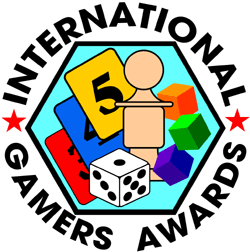 The International Gamers Awards will be presented to the winning authors and companies at an awards ceremony at the SPIEL. So, if you would like to meet people like Greg Schloesser, Mik Svellov or other members of the IGA committee (including myself), come along to Saal "Essen", a room located above the cafeteria in the convention area) for the presentation of the IGA to the winners. The awards ceremony takes place on Friday 23rd of October at 2:00 PM. This year some companies are well ahead with their publishing schedules, and so Doug Adams and me already got a first chance to check out two great games which I did not hope to see before the convention. Thus, let me recommend to you the reviews of "Modern Society" and "Endeavor", two great games which should shorten your waiting time before the SPIEL will start! And, for those of you who actually are planning to come to Essen this year: have a safe journey! "Komm', spiel mit!"(Come and play!)See you soon! Monday, 19th of October3... 2... 1... Lights on, Camera ready, Micro open... Folks, here is Essen, the boardgaming capital of Germany ! Hello everybody, and a happy welcome back for everybody who has been waiting for my anual reports to start! It's somewhat unbelievable, but once again a year has passed, and once again gamers from all around the world are on their way towards the German city of Essen, central point both in a gamer's universe and in his calendar. In a few days time the SPIEL 09, the world's biggest games convention will open its gates, and hundreds of new boardgames and cardgames will be presented to the public. So, the G@mebox is once again gearing up , getting ready for a week of reports and news from the wonderful world of boardgames! With the dreaded economic crisis keeping many industries in thrall, it seems that the crisis is missing the entertainment sector. In their last press release dating from September, Dominique Metzler and Rosemarie Geu from the convention organiser Friedhelm Merz Verlag have announced that over 550 new games are scheduled to be presented this year, and with the number of new games traditionally increasing in the last days before the show we might even have a possibility to top the 600 games borderline this year. This development in the games sector actually seems to reflect a general trend that people tend to make their home nicer and to meet with good friends. Here in Germany this trend runs under the English word "cocooning", and despite all negative trends in other industries both the entertainment and the furniture sector have done rather well since the crisis begun. However, this brings not only fun and high expectations for the visitors of the show, but reviewers like me who want to present at least a somewhat useful overview of the new games are forced more and more to select the choice of games they can present. In the last few weeks I have been scanning through the net in order to find information which games I should present, and as I have done in previous year I have prepared a first schedule of games which I intend to cover in my daily reports. Still, this only can be a first selection, since the days at the show always tend to bring up some surprising new games which I hadn't expected. Furthermore, small publishers usually only have very few tables on which their new games can be playtested, and so a day at the show cannot really be planned. Something which turns out to be extremely helpful not just for me but for every visitor of the show running on a tight schedule is the fact that many companies are releasing online documents with the rules of their upcoming games ahead of the SPIEL. Time is a precious commodity during convention days, and reading the rules ahead of the show saves explanatory time and gives visitors a possibility to quickstart a game once they could occupy a playtesting table with the desired game. And for me, the study of these online rules allows a somewhat deeper understanding of the game mechanisms when I write up my evening reports of the days at the convention.  But enough of these introductory words! I guess you are eager to see a bit of the things happening today at the convention area, and as I have done on in previous years I have left my home this afternoon, turned left and walked for 200 meters to have a first look at the buildup activities for this year's SPIEL. In the last few years we had some beautiful weather in October, and sometimes the convention halls even could open up their great gates, giving the SPIEL visitors a breath of fresh air and access to the open air courtyards. At the start of this year's convention week, the sky is looking blue again, but as it seems it will get a bit colder as usual. Still, good weather will be welcomed on the convention days by the people queuing at the ticket stalls, and so I will keep my fingers crossed that it might hold for the next few days.  Entering the convention area of Messe Essen and strolling through the first halls, I was starting to wonder: "What the heck - where are the publishers?"
Okay, the halls reserved for the small publishers usually are a bit more quite on mondays, but whereas halls 10 to 12 with the big publishers once again were active with buildup, the small publishers stalls were unusually quiet. Going down the isles, I passed booth upon booth - all still empty. But hey, down the one roll of stalls there was some activity!  Thus I came to the area with the used games flea market, and it was good to see that it has not shrunken further, but about a dozen booths actually were in the midst of unpacking their older and newer treasures. Looking over some shelves, the booths at the flea market offer a choice of games which is still quite centered on German publishers. Of course, as in former years I could see some titles from GAMES WORKSHOP and a few older cosims from SPI, VICTORY GAMES or AVALON HILL, but foreign publisher games from recent years are in the absolute minority. I guess this is mainly due to the fact that many of the publishers here at the show are German families, and so foreign visitors should not have too much hopes to find rare international titles at the flea market. Still it is a good and moderately cheap source for younger and older German games, and especially during the first day of the show there is a chance to find some of the more rare expansions to highly popular games like El Grande. 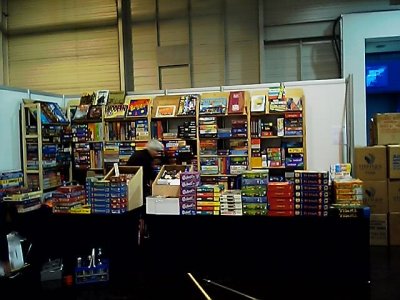 Having made up my mind to return home, all of a sudden I stumbled upon the one and only booth which was actually fully prepared, and so this year's special early bird recognition goes to KUZNIA GIER from Poland! The guys must have arrived quite early, because I had entered the convention halls at around 5 PM, and a found nobody but only the finished booth. However, there is still ample of time left, and so I guess I can show you some more pictures from buildup activities tomorrow evening. 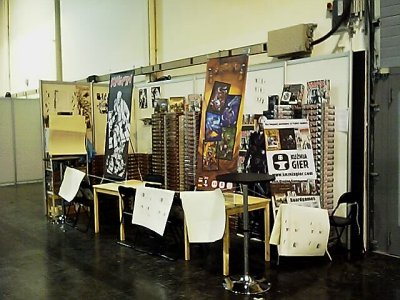 KUZNIA GIER actually has brought a game which I was looking forwards to see, and the title of this rather dark looking Mafia-game is Kingpin. The dark artwork in the game looks like it comes straight out of a Frank Miller comic book, and while these comics certainly are a matter of personal taste, the illustrations an a quick readthrough of the rules have left me curious to see how the game is like. Thus, Kingpin certainly is one of the game on my list of games to present…
Well, that's not too much news for the first day, but I hope that these few lines have warmed you up for the days to come. As indicated, there are some rather interesting-looking games which I am going to tell you about in the days to come, and I also have one or two nice surprises up in my quiver which I am going to present to you during the show. And, of course, everybody who leaves an entry in my guestbook during the convention days also will have the chance to win something in my annual PRIZE-DRAW, so stay tuned to this site in the next few days to see what prizes will be available this year! For now, just let me say:
SEE YOU AT THE SPIEL! Tuesday, 20th of OctoberHello again everybody, for another look at the halls of the Messe Essen, just a few hours before the start of the SPIEL 09 games convention! 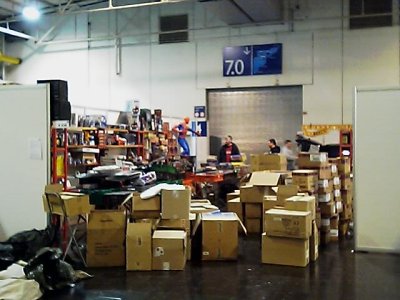 Making my way over to the convention area this early afternoon, I was hopeful to see a change of the situation I found yesterday. And indeed, non only the major publishers are finishing the works on their big playing areas, but also the smaller publishers have started to arrive. As it seems, more publishers than in previous years are leaving the final buildup right until wednesday, the final day before the show opens up for the public. However, late arrivals have been quite usual in every year, and just the same it was also quite usual that no booth remained empty. Thus, I am rather sure that tomorrow will see the halls quite active, with the late coming publishers hurrying by to get their games and equipment in.  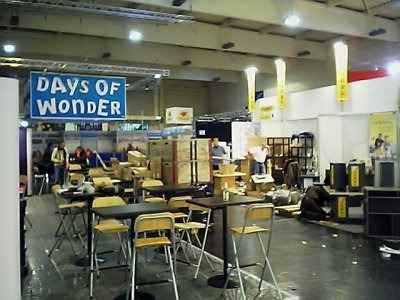 Anyhow, I started my way with a trip around the halls 10 to 12 to see how far the major publishers have proceeded, and also I was hopeful to see some decorations at the booths which actually would allow a glimpse at some of the novelties. 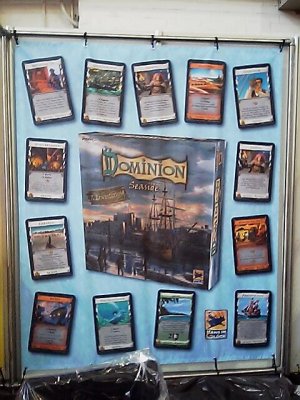 And indeed, at the booth of HANS IM GLÜCK I could see a nice poster with some images of cards and cover of the new Dominion expansion. Quite interestingly, the German version of the expansion also will bear the English name Seaside, and furthermore the somewhat eccentric story about the basic game and Intrigue receiving different covers in Germany than in the rest of the world seems to have come to an end with the new Seaside cover. 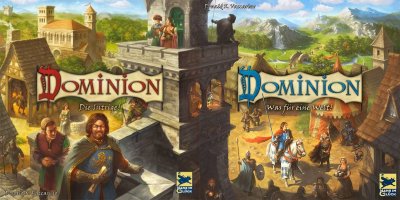 For those of you who don't know the story, just let me recap a bit on this somewhat characteristic German story. When Dominion was released by HANS IM GLÜCK last year, the first edition was sold here at the SPIEL 08 with the international cover designed by Matthias Catrein. However, with the German public reacting negatively to all kinds of wargames, the publisher actually could observe that the public saw the chosen cover to be too much warlike. It may also be the case that the people at HANS IM GLÜCK suspected a chance for Dominion to possibly win the Spiel des Jahres awards, and in the end it was decided that the cover would be replaced with a much "sweeter" drawing by Michael Menzel. However, whilst some gamers saw this cover replacement as an affront to Matthias Catrein, the new graphic line of Michael Menzel also was continued with the Intrigue box, adding another nice cover which actually would build a panoramic view together with the cover of the basic game. On the long run HANS IM GLÜCK reacted and revealed the context of their decision, and at the same time they pointed out that they did not want to debase the artistic skills of Matthias Catrein. And now, at the SPIEL 09, it seems that the story of the different covers is over, since the new expansion now once again bears the same cover as all other international editions. 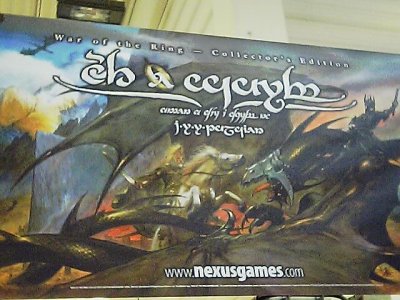 Passing a few more booths, I could also spy on some posters revealing another upcoming trend - Collector's editions. One of these highly wanted collector pieces is the War of the Ring Collector's Edition which has been announced by NEXUS for nearly three years. I had told you at the last SPIEL that the game would be released soon, and now once again I have received some hints that the game will be available for ordering in a couple of days. An indication for the approaching release also was the huge poster above the NEXUS booth, and as it looks like the rumour about the new playing components actually bearing Elvish names might be true. I also checked out the official website of PHALANX GAMES Germany this evening, and here the rumour was confirmed: 2000 copies of the Collector's Edition will be produced and shipped before the end of the year, with 500 copies in German and 1500 English copies. The game will be available for preorder at a price of 299 Euros. A steep price, but for this you will get painted miniatures, a hugged wooden gamebox, a re-designed gameboard and cards and a Hardecover rulebook. What a nice Christmas present! 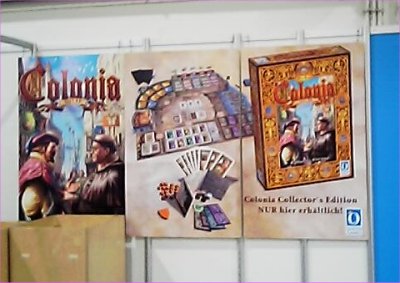 However, NEXUS is not the only company setting a trend for collector's boxes, and so QUEEN GAMES for the first time has decided to bring not only a new big-sized boardgame named Colonia to the SPIEL, but at the same time they have also produced a collector's edition which features meeples in stead of 200 (!!!) coloured wooden cubes. A nice idea, although the question might be asked why this kind of difference actually has made a collector's edition necessary. I can only guess at a difference of production costs, but economies of scale and thus a lower price at least seemed possible if they would have included meeples in all gameboxes. However, another possible motive might be the idea that a collector's edition might draw some additional buyers due to its limited availability, and such a move actually could increase sales numbers for a publisher speculating on such an effect. Taking a more or less random course, I stopped at several booths of small games retailers who were preparing their displays for the convention visitors, and chatting with several shop owners about the current market situation I discovered that I have to make some corrections to a statement I made yesterday. While it is true that the boardgames scene seems well alive and thriving, the situation for game retailers maintaining specialised stores seems to be somewhat different here in Germany. A few years ago a major electronics dealer had coined the quite successful commercial slogan "Geiz is Geil!" (broadly translates to "avarice is lustful"), and as it seems, this slogan has been taken to the heart by a major part of the German population. This has resulted in many potential buyers turning away from small retailers and shopping at huge chains or internet dealers who offer potential bargains, and even though the prices at many small retailers often are lower than those of the internet giants the public seems to be blind on this eye. Thus, as in other industries, many games retailers had a quite bad year, and so the German games scene is on the brink to lose the specialised shops in which gamers can meet and where counsel can be given whether a game would appeal to an undecided buyer. This would be a real loss to the German gaming scene, but as it seems the search for cheap bargains is a cultural disease which increases gradually and which only will be felt when things have taken a bad turn. 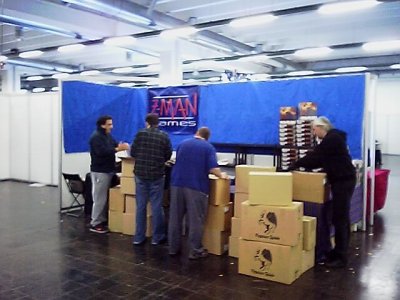 After these somewhat sobering news I made my way back to the halls containing the smaller publishers, and here it seems the world is still in order. I met Gordon and Fraser Lamont from Scotland who told me that their shipment of Savannah Tails would be arriving tomorrow morning, and I saw Zev Shlasinger from Z-MAN GAMES preparing his booth for the show. I asked Zev whether the new edition of Tales of the Arabian Nights would be available here at the show, but I received the news that the first printrun of the new version already sold out! This news got me alert and I added the game's name to my priority list of games to buy, since I was counting on getting a possibility to playtest the game here at the show. Now I actually see the need to scan some of the gamestore-stalls tomorrow in order to see whether I can still find the game somewhere. 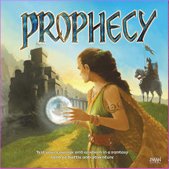 Another news I could get from Zev was concerning the expansions for the Czech Talisman-like adventure game Prophecy which was released by Z-man games in 2007. Both expansions - the Dragon Realm and the Water Realm - have seen some major redesign in the previous months, but now the design process actually is nearly finished. Thus, the expansions will go into production shortly, and Zev expects both of them to go into sale by the end of the year. 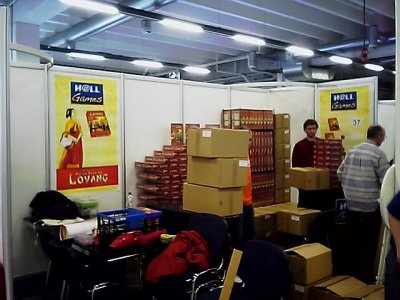 The next booth was assigned to the new German publisher HALL GAMES, and here I saw Uwer Roserberg overseeing the setup of the booth for the presentation of his new game Vor den Toren von Loyang. I asked at the booth whether the release of the game be followed with some kinds of smaller expansions like Agricola did, but here no certain answer could be given since much will depend on the fact how the new game will be received by the public. Still, a small extra is available here at the SPIEL, and so buyers of the game may spend an additional two Euros and for this they will receive two specially minted Chinese coins which serves as player's tokens in the game. 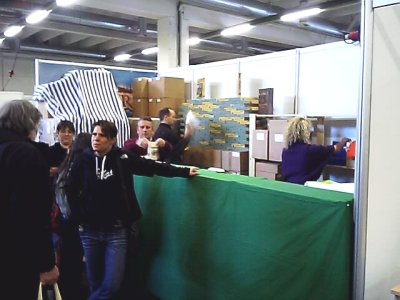 Having seen one of Uwe Rosenberg's new creations, I also wanted to see whether the new Agricola Moorbauern expansion would make it to the show, and thus I went over to LOOKOUT GAMES where I found Hanno Girke and his crew busy setting up the booth. I handed Hanno a banner from the International Gamers Awards to be displayed at the booth because Le Havre had won the awards this year, and I also had a first opportunity to look at the box of the Moorbauern which already had arrived. I also asked for the announced expansion card decks for both Agricola and Le Havre, but whereas the Czech expansion deck for Agricola will be available here at the SPIEL the new deck for Le Havre did not make it.  At the LOOKOUT GAMES booth I also met Melissa Rogerson from Australia, admin of Boardgamegeek and personal blogger with Obsessing about everything, and she has come to the convention with her whole family because she is momentarily living at the town of Wuppertal since her family is on a five-months vacation here in Germany. Melissa actually was a great help in organising some wonderful prize for this year's PRIZE DRAW, and so I am happy to announce that a packet of Agricola-goodies has been sponsored by LOOKOUT GAMES! PRIZE-DRAW!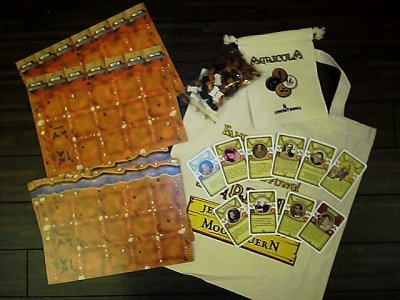 One name will be drawn from all people who will sign my SPIEL Guestbook during the days of the SPIEL 09, and the lucky winner will receive the following Agricola-Collection: 5 special limited Agricola "Wild West" gameboards, a bag containing wooden resources, a jute yarn bag for storing the resources, a big Agricola jute shopping bag, and - as a real convention special - a complete English L-Deck which features different assistants of Uwe Rosenberg and which normally must be collected as single cards here at the show! So, if you are an Agricola-fan don't miss the chance to win this great collection! 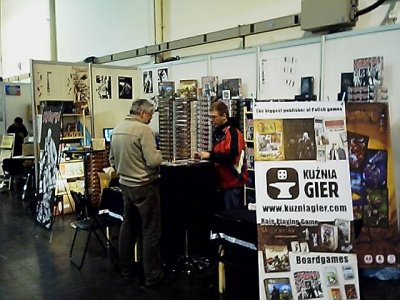 With this great prize secured I wanted to end the day, but on my way out I once again passed the booth of KUZNIA GIER where I actually found Krzysztif Szafranski and Michal Stachyra with whom I talked a bit about their new game Kingpin. Having prepared their booth yesterday, I was invited to a testing round of the game, and of course I could not resist to get some first hand experiences on a game I was longing to play. As indicated yesterday, Kingpin first attracted my attention with its rather unusual, dark-looking comic artwork. There have been a few boardgames with dealt with the theme of gangsters and the Mafia over the years, and among these titles were games like Supergang, King of Chicago or Gangster. However, none of these games looked as thoroughgoing dark and sinister as Kingpin, and so the players in this game do not lose time with any kind of cover-up business, but they enter a bloody mob-war right away. The game is a pure two-player game, but actually three different Mafia organisations are included which can be chosen by the players. Present in the game are the Italian Mafia, the Yakuza and the Russian Mafia, and each of these gangs consists of a choice of eight different gangster tiles which are handed to the player who has chosen the organisation. Three starting gangsters are sorted out by each player, and the remaining tiles are shuffled into decks from which a new tile is revealed whenever a player has brought one of his three starting tiles (or a follow-up tile) into the game. 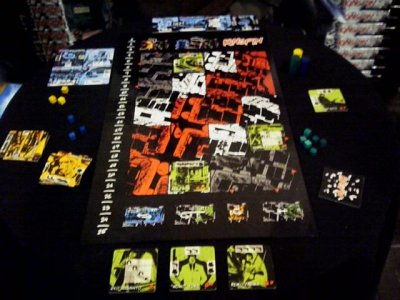 The gameboard shows a city quarter which both players try to control by means of force, and so each of the players is assigned an area of influence in which new gangsters can be placed. Between both areas of influence is no man's land, and it is the aim of the players either to occupy a space beyond the opponent's area of influence with one of their gangsters, or to gain control of no mans land by occupying it with three gangsters and removing all opposing gangsters. The whole game is governed by the turning and positioning of the gangster tiles, since it is the relative position of the tiles to each other which will determine the outcome of attacks and whether an opponent's gangster can be removed. To indicate the abilities of a gangster the game knows five different special abilities, and usually one or more ability symbols can be found on the different outer borders of each gangster tile. Thus, an ability only comes to bear against an opponent if the gangster points towards the opposing gangster with a side displaying a symbol of the desired attribute, and the amount of attribute symbols present on the gangster tile indicates the effectiveness of the gangster when using this attribute. 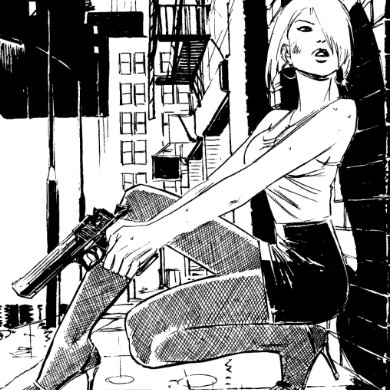 The easiest constellation here is a gun, since a gangster who points with one or more of the gun attribute symbols towards an opposing gangster on an adjacent square attacks that gangster with his attack strength equalling the number of the gun symbols. If equal or more gun symbols are used than the victim's toughness, the attacked gangster is defeated and removed from the game. However, the victim also will be checked if he actually points guns towards the attacker, and so there is a chance that the attacker may be removed as well be the simultaneous counterattack of the victim. As a matter of fact, the just given example only represents the most simple of all combat situations, and regularly combat gets much more complex due to the fact that several gangster tiles may be involved in a combat at the same time. Thus, all further opposing gangsters next to either the attacker or his victim will join in and start to shoot at the attacker or the victim as well, provided they have gun symbols turned into the right direction. These gun symbols all will add up to a grand total, and so an attack with more than one gangster actually may have a better chance to eliminate a tough gangster of the opponent. 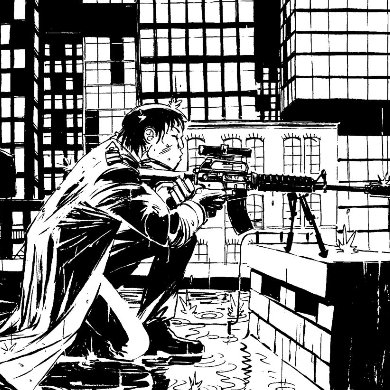 Additional help may be provided through the use of a sniper or through support symbols. The ability to act as a sniper is different from other abilities in so far as it is not printed on the outer border but in the middle of a gangster tile, and depending on the facing of the gangster it shows a map which spaces on the gameboard which the sniper is covering with his fire. An opposing gangster standing on a space within a sniper's range of fire is considered to be dealt one additional wound in case the gangster is attacked. The support symbols once again are printed on the outer border of a gangster tile, and if a border bearing such a symbol faces a friendly gangster on an adjacent square that gangster is considered to receive support, adding one gun symbol on every side of that gangster tile as long as the gangster is supported. Damage can be reduced if a gangster has one or more guard symbols on a side facing an attacker, and each guard symbol cancels out one attack symbol so that there is a chance that there are not enough gun symbols to eliminate the lucky victim. However, as you can see, a chance to survival in Kingpin most depends on the correct placement and facing of a player's gangster tiles. The rules feature a short list of actions which are available to a player during his turn, and on the one hand are the four different movement actions (placement of a new gangster tile from the player's mob, turning of a gangster tile, moving a gangster tile or exchanging positions of two adjacent, friendly gangster tiles) which can be used for adding new gangsters or moving gangsters on the gameboard. The fifth and last possible action is an attack, and this results in a combat between two adjacent gangsters of both players, with the possible involvement of additional gangsters who either join the shooting or offer support. Taking alternating turns, a player may chose one of the above actions during his turn before the other player gets a turn, and so the game quickly passes to and fro between the players. However, there might have been a risk of long stalemates with players moving their tiles back and forwards if the designers at KUZNIA GIER had not added a limit on the playing duration, and in place of Kingpin this limit is implemented by an action track featuring 25 steps. Each time a player uses his turn for a movement action means that he will have to move his token one space on the action track after his movement action, and the first player to reach the final space of the action track will loose the game because he runs out of time. An attack action does not cost time, but an attack only may be chosen if the constellation on the gameboard actually leads to the eliminating of the victim (with the possibility of additional losses for both players due to the simultaneous killing of the attacker or other involved gangsters). While variant rules actually suggest to play without the action track in order to get an even more strategic game, Kingpin draws much of its intensity from the use of the track, since there will always be a player who must fear to be the first one to reach the final space of the track. Thus, time-wasting is heavily penalized in Kingpin, and since nobody can afford the risk of the other player getting the upper hand, both players actively try to win the game by fulfilling one of the two victory conditions. 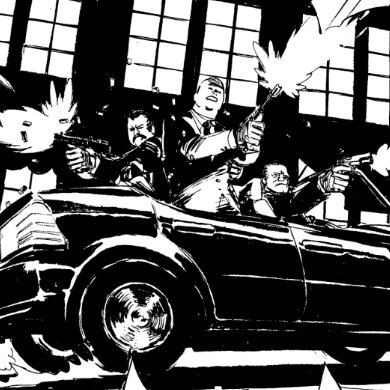 Yet not mentioned and quite nasty is the fifth and final ability which a gangster may possess, and so some of the gangster tiles feature one or more car symbols around their outer borders. The car is used for a raid, and the conduct of a raid actually is a fuse both of a movement and an attack, since a player may move and attack with the gangster used for the raid in the same turn. This allows a quick thrust out of the distance, and so a gangster with the raid ability is difficult to kill if he is facing towards an approaching attacker with gun symbols. Kingpin is merciless and brutal not only considering its background topic but also in terms of playing time and direct action. The two players' areas of influence in which they place their new gangsters are rather close to each other, and so an exchange of blows develops at in incredible pace. I have played the game three times in a row and needed less than an hour for all three rounds, and I guess that the players even get quicker once they have learned to handle the different situations in the game with more experience. Leaving the random drawing of additional gangsters aside (variant rules say that the players can chose from all eight gangsters right from the beginning), the game includes no factor of luck, but instead offers a very strategic, chesslike challenge. Considering the fitting artwork and a few additional details like the different ways in which each Mafia organisation can be operated due to shifting abilities of the gangsters, my conclusion is that Kingpin is a very good example how a set of very abstract rules still can be backed with an interesting theme. The only minor point of possible criticism I can see is not directly game related, but it is the price of 25 Euros which seems a bit steep for a gamebox containing a double-sided gameboard, 24 gangsters, 15 wooden playing pieces and a CD with a flash intro. However, for me Kingpin was a thrilling early start into the SPIEL 09, and so I took a copy home with me despite of the somewhat high price. And as I was told by the people of KUZNIA GIER, there is a possibility that the big gamebox might fill up with more playing pieces, since they have some more Mafia organisations under development. This ended my day here at the show, and I hope to see you all back tomorrow morning for the host's press conference and the opening of the news show! Wednesday, 21st of OctoberAnd here we go, after a long day at the show I finally get down to do a bit of typing. The tea is on the teapot warmer, and my wife and the cats should be sleeping. Actually, it's only my wife - the cats just have become rather fond of an old tealight, and so they do some evening hunting while I try to get out some coherent words. Wednesday always is the first real day of the show, and although visitors are not yet allowed in, many more people actually begin to show up. Thus, the first thing I saw with pleasure this morning was that despite the empty looking booths on the previous days many well-known small publishers once again have returned and were in the midst of setting up their booths. Thus, I saw the people of CZECH GAMES EDITION (CGE), Jussi Autio had returned with his TUONELA crew from Finland, and Fraser and Gordon Lamont from FRAGOR GAMES were having the most suspenseful moment of the year since they were opening the first of their box of Savannah Tails in order to check whether all parts were included and whether any misprinting happened. However, they could sit back and relax rather soon - everything was in order. 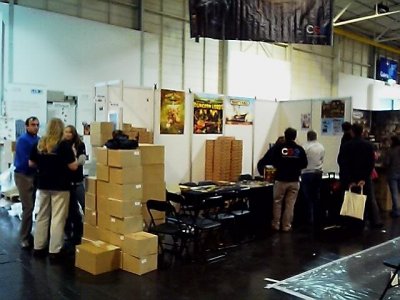 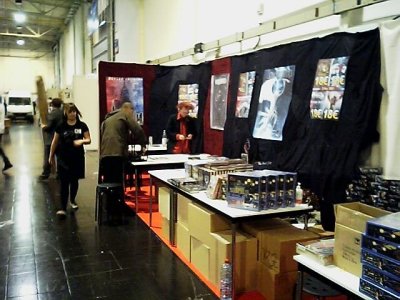 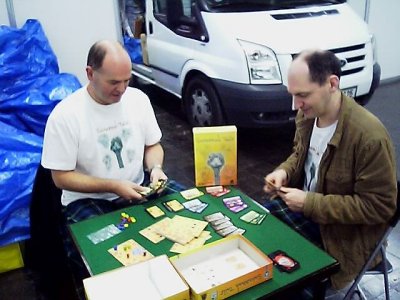 I also met our International Gamers Awards chairman Greg Schloesser and his companion James Miller who were on their first trip through the halls, and we teamed up for some time in order to have a look around together. On our way we came upon Cedrick Caumont from REPOS PRODUCTIONS, and since I was rather eager to get a first look at the new White Moon expansion for Ghost Stories we joined him on the way to the ASMODEE both where he showed us the new game. As it is tradition with the new REPOS GAMES, some Essen-specific goodies once again will be distributed together with the expansion, and so the visitors of the show actually get an additional set of villagers plus the Crazy Shaman card, and furthermore two different promo-cards also are available. The first card is Chuck No-Rice and he has been available for some time, but the second new promo card is yet another incarnation of Wu Feng, the fearful B-Rice Lee. 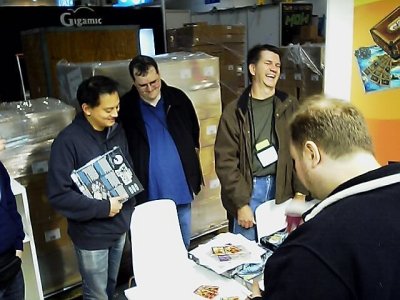 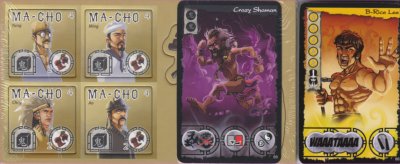 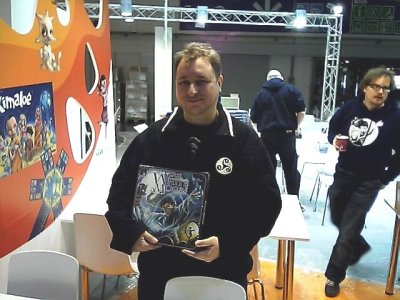 The first few hours of the morning flew by, and so the day was approaching the first official act of the day, the annual press conference which is followed by the opening of the news show where the publishers get a first chance to present their new games to the press. 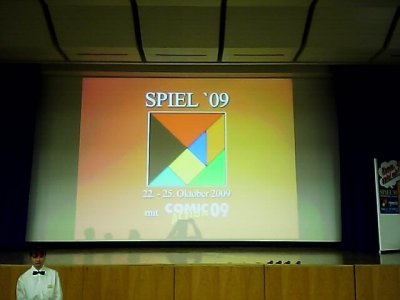 The press conference always is used by Mrs. Metzler from FRIEDHELM MERZ VERLAG as a forum where the proud facts of the show can be presented, and in its indeed the 27th SPIEL once again succeeded in breaking asome records. Thus, there is a new record of 763 publishers present at the show, and once again the participation quote of foreign publishers has risen and now comes up to 44 percent of all participating publishers. Furthermore, the trend to represent publishers coming from certain countries on a connected area also hold on, and so this years publishers from Korea and Japan both are opening a country pavilion. However, the SPIEL even could have grown more, since over 20 publishers still entered the waiting list after the official deadline, but since no additional halls could be hired it was impossible to give these publishers a stall. Still, all the publishers which are present actually bring the proud sum of over 600 new games, and so Mr. Michael Hopf of the games retailers association proudly could announce that - despite the falling profits in many industries and the bankruptcy of a major German chain of department stores - the games industry still could record a minor growth in the previous 12 months. Especially the children's games are still growing strongly with an increase of about 10 percent, and this is no wonder because the best known German opinion research center found out that the playing of games still is the most important spare time activity of German families. 35 percent of the families rank the playing of games above all other activities, leaving the watching of Television of the playing of computer games far behind. After the press conference was over, I entered the news show in order to checkout some of the new games. As in previous years the news show is a great place to meet up with some people, and furthermore it is always interesting to see what kinds of presentations some of the publishers had chosen to attract some attention to their games. 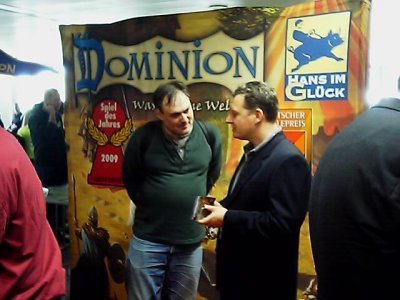 Of course, Dominion was represented on a major stage, and even author Donald X. Vaccarino (the guy in the green shirt) had decided to come over to Essen to celebrate the second major award received by Dominion this year. He had never been to the SPIEL before, and as it seems he looked at the masses streaming into the news show with a slight shock, but he was quickly surrounded by the crowd and became part of the proceedings.  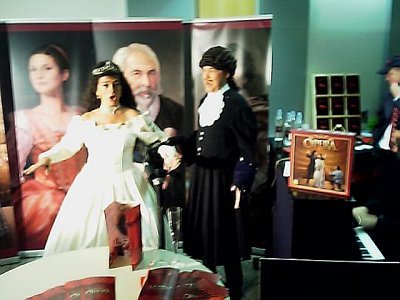 Another publisher who always has nice presentations is GOLDSIEBER, but this year the biggest show actually was put up by HUCH & FRIENDS with their new game Opera. With the rather unusual background topic, the publisher had decided to do something extraordinary, and so they had brought two real opera singers and a piano to the news show, entertaining a bigger crowd with some popular arias. 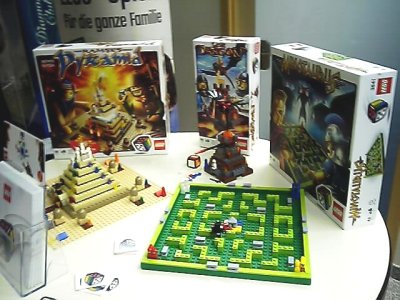 The activity on the games market also did not went unnoticed by the rest of the games industry, and so the toys giant LEGO actually tries to develop new marketing opportunities. They have come to Essen this year with a total of 10 LEGO-boardgames, with the gameboards and all playing components made of LEGO-pieces. Pyramid's of the Minotaur's Labyrinth - everything is possible and can be set up by the players in different ways, and even the dice can be customized since different kinds of faces can be attached to a LEGO dice. 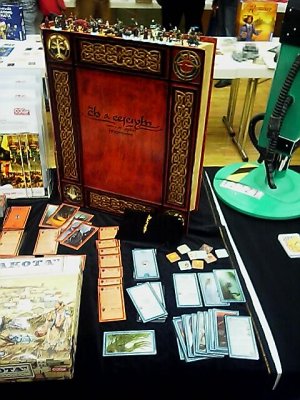 A rumor which I had told you about yesterday actually was confirmed by the people from NEXUS GAMES. Thus, the new War of the Rings Collector's Edition really will be available this fall, and the first 1000 games which are ordered will be shipped before Christmas. The game will feature the components I told you about yesterday, and especially the game map will be quite overwhelming since length and height both were be expanded by about 30 percent, and a totally new artwork for the board was designed by the famous Tolkien artist John Howe. Even more important, they had decided to go for an even better quality of miniature painting, and the figures which were on display really were quite nice to look at. I tried to do picture of the figures, but back at home I saw that my use of a flashlight really was counterproductive, and so I will not show a picture for the moment because it would not do the figures justice. Thus, I can just tell you that they now have gone for a uniform base colour for the good and evil forces, but the outer borders of the bases have been coloured differently. Furthermore, the wobbling eight Nazgul figures have been replaced by smaller miniatures, and so the constant twisting of the figures in order to stand up also is history. The news show actually also is a good place to pick up some first hand news about the fact which games will have made it for Essen and which will still arrive during the show, and here I heard some news which were a bit sad for me and surely will be for some other visitors. Thus, I was really looking forwards to see the splendid looking miniatures in the new MATAGOT game Cyclades, but as it seems they were facing production difficulties in China, and so the game will be available in Essen just with meeples and not with miniatures. The miniatures will come at a later point, and I was told that they would be shipped for free to all buyers of Cyclades. Some other games also have not made it to the SPIEL 09, and amongst these is the announced Space Alert Expansion. I had a chat with Petr Murmak from CGE, and he told me that the expansion is nearly ready but that they wanted to playtest it a bit more to give it a final quality check before its release. I followed Petr to the CGE booth and was shown a prototype of the expansion, and it will contain some nasty new threats which will force the players to cooperate even further. In addition, the expansion also will contain double action cards for a specialist variant with even more threats, and a set of special ability cards both will add campaign and RPG elements to the game, since the players now have the possibility to learn special skills, and if they want they can even try to act and speak according to their role. Sound good, doesn't it? And we won't have to wait too long, since CGE plans to release the expansion in January 2010. 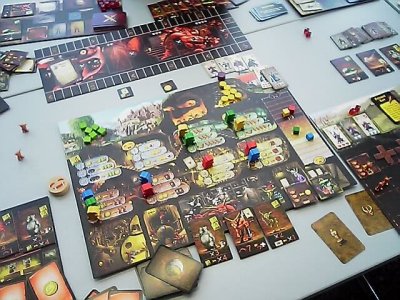 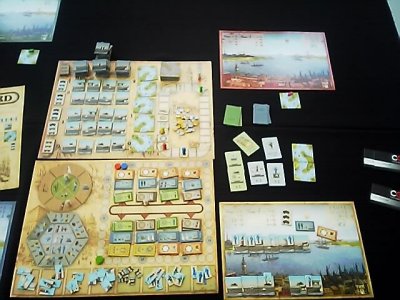 However, CGE had brought two announced new games to the show, and these games are the cute-looking Dungeon Lords and Shipyard (Die Werft). Especially Dungeon Lords by Vlaada Chvatil has been much awaited, and a first look at the playing components actually made me hungy to learn more about the game in the next days. This time the players will impersonate the keepers of a nice and friendly dungeon full of friendly creatures which will be molested by vexatious heroes, and so the cute amalgamation of creatures which populates the dungeon (and who looks like they came just out of the Disney movie "Monsters Inc.") all must stick together in order to rescue their beloved dungeon from being explored. After a late lunch break at home I returned to the show barely before 4:00 PM, and so I arrived just in time for the traditional reception organised by the Lamont family to celebrate the release of their new game. 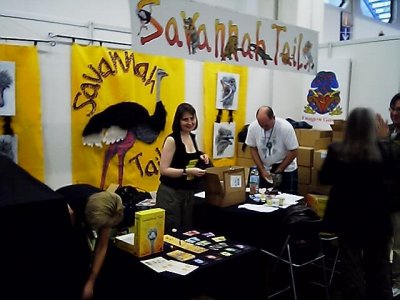 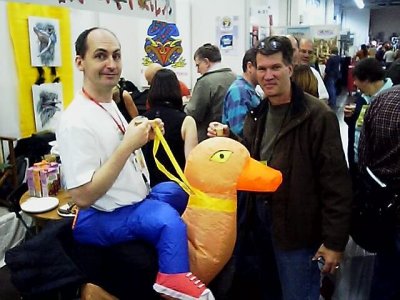 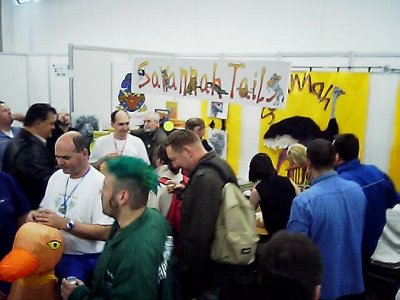 Knowing the Gordon and Fraser always are up for a good joke I was curious to see what they could have thought of to present a game about ostrich racing. I have thought of some possibilities, but I never would have imagined to see both of them posing as ostrich racers. These inflatable ostrich costumes were absolutely hilarious, and they attracted a great laugh from the gathered crowd. 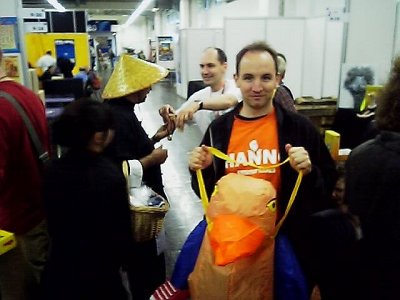 Even Hanno Girke from LOOKOUT GAMES seemed envious, because Agricola does not actually contain these sporting animals, and so he finally could convince Fraser to lend him his trusty animal for a trip around the show. 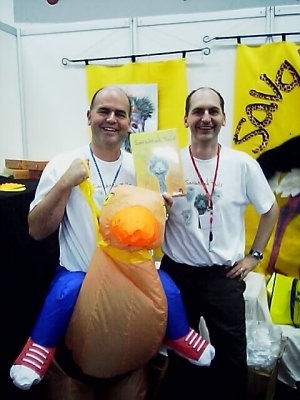 However, Fraser and Gordon also thought that they should share some of the fun with my readers, and so I am happy to announce that they have sponsored a copy of Savannah Tails for my PRIZE DRAW! A big thanks to the great two Scottish lads from this point, and those of you who would like to get a chance to win one of the games better should sign my SPIEL Guestbook! 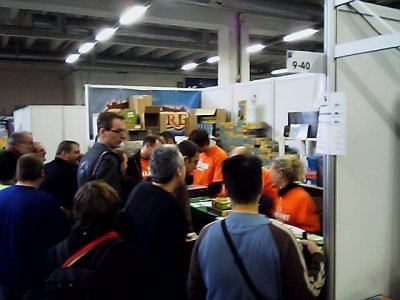 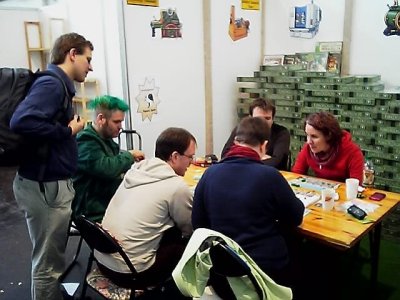 With the afternoon slowly passing, the halls were getting even more crowded, and in front of the LOOKOUT booth once again queues were forming in order to get a first pick at the new Agricola goodies. Also, first testing rounds were springing up where publishers have finished setting their booths up, and so I met Friedemann Friese explaining his new game Fabrikmanager which is settled in the world of Funkenschlag but is an independent game. 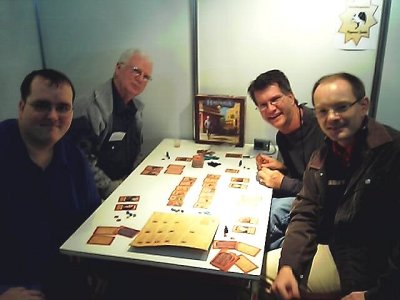 Having a bit of time left before I needed to get ready for the awards ceremony of the Deutscher Spiele Preis, I went to the booth of EGGERT SPIELE where I found James, Greg and Jim about to start a round of the new EGGERT-game Havanna. There was a place free on the table, and so I decided to join them to get an early chance to test the new game. The Caribbean island of Cuba seems to be of continuing interest for EGGERTSPIELE, since they have followed the release of their successful strategy game Cuba not only with an expansion, but also with a new stand-alone game named Havanna. However, whereas the former game was a full-sized boardgame with quite a few components, the latter comes with a somewhat reduced outfit of playing materials, featuring a set of 13 action cards for each player, 36 cards depicting buildings, some coins and worker figures and a bag filled with wooden cubes representing different building materials. Alas, no board is included, and so four players will use their action cards to compete to be the first player to construct buildings with a total value of 15 victory points. 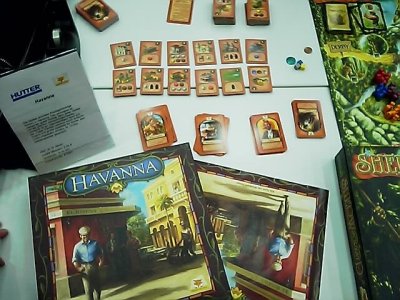 Apart from handing each player his own set of action cards, one peso and a randomly drawn building material the playing area is prepared by randomly revealing a total of 12 building cards which are placed in two rows of six buildings at the table. In addition, four pesos and three random building materials are placed as common stock next to the available buildings, and with these simple preparations the game already can start. The actions of the players are determined by their hand of action cards, and as indicated every player possesses 13 different action cards which allow actions like the taking of pesos or building materials from the common stock, the recruitment of workers, the stealing of pesos or building materials from another player etc. However, many of these actions bring up the question whether they actually can be performed, since much of the game depends on the player order and the number of available pesos and building materials in the common stock. Thus, it is much better to be one of the first players to act, since the choice of available materials is bigger and the risk of suffering from a thief is lower because a player who has played a thief primarily has to steal from a player who comes later in the player order. However, the order of the players does not follow a simple alternation rule, but instead it is actually determined by the action cards chosen by the players. Thus, all players simultaneously chose their two actions for the upcoming turn, and when the actions are revealed the players first have to check out the values associated with each card. The value numbers on the action cards vary from zero to nine, and each player has to align his cards so that they form a two-digit number, with the lower of both cards coming first and the higher number following. Then the players have to compare their numbers, and the player order is determined by going from the lowest to the highest number. As you can see, it pays off to have a lower number in order to get the possibility to act earlier, but on the other hand you might also have guessed that the more important action cards which allow the taking of specific building materials or money bear the higher values. Thus, the players have to ponder which two cards they should play, and it may well be worth to play a high value card together with a low value card (or even the zero-value "Siesta" which offers no action at all) in order to get a chance to profit from the higher value card. Once a player has acted on his two action cards and taken all workers, money and building materials he was entitled to, he ends his turn with the possibility to build one or more buildings from the open rows of buildings at the table. Here the building materials, pesos and workers are needed, and the restriction applies that buildings only may be purchased at the outer ends of both building rows, thus adding a bit of tactical depth by giving the players a chance to speculate on keeping resources for a possibly more valuable building at one of the inner spaces of a buildings row. The game then continues with the players taking their turns in player order until all players have acted on their two action cards (as good as they could with the later players possibly facing a plundered common stock). The common stock then is replenished with new building materials from the bag and some pesos, and then the players go ahead and chose their next actions. However, here comes the tricky part of the game, since the players are required to choose one of the action cards which they had chosen for action this turn, whereas the second action from the running turn is discarded and replaced with a fresh action card from the players' hands. This means that players have a chance to play the same action for two or more turns in a row if they keep discarding and replacing their other action card, but it requires a good degree of planning, a bit of memorizing cards already used by the other players and a good eye for the game situation to use card combinations to their best advantage. In addition, the players are confined further by the fact that their hand of action card is slowly diminishing, since the used cards are discarded and may not be taken back to a player's hand unless the hand is reduced to a size of just two cards. If these two restrictions are viewed together it becomes clear that that Havanna depends to a very high degree on the players' timing and also is a bit speculative. A general familiarity with the action cards and an understanding of the strategic value of each card is needed, because otherwise a newcomer might face detours and delays which will give more experienced players more than enough time to build and fortify a leading position. Myself, I run into a ine mess by having two cards of medium value on the table, with the other players outbidding me. I did not want to loose a full round by covering one of the cards which a low, weaker card, and so the others kept undercutting my total so that I was not able to gain the required money and building materials. However, if all players are on board in this cardgame (sorry, couldn't resist), Havanna offers a nice implementation of the players constructing action chains without actually becoming too predictable. The ever changing situation at each player's hand offers ample room for speculation how the other players might act, and a bit of bluffing and smirking all is part of the action. 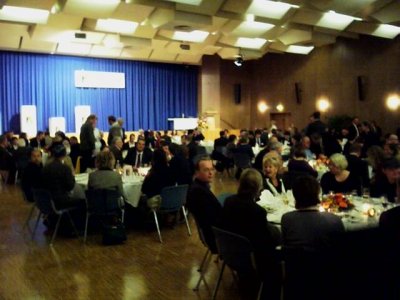 However, the day was not over for me after witnessing a landslide victory by Greg Schloesser, since I had an invitation in the evening to go to the awards ceremony for the Deutscher Spiele Preis 2009. 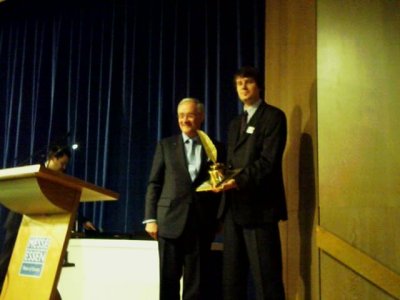 The ceremony was begun by Essen's major giving the Essener Feder to the game with the most comprehensible rules, and in this year the jury's choice had fallen on Diamond's Club from RAVENSBURGER.   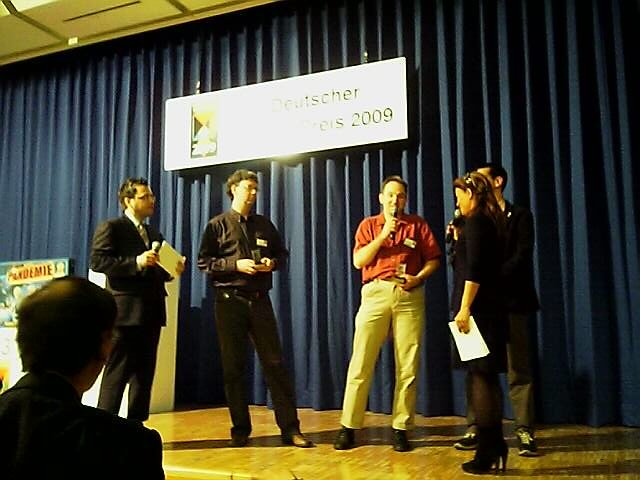 Then came the runner-up games for the Deutscher Spiele Preis, with Matt Leacock receiving the awards for his third placed game Pandemie and Uwe Rosenberg reaching second rank with Le Havre. 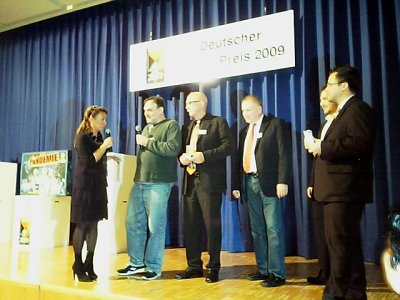 The first place however goes to the smash-hit of the year - Dominion. After winning the Spiel des Jahres jury awards, the game now also has won the Deutscher Spiele Preis public award, and so the somewhat shy Donald X. Vaccarino once again was orced to enter the spotlight in order to receive his awards, and here he was accompanied by happy publisher Bernd Brunnhofer from HANS IM GLÜCK SPIELE and Jay Tummelson from RIO GRANDE GAMES. 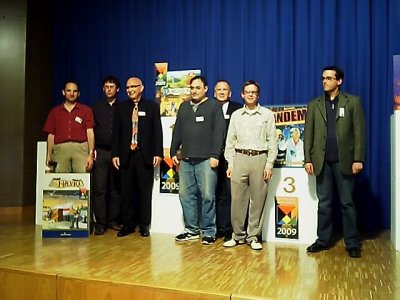 Myself, I enjoyed a fine evening at a table with Dagmar and Ferdinand de Cassan and Rainer Knizia, but all of a sudden a found myself back at home in front of my keyboard. I nearly wanted to end my report here, but then I remembered that I have something more to announce! G@mebox Convention GiveawayDOMINION - NOBLES & TOWNSPEOPLEIn previous years I could just tell you about all these small giveaways and mini-expansions which are available here at the SPIEL, but this year I have decided to let you participate a bit more actively. With the Dominion-boom still gathering momentum, I thought that the time has come to give the game a somewhat new twist. Thus, I have created a small expansion with some cards which can be used to increase player interactivity in your games of Dominion, and all you need to do is to print those cards out, glue them to blank Dominion-cards and add them to your game. 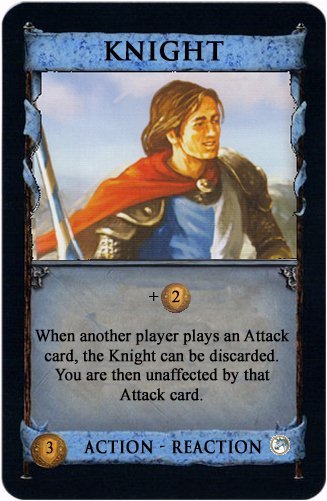 Depending on the number of blank cards you have available, you should print each of the cards included in my Nobles & Townspeople expansion two or three times. Then prepare a normal setup for a game of Dominion, but add an eleventh pile of Kingdom cards which includes all Nobles & Townspeople cards plus two cards of each unused kind of "Action -Attack" cards (you might prefer to add four cards of each kind if you just own the basic game). Shuffle the newly created Nobles & Townspeople deck, turn the two top cards over and place the two revealed cards and the deck next to the other ten decks of Kingdom cards. During his turn a player may purchase one of the two revealed cards from the Nobles & Townspeople deck following the normal purchase rules, but he is not allowed to purchase more than one card. If a card is purchased, it is replaced at the end of the player's turn so that the following player again can chose between two cards. If the current player does not purchase one of the two cards, he may either leave the cards available for the following player, or he may decide to put one or both cards back below the deck. In the latter case a corresponding number of new cards is revealed by the end of the player's turn so that the following player once again has two cards available. While it is true that the game gets a bit more unstable, my playtesting rounds were quite fond of the increased player interaction. Comparable to the Black Market promo card, more then ten types of cards can be used in Dominion if you use the Nobles & Townspeople rules, and so you have more variety in your games of Dominion Please note that this is a freely available tribute to Dominion. All rights concerning the game of Dominion are reserved to the game's author and the publishers. At this place I would like to thank RIO GRANDE GAMES and HANS IM GLÜCK SPIELE for their kind permission to display these cards here. So, stay tuned to the G@mebox in the next few days - there will be some more Dominion cards coming! Good night everybody! Thursday, 22nd of OctoberAnd here we are… The SPIEL 09 has opened its gates!!!Once again thousands of gamers from all over the world will be visiting the convention halls of Messe Essen from today until Sunday, and once again hundreds of interesting new games are waiting to be played by all these visitors. Especially this opening day for me is sometimes a bit of a déjà vu, since there are some events which occur almost every year during all convention days, but especially this first day brought quite a few events which could be witnessed a year ago. Thus, once again long queues were standing in front of the convention area, with people crowding into the Foyer to be the first ones to enter the show. Once the gates had opened punctually at 10 AM, the people were streaming in, and the first few dozens actually started to run through the halls. I can only guess what these people were hunting for: places at gaming tables, rare convention goodies or some limited items. However, these people run by in such a rush that I restrained myself from capturing somebody for interrogation. Who knows what might have happened if I stood between a games fanatic and his prey… 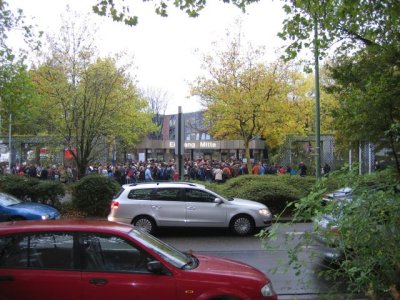 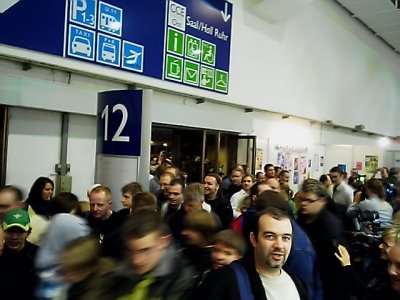  Some of you actually might remember my reports from the first public day last year, and there I have been at the booth of MATAGOT, joining a game of Giants together with Christian Leonhard, co-designer of the great 1960 - Making of the President. Yesterday Christian has asked me whether we should once again go for a joint playtesting today, and so we once again agreed to go to MATAGOT. Myself, I was really eager to have a look at their new game Cyclades, and so we sat down at the table just when the halls opened. On the next table we actually saw Bruno Catahala, one of the two authors of Cyclades, explaining the game to a group of French people. However, Christian an I were joined by two guys from southern Germany who also had read the rules, and so we could get a really quick start into the game. 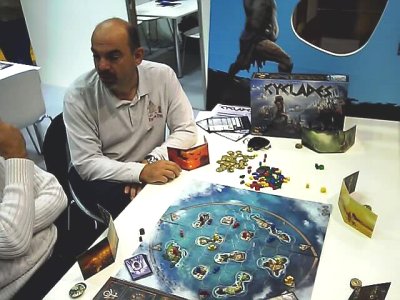 The graphics of Cyclades looked very convincing, and this is no wonder because over the last few years two French publishers were in a neck-and-neck race concerning the best graphical design of newly published boardgames. DAYS OF WONDER already has gained a strong international presence with its wonderful illustrated and richly equipped games like Shadows over Camelot or Smallworld, but at the SPIEL 08 the game Giants from MATAGOT was absolutely on a par with the games from DAYS OF WONDER. Considering the French tradition of beautifully illustrated comic books, it is no surprise that games with such a perfect design come from French publishers, but nonetheless it is astonishing that these two relatively young publishers quickly have outclassed many German designers with their fresh and colourful designs. When I heard that MATAGOT once again would be returning to the SPIEL with another big boardgame, I was absolutely delighted because they have chosen to implement one of my favourite themes: Ancient Greece! In 2008 Parker had released Deukalion as the last game in their unsuccessful series of author games, and despite its unusual use of meeples (in combat they were rolled like dice) and the specially fashioned dice cup the game only had been received with mediocre interest by the gaming scene. Looking at the new Cyclades, the game definitely outclasses Deukalion considering the design of all game components. In Cyclades each of the participating players assumes leadership of one of the great Greek city states, and all of these states have sent an expedition force of armies and ships to the Cyclades archipelago in order to establish supremacy in this area. Thus, each player starts with two islands occupied by one army figure, and on a space adjacent to each island a fleet has been placed. During the course of the game the players will aim to construct Metropolises on two of their islands either by trading in Philosopher cards or by replacing a collection of one of each of the four types of buildings existing in the game (Port, Fortress, Temple and University). However, as indicated the players just possess two fleets and two armies and five gold coins at the beginning of the game, and neither philosophers nor buildings can be seen anywhere on the gameboard. The actions of the players are dominated by offerings made to the five Gods (Zeus, Ares, Poseidon, Athena and Apollo), and the player who bids the highest offering for a specific God will receive the services of that God for the ongoing round. However, the God Apollo always will be available, and he is the only God who may be chosen by more than one player and who does not require any kind of payment from the players who have chosen him. For the other Gods special tiles exist in order to identify which Gods may be bid on during the ongoing round, but the rules prescribe that there will be always one God tile less than the number of participating players, so that at least one player has to settle with Apollo each turn. The bidding on the God tiles is regulated in a pretty straightforward way, with a player offering an amount to gain the favour of a God. Then the other players in turn either have the possibility to chose another God or to overbid an already placed bid, and if a player is overbid he has to retract his bid while at the same time making a new bid on another God. This way the bidding (and outbidding) continues until all players have made a bid either on one of the available God tiles or on ever-present, free of cost Apollo. As indicated, the Gods will determine which kinds of actions are available to the players, but while there are some differences all Gods apart from Apollo share the common attribute that they allow a player to call upon the aid of a mythological creature (as long as the creature cards for the current round last). The cost of a creature goes down from turn to turn if is has not been chosen, and a further reduction of the price may be reached by each Temple which a player has built. The player simply pays the indicated amount of money to the bank and takes the corresponding creature card, and the creature then may be used during the player's current turn. Most of the creatures are monsters like the Kraken, the Minotaur or the Medusa, and they can be used to bring different kinds of losses upon the other players. More helpful is the Pegasus, since he offers some kind of movement benefit. Apart from the common possibility to call upon a mythological creature, the four Gods Zeus, Poseidon Ares and Athena all allow the players to make different kinds of recruitments, and every God also means that the player who has won the God's aid may build a specific kind of buildings. Thus, Poseidon allows the purchase of fleets and a port, Ares provides armies and a Fortress, Zeus allows the recruitment of Priests (cards) and the building of Temples, and Athena helps to recruit Philosophers (also cards) and to build Universities. All costs must be paid in gold coins, and the players gain a income each turn which is determined by counting the prosperity markers on spaces occupied by a player. Such prosperity markers are printed on the islands, and they also can be found on some spaces around the outer edge of the playing area, so that a player can move one of his fleets there in order to symbolize trading activity, granting him an additional income as long as the fleet stays on this space. In addition, there is also the possibility to gain additional prosperity markers, and such a marker must be placed on any of the player's islands, with each marker increasing the income generated by the island by one. The most urgent question now will be how a player can enlarge his dominion, and here the fleets and armies play a decisive role. Thus, Poseidon can be paid to allow the movement of fleets, whereas Ares can receive additional payment to allow the movement of armies. Since every island consists of just one space, armies may not move on land, but instead they can be moved from one island to the next if an unbroken chain of fleets exists between both islands. If fleets or armies of two players meet, a battle ensures the outcome of which will be determined by each player rolling a dice, adding the number of armies/fleets and additionally a defensive bonus for Ports or a Fortress. The player with the lower result looses a unit, and the battle progresses to the next round of dice rolling until one player retreats or looses his last unit. If it was a land battle the winner gains control over that island with all buildings which have been built there. Talking about the buildings, the Port and the Fortress provide a defensive bonus which has already been mentioned. The Temples on the other hand have no influence on the outcome of a combat, but instead they lead to a reduction of the price of a mythological creature. The Universities have no specific function, but they cost available building space since they are one of the four types of buildings which must be combined in order to receive a Metropolis. Such an exchange is made as soon as a player possesses a building of each type (even if the buildings are located on different islands), and then the Metropolis is placed on a suitable space at any of the player's islands. However, the Metropolis is stronger than any of the buildings which had to be removed, since it combines the powers of Port, Fortress and Temple. Apart from conquest the other possibility to gain a Metropolis is through an exchange of four Philosopher cards which can be purchased if a player gains the help of Athena. While the Philosophers thus can be helpful on a player's way to fulfil the victory conditions, the use of the Priest cards which can be acquired through the help of Zeus is more straightforward, since each Priest in a player's possession decreases the Gold a player has to pay when bidding for a God's help at the beginning of a round. As I have already mentioned, the God Apollo stands on a somewhat isolated position, since he may be chosen by more than one player without requiring a payment from anyone. However, as might be guessed such freely offered services cannot be of the same quality as the paid favours of the other Gods, and so a player who has chosen Apollo just gains a prosperity marker which he can place at one of his islands, and some additional gold depending on the number of islands in his possession. And if more than one player has chosen Apollo, the prosperity marker only goes to the first player who has chosen the God, whereas all follow up must be satisfied with a bit of gold. The game is won by the first player who comes into possession of two Metropolises either by exchanging buildings or Philosophers or by conquest. However, the rules actually prevent a player from being pushed out of the game right till the end, since the noble Greeks only are allowed to occupy a player's last island if a successful attack leads to instant victory. Thus, each player has a somewhat protected fallback position, and this creates some nice possibilities to withdraw and reposition troops without the fear of instant defeat. The playing mechanisms which are merged in Cyclades function in a simple yet elegant way, resulting in a quite charming combination. A good example for this observation can be seen in the way the players bid for the favour of the Gods. Although several kinds of bidding mechanisms have been used over the years in different games, the bidding mechanism which has been used in Cyclades leaves the players with a very high degree of interaction. In contrast to a simple auction where one "item" is sold after the other, the players here have the possibility to react if their last bid has been ousted, and the reaction then must be made by bidding on another God. The situation in the bidding phase may go back and forwards, and even some strategies may be thought of, because a player who has been ousted may make a very low bid on another God tile in the hopes to be ousted once again and thus to get a chance to make once again a bid on the God tile of his first interest. As in Giants, the design crew of MATAGOT once again has implemented the bidding mechanism pretty well without overburdening the respective rules. Likewise, the rules for unit movement and combat are very condensed, and while battles are resolved with the aid of a dice the observance of the current majority situation leads to an easy resolution of a battle with the players still having the possibility to influence the outcome to a good degree. Since a player who loses a round of combat only loses one unit, it is very hard to overcome a player who has a majority of armies, and so arbitrariness is kept at bay. Overall, the convincing, easy to learn rules should appeal both to occasional gamers and serious hobbyists, and coupled with the outstanding artwork Cyclades for me already is one of the possible highlights of the SPIEL 09. Mind you, the game does not leave you with a feeling of being full of thrilling new rule inventions, but it is the perfect match of good mechanisms which makes the game a very harmonious whole. 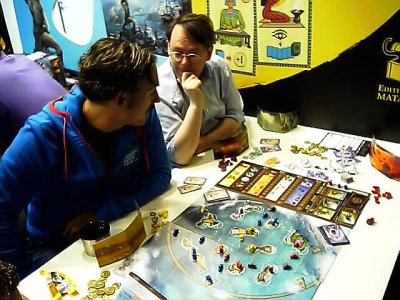 With this delightful start into the gaming day Christian and me parted and I went a bit through the halls in search of another game to playtest. The halls were really crowded now, and although smoking is absolutely forbidden inside the halls someone had the absolutely silly idea to put food stalls selling Bratwurst into one or two halls. I cannot remember that this has been done before, since the convention area offers an restaurant, and furthermore some luncheonettes are places at strategic places. Thus, there was quite a bit of smell in hall 6 where the live-RPF stuff is located, and to my mind this was not really nice to experience. Still, the air in the other halls where most of the boardgames are located was better, and so I quickly lefts those fantastic worlds and returned to solid gameboards. 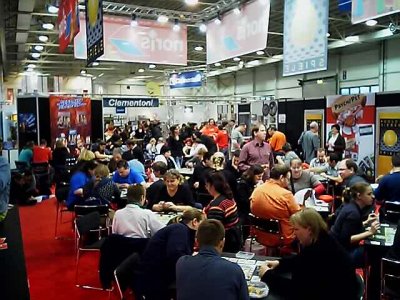 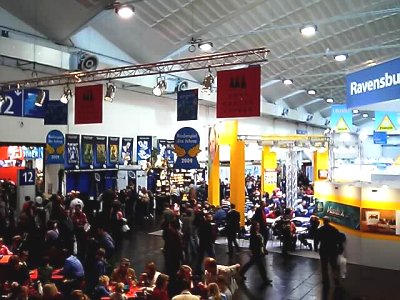 I arrived at the booth of VALLEY GAMES from Canada just in time for a new round of their railroad game Days of Steam, and being generally fond of the theme of trains in games I joined in to see what new elements the game could offer in comparison to the existing wagonload of other train games. When the rules instructor was done, my first impression was that the game actually was much lighter than many other train games, and indeed the whole game had a duration below 40 minutes. No gameboard is included, but instead the players are required to construct a gridwork of rails during the course of the game. Thus, several dozens of square rail tiles showing all kinds of straights, bends, forks and crossings were shuffled and placed face down at hand. Each player is dealt a starting hand of three track tiles. An additional deck of town tiles also is shuffled, and whereas one random card from this deck is placed at the center of the table as a starting tile where the locomotives of all players are placed, two more town tiles will be openly placed next to the deck of town tiles. All three of these town tiles will be assigned to random cargo cubes (out of four different colours), and during the course of the game the players will try to transport cargo cubes to cities of matching colours in order to collect the cubes as victory points. Apart from their locomotives and their staring hand of track tiles the players receive a small locomotive tile on which the current steam level of their locomotive is marked. The steam available to a locomotive will be needed to determine its movement possibilities, but before a movement becomes possible the players first have to lay a bit of track. Thus, during a player's turn he can either move his locomotive, play a new track tile or - if the locomotive stands at one of the rare water towers - pass a round to tank water and gather steam. The first few turns of the game are dominated by the players laying their first few track tiles from their hands, always replacing laid tiles with new tiles from the stockpile. Slowly the players develop a gridwork of rails, but since every tile also gives its player a small allowance to increase his steam level the locomotives soon will start to move. Only a few rules will need to be observed, most prominently that there may be no sudden dead ends of track, and the players also are free to place one of the revealed city tiles provided it can be placed at a position which is at least two rail away from the next city. Such a placed city tile then is replaced with a newly drawn city tile from the deck, and once again two random cargo cubes are placed on the new tile. At that time the locomotives will start to move in earnest, since they now have the aim to load cargo cubes and deliver them to cities of a matching colour. The locomotives must pay one steam for every tile they enter, and an additional steam must be paid if they enter a trail section on a hill or which is occupied by another locomotive. Quite nice are the rules for forks, since here the directions of the track and the forks must be observed, so that a player who wants to turn into a fork which does not face his direction needs to end his movement on the fork so that he can start a backwards movement in his following turn. The loading of a cargo cube is also quite easy, since a player can place it onto his locomotive when he moves through the town with the cargo. Thus, no dice is required for the actual movement of the locomotive, but a dice comes into the game if a locomotives moves more than two track tiles in one turn. For each bend the locomotive drives through at this speed, the player needs to make a derailing check. Thus, a dice must be rolled, and the result must be alt least equal to the current steam level. If it is lower, the locomotive derails and is returned to its starting point, but it loses all steam which the player wanted to invest in this turn. As indicated, steam is mainly gained through the placement of new track tiles, but the steam level also may be increased by four if a player decides to let his locomotive remain for a full turn at a water tower. Furthermore, the game gets into its final phase once the last town has been placed, and now each player receives an additional stockpile of five coal cubes. Players now are free to trade in any of their coal cubes on a one-to-one base at the beginning of their turns, and this results in a final race in which the players try to collect the required victory points. The game is won by the first player to collect 13 victory points, and each cargo cube which a player could delivery counts for him as two victory points. However, a bonus point can be scored during the track placement phase when a player places the last track tile which is needed to complete a full loop of tracks, and further bonus points are awarded if a player succeeds in collecting different colours of cargo cubes. Cubes of two colours provide one bonus point, cubes of three colours three bonus points, and a player who collects cubes of all four colours gets five bonus points so that he instantly wins the game when he gets a cube of the last missing colour. It seems that the name of the game Days of Steam has been chosen quite thoughtfully, since in comparison to games like Warfrog's Age of Steam this new game is lighter and plays much quicker. True enough, there have been quite a few track lying games over the years, and if you go back more than a few years you might arrive at titles like Linie 1 from GOLDSIEBER or the even older Rock Island which was one of the first games from HANS IM GLÜCK. Both games were about track tile placement and the movement of locomotives (or trams in case of Linie 1), but as a matter of fact the movement rules in Days of Steam offer a much more interesting, strategic approach. As indicated, no dice are removed for the direct operation of movement, but instead players control their movement allowance through their coal level, and the dice only needs to be rolled if a player wants to take a risk. Especially these movement rules with the listed specialities for forks, hills, coal and water towers let the game stand apart from other tile placement games which led to a somewhat random race in the final phase of the game, and to my mind Days of Steam is the ideal starting point for getting deeper into the world of railway games. 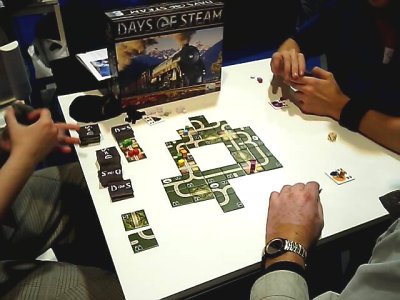 However, those people who actually have advanced to the deeper spheres of railway games also find their specialist designers here at the SPIEL, and most prominent amongst them is - of course - Martin Wallace with his small publishing label TREEFROG GAMES. Once again he has brought new train games to Essen, and as it seems the new titles were selling rather quickly. 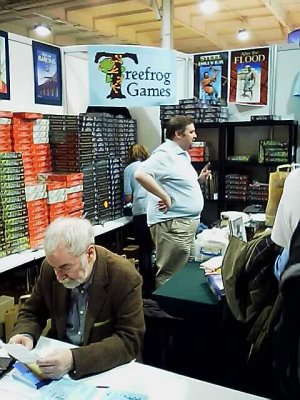 With the day growing a bit older, I was delighted to see the arrival of the cavalry, and in this case it meant that G@mebox co-author Ralf Togler has joined me here at the show. With so many new games presented at the show, Ralf once again has decided to join in by adding some of his own experiences at the show, and while I was typing this report tonight I received a mail including his coverage of the day. As so, as we have done last year, let me now give the micro over to Ralf to let him add his experiences of the day.  "Hello again everybody, I am back in Essen, helping Kulk once again to give you the newest impressions from the world's biggest game convention. After I left the highway and got near the fair area I had to recognize that the convention would be very crowded for the first time. Probably the holidays in our country are the result for this, because in the last years the masses did not reach the convention before the weekend. Cruising around I looked for a parking lot and finally I got one for free. Lucky enough that Essen is my birth town, so I know some places people from other towns will not find. Reaching the halls I was lucky for the second time. I had bought me a ticket at advance, so I did not have to wait before the ticket offices where long queues waited to get tickets. Another proof that it would be very crowded inside. Then, half an hour later after the convention has opened its gate, I was sure: it is definitely very crowded this year." 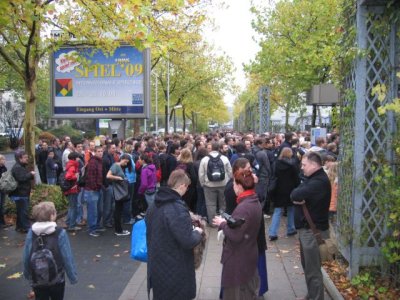 "Anyhow, lucky again I shortly after that found a table and two other guys who wanted to play with me at the booth of HANS IM GLÜCK. On the table we found Egizia, a game set in the old Egypt where the players build pyramids and other monuments to get most victory points. In every of the five rounds the players place ships along the bank of the Nil, and get the corresponding advantage of the field. One half of the fields remain the same for the whole game, the other half is exchanged every turn with cards. Every player has its own board to mark the strength of the workers and its current stones for erecting the buildings. The strength of the workers can be improved during the game, so they become stronger and stronger. Now in a round the players place their ships on the river one by one. Most of the fields on the river have only space for one ship. Ships must be placed downstream, so you always must have a look on what your opponents could plan, because otherwise a special field can be occupied soon. After this placement phase is over, all workers of the players must be fed. For this purpose you can get special cards that produce grain in the fields. But not every field produces at every round. This depends on the season that can be changed by cards or fields along the river. Workers that can not be supplied become very angry and so a player looses victory points. After that the players with ships on the corresponding fields can build monuments and Pyramids. This contributes to the victory points. Other fields are for increasing the strength of the workers, getting more building stones, improving the production of the grain and so on. On another field players can get special cards that have influence on the scoring at the end of the game for fulfilled conditions, for example completing the building of a monument. The game offers a lot of possibilities for getting victory points, in my opinion a little bit too much. There is not really anything what you can do definitely wrong, because almost everything has a positive effect and contributes to your points. I know that a lot of players exactly like this, but it is not really my taste. The victory points at the final scoring at the end of the game can change the order of the players enormously. This is another weaker point, because the cards for that are kept hidden, so that you cannot calculate who will be the winner during the game. As far as the rest is concerned, Egizia is a very nice game, the game flow is straightforward and fast and it was really satisfying to see the monuments and Pyramids grow during the game." 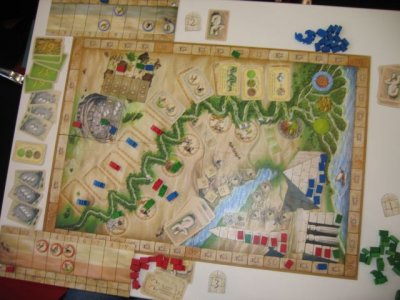 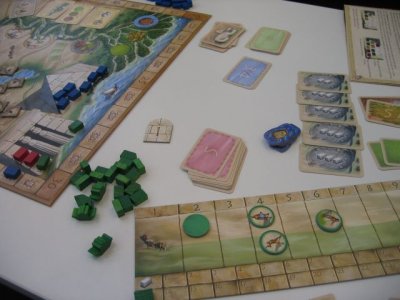 "After this positive first impression of the highlights of the big publishers, I had a walk to some other halls, before I stopped at the next booth were I could find an empty table. PEGASUS has a lot of interesting new games and so it was not too easy for me to decide which one I should test first. My choice was Frag Gold Edition. This new designed version of an Ego-Shooter will not be everybody's darling. Like in the computer games, each player take on the role of a fighter in a dungeon and his only aim is to kill as many of his opponents as possible. To do so he walks around, aims at other players and tries to kill him. This is all done with the helps of dices. The attacker rolls against the distance to hit. If the shoot was successful, he rolls again with as many dices as his weapon allows and the defender rolls with his life against this roll. This difference determines the damage. If a player looses his last life, he is fragged, the attacker gets a frag point. Of course a fragged player respawns in the next round again. Like in the computer games a lot of weapons, armors and other useful stuff can be collected on the board. My expectations were quite high at the beginning, but I had to learn, that Ego-Shooters on a boardgame loose a lot of the fun. I think the reason for this is that in contrast to the computer games the players do not act simultaneously, but have to wait, until it is their turn again. So you have a lot of idle time in the game. We played with six players until someone got three frags and although it was only three times my turn, it took us almost one hour until we got to an end." 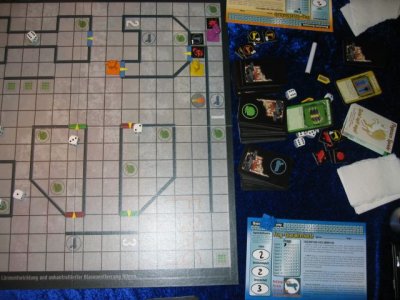 "Right after that I found another table, where I could try the new Roll through the ages - The Bronze Age. When I am remembering right the game was published last year by a smaller publisher. Now PEGASUS has published the game. In the game the players roll special dices to obtain workers, food for these workers, goods and money to build up their civilizations. Workers can be used to increase the civilization and so to get more dices to roll. Another possibility to use the workers is the building of monuments, which give victory points. Goods are produced on a wooden blackboard for every player. You always produce goods in a column. So if you produce two goods, you may put the first two rows (grain and stone) one step further. The upper rows are worth much more than the lower ones and so you should see that you always produce several goods. By selling the goods and with the help of the money from the dices you can further develop your civilization and get some bonuses for further rounds. The game is explained in about five minutes. Though it has a very simple game concept it really fascinated me. The game duration is quite short (about 30 minutes), so revenge should be no problem at all. I think that the game is something you can play with your favourite game group as well as with your children and your parents, too." 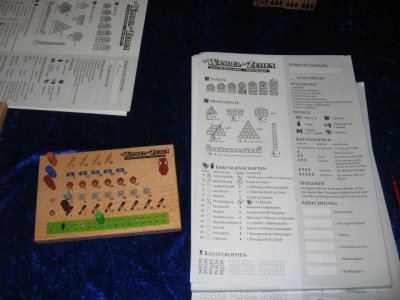 "So those were my tests for today. See you tomorrow again when I have some new impressions of interesting games, which I already have seen today but had no time to playtest yet." Getting the micro back from Ralf, after Days of Steam the day was far from being over because I had scheduled appointments with some publishers, and so I once again made my way over to hall 12 where ASMODEE was has set up a big booth on a huge area which had been occupied by HASBRO in former years. The meeting with the representatives from ASMODEE turned out to be rather interesting for me, since the company had grown considerably since they French publisher and distributor ASMODEE had entered the German market by acquiring PRO LUDO in 2008. Companies like REPOS PRODUCTIONS, MATAGOT, HURRICAN GAMES or GIGAMIC now all were united at the big presentation area of ASMODEE, and it was interesting to hear that ASMODEE really is trying to live up to their own pledge to set new standards for the games market.  Thus, I was delighted to hear that ASMODEE actually is trying to assist the small games retailers because they sees these shops as their strongest partners to keep a high-quality games market profitable and alive, and furthermore they are also trying to assist all small publishers which now stand united under their banner by giving them free logistical support here at the SPIEL. Thus, whereas these small publishers had to mount up their booths by themselves in previous years, they now found everything organised by ASMODEE so that they could do what they could best - present their new games. It is really astonishing that ASMODEE offers such a kind of free support, but for me this pioneering approach really sounds hopeful, since the loads of new games available at the SPIEL in the last years have left me with some anxiety whether the games market actually might overheat. Here the approach chosen by ASMODEE seems to offer some hope that quality awareness might prevail, and it is really great to see that they are following the path which they have set for themselves the year before. Continuing to a few other publishers, I was following a plan which I had set up before the show, and now I am rather happy to present you some results of a few meetings. Thus, I am proud to announce that EGGERT SPIELE, 2F SPIELE, DAYS OF WONDER and REPOS PRODUCTIONS all have sponsored some rare promo items, and adding a further Essen giveaway from ABACUS, I can now offer this nice package for the PRIZE-DRAW!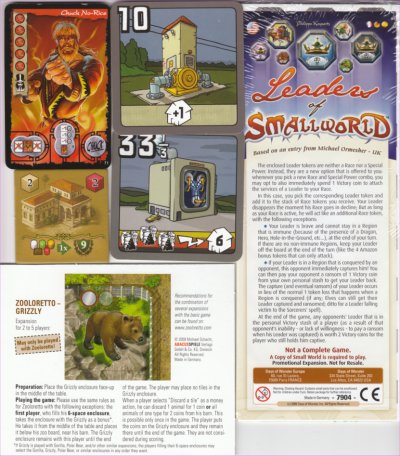 On the picture above you see a collection of the Umspannwerk and the Flux Generator for Friedemann Friese's Funkenschlag, a special Hacienda tile for Cuba, the Chuck No-Rice promo card for Ghost Stories, the Smallworld-giveaway Leaders of Smallworld and a special Grizzly enclosure for Zooloretto. Furthermore, a small bottle cooler from EGGERT SPIELE is included as well. Believe it or not, but this whole collection is available at this prize draw not once, not twice, but actually THREE TIMES!!! Thus, you might want to sign my SPIEL Guestbook if you want to have a chance to win such a collection of Essen-giveaways. Thanks again at this point to all publishers who have kindly donated such a collection of these great add-ons. Having secured these great items, I went on to keep another promise I have given yesterday, and so I re-entered the news show to take some pictures of the painted miniatures of the new War of the Ring Collector's Edition, and although my small mobile phone camera is hard pressed with such close-up pictures the quality is better today so that I actually dare to show two pictures. The minis look even better in reality, and they will come in great trays which all can be placed in the huge wooden gamebox. This morning I could also lay my hands on a pre-order cheque for the game, and so I really hope this year that the game will arrive before Christmas. 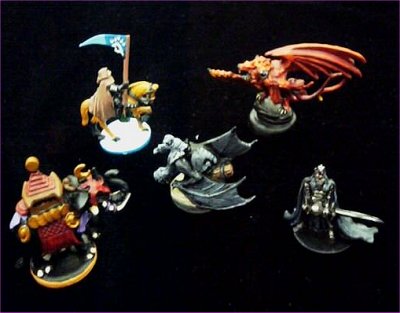 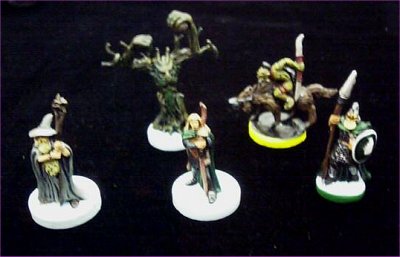 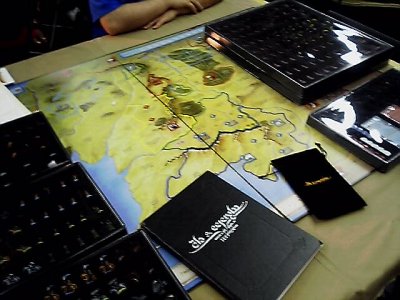 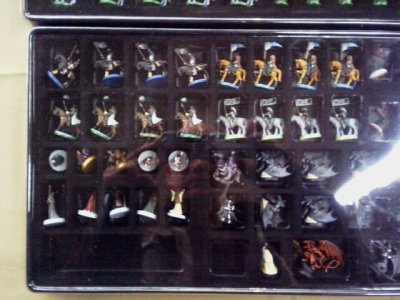 Being up at the news show, I also took out a chair to give a closer examination the Reaper-Expansion for Talisman which caught my interest as an old Talisman veteran. Whereas the initial release of the 4th edition of Talisman by GAMES WORKSHOP in most parts was a graphically updated reproduction of the old 2nd edition, the passing of the publishing rights to FANTASY FLIGHT GAMES brought a few additional tweaks like the introduction of Fate markers which had some interesting positive impacts on the playability of the game. However, due to these minor innovations it also became clear that FANTASY FLIGHT GAMES would try to make other improvements and innovations, and the first of these innovations is the newly released Reaper expansion. The Reaper expansion comes in one of FFGs small boxes which they have already used for small games or Arkham Horror expansions, and so the box does not contain any additional gameboard but instead three packs of cards, five character sheets and matching miniatures. One of the character sheets depicts the name-giving personality of the game - the grim Reaper. However, although the Reaper is present on the gameboard as a miniature he is no typical character because he is not played by a particular player. Instead, each time a player rolls a "1" for movement he rolls an additional dice when he has finished his own movement. He then is allowed to move the figure of the Reaper through the outer and middle regions for the amount of steps indicated by the dice, and it is the player's most prominent aim to place him onto a space containing another player's character. As might be guess, such a meeting with the Reaper is dangerous, and so a character who meets the reaper is required to roll a dice and to reference the result of his dice-roll with the results listed on the Reaper's character sheet. Notwithstanding the fact that there is a small chance for the player to reach a beneficial result, there is a higher chance that the visit of the Reaper has a detrimental effect. Thus, the results may be the loss of a round or even of a lifepoint, but the ultimative punishment is immediate death of the player's character. On first sight this may sound like it is too strong a result, but on the other hand it should be mentioned that the Reaper was introduced by FFG to increase interactivity in the game. To reach this effect, the Reaper must be fearful, because otherwise the players would simply ignore his presence and take it as a bare flesh wound if the worst thing which could happen was the mere loss of a lifepoint. In addition it should be remembered that players are allowed a re-roll if they spend a Fate marker, and so risk of a total loss can be minimised by taking out a "Fate point insurance" and by watching the movements of the Reaper. To my taste the Reaper does not really throw the game off balance, but he increases the number of instances when the players can influence each other, and so FFG really reaches the aims which they pursued. Another total innovation which is included in the expansion is a set of 12 Quest cards, and these cards can be used as an alternative to the 6 quests printed on the Warlock-space of the gameboard. Thus, the players now have new possibilities for quests in which they can obtain a Talisman by choosing one of the available quests instead of rolling a dice on the Warlock's table. However, the rule that a player actually can chose one of the remaining Quest cards is somewhat two-sided, since it allows a player to gain a Talisman much faster if a quest demanding something in his possession is still available. This devaluates the bigger efforts which the other players might undertake in order to get their quests. On the other hand the free choosing of a quest actually might lead to a bit more strategic gameplay, since a player might try to cover his back by fulfilling two or even more quests in a row in order to prevent others from getting a quick Talisman. The other playing materials included in the box are four characters (Knight, Dark Cultist, Merchant and Philosopher), Spells and Adventure cards, and all of these show a strong handwriting and revisioning of the FFG team. Seasoned Talisman players will discover some cards from the classic add-ons Talisman - The Expansion and Talisman - The Adventure, but not all cards from these expansions are included, and furthermore the text on many of the cards has seen some revisions. Some of the changes are concerned with the gaining and use of Fate markers, but other rules have been introduced to change cards which were considered to be too powerful. An example here is the Warhorse, since it now only allows the player to add his initial Craft rating to his combat roll, and furthermore it must be discarded if the player looses a lifepoint in combat. Overall, I consider the changes which were made by FFG to be generally beneficial to the gameplay in Talisman, although some of the rules-innovations like the aforementioned Warhorse certainly could be discussed whether they really are the most fitting approach. Over the years I have seen different solutions for difficult cards discussed on Talisman-fansites and in forums, and as it seems by the acknowledgements given in the rules FFG has consulted with some senior Talisman-fans like Jon New from Talisman Island during the creation of this expansion. Thus, I will take those cards as a combined effort to clear problems up which could be found in older editions of the game, and as such I generally welcome the effort which was made. What I really like in the expansion is both the Reaper-character and the Quest cards. With a minimum of new rules and effort both of these elements lead to an interesting new angle in a game of Talisman, and so they can be seen as a real gain for the Talisman-World. 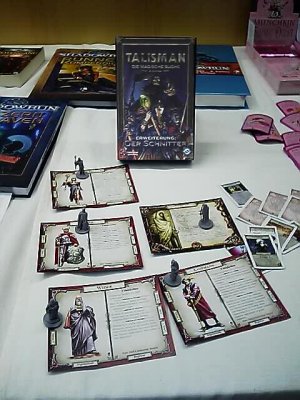 Having still some time left, I remembered that I had seen an interesting looking game while a passed though hall 6 during the morning. The Fantasy-Wargame Insel der Steinernen Wächter (Island of the Stone Guardians) by ELFENHERZ SPIELE first captured my eye with its unusual looking gameboard (or better: playing area). Whereas I have seen many games containing a modular gameboard which can be mounted in different ways, I do not think that I have yet met a game which uses a plain blue underlay on which islands consisting of several hexagonal provinces are placed. First to be placed is the central island of Lutao which actually features a border of blue sea areas around its land masses, and then all other islands are added so that they either touch the sea area around Lutao or any other island which was already placed. Despite the fact that the underlay does not contain any kinds of spaces, the hexagonal shape of all land masses and the mentioned placement rules ensure an even distribution of all islands, and as you might guess this variable setup offers a lot of variety from one game to the next. The game itself seems a bit more traditional, with each player receiving a starting hand of province cards in which a certain amount of army markers can be distributed. In the course of the game the players will compete to conquer the central city of the island of Lutao, representing the former capital of the whole realm from which the races of the players were ousted when several powerful sorcerers decided to claim the land of Lutao for themselves. Now the sorcerers have died, but the fame of the riches of Lutao still is alive with the different player races, and so are also the huge Stone Golems which the sorcerers had created to destroy all races who should try to return to Lutao. 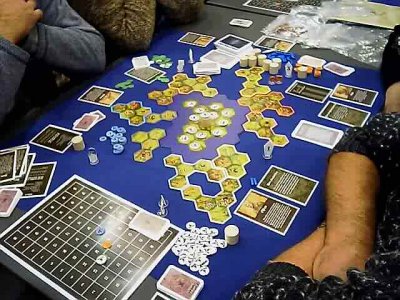 The number of provinces occupied by a player also determines the major part of a player's income. Additional income is generated by each city or complete island a player possesses, and furthermore the occupation of any province of the central island of Lutao is also rewarded. A player uses his income to purchase armies, ships, cities and movement markers, but whereas income is collected and purchases are made at the end of a player's turn any placement of newly acquired markers is made at the beginning of the player's next turn. In their turns the players have the possibility to move their armies on land or to make a sea movement with armies embarking from a province containing a ship. However, whereas the land movement is a simplistic movement of each army into a neighbouring hex, the sea movement is somewhat resourceful since it uses movement markers which must be acquired by the players. These movement markers are short wooden sticks, and if a player wants to make a sea movement he must place a continuing path of movement markers from the province in which his armies and the ship are located to the province where the armies should make landfall. The movement markers are discarded after the sea movement, and the use of these markers cleverly negates any need of hex spaces on the blue underlay, since the whole measuring of distances is effectively dealt with through the movement markers. Players are allowed to test in the purchase phase whether they have acquired enough movement markers, but apart from the fact that this would reveal their next action to the other players it perhaps might be an interesting variant to prohibit any advance measuring. Especially in times where a player is tight on cash the movement markers might prove themselves to be tricky, since the players then would need to estimate how many markers they might need to make a movement, and so they would have to balance their wish to buy additional armies against the certainty of a sea voyage. Whenever the armies of two players meet in a province a battle arises. The players have no regular possibility to withdraw, but they must fight the battle right till the end. The results of each battle round are determined by a partially randomized method, but instead of rolling some dice the players actually draw a hand of cards from their own decks of combat cards. The number of cards depends on the number of participating armies plus one (up to a maximum of four cards), and each player choses one of these cards which he puts back below his deck of combat cards before he reveals the other cards to his opponent. All cards are acted on simultaneously, and so cards for defence, misses, hits, hits against armies in a city and heroic hits (2 armies or one army in a city) are included. Both players remove their destroyed armies, and combat goes into another round with both players drawing new combat cards until only one player has no armies left. My first thought of the combat cards was that they are a fanciful replacement of dice with no additional use, but once you have started playing you will actually discover that this observation is wrong. Combat cards used by a player are discarded, and the discarded cards only are returned to play when a player's stack of combat cards is exhausted. Thus, it matters very much which cards a player choses to place back below his stack of combat cards at the beginning of each round of combat, since if the players want to avoid too many miss cards this way they will get their punishment in a later combat when they have to face all those cards which they did not want to meet earlier. While it is difficult to gain insights into the deck construction of the other players through their success in combat, some valuable hints may be gained at which times a player may be more vulnerable, and so the players should be aware of "bean counters" who try to memorize the number of used hits and misses in order to determine the right moment for a crucial strike. On the island of Lutao the Golems are waiting, and a player must fight his way through at least one of the provinces containing Golems before he actually can try to occupy the central city. If he succeeds, he will need to keep his occupation of the city for two additional turns in order to win the game. As usual with such "capture the flag" games, the other players burst into activity if a player seems to get too close to the city of Lutao, but in Insel der Steinernen Wächter the first player to reach the city gets the strong advantage that he gains control over the Golems. Thus, in every turn he gets a number of Golem actions equal to the number of his competitors, and these actions either may be used for adding new Golems at an unoccupied province or for moving and attacking with Golems from a province. 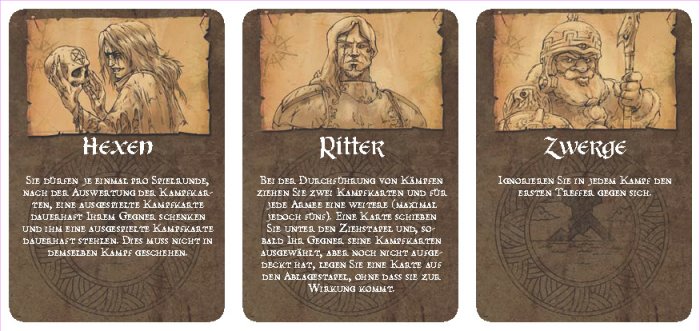 The game is spiced up by special abilities. Thus, each player has a unique race with a permanent special ability, and furthermore each player receives a rune which gives him another special ability. Most of these abilities are focused on movement and combat, but some others are concerned with gaining additional troops, spell cards etc. Talking about spell cards, these cards may be drawn if a player is in possession of one or more cities, but even though these spells once again offer benefits for movement and combat, they differ from the races and runes because they are not of permanent durability. Thus, a spell can only be used once and then must be discarded, but on the other hand the players usually have access to replenishments through their cities. Most of the ingredients used in Insel der Steinernen Wächter like hex-spaces, combat cards or special abilities seem well known from other games, so that the question might be asked why the game actually should be purchased. However, due to the addition of some minor innovations and an good mixture of these ingredients the game creates an interesting challenge for the players, and it can be replayed with a different setup situation every time the game comes onto the table. Here it should be mentioned that some of the special abilities which can be encountered in the game seem stronger than others, but all players still have a more or less equal chance to win because they can chose their combination of race and rune during the setup phase from a handful of races and runes, and during the course of the game it becomes quite interesting to make the best of the chosen combination. A big plus in comparison to some other epic battle games is the simple elegance of both the movement and combat mechanisms, and the author wisely has chosen not to overburden gameplay with too many options like different types of units or different landscapes, since a too sophisticated set of rules would have changed the general spirit of the game. As a matter of fact, the chosen balance between variety (special abilities) and simplicity (rules of low complexity) seems to be almost perfect, and so the game actually compares to some degree with classics Wizard's Quest, but it offers a higher density in terms of story elements and strategic options. Adding a purist but accommodating graphic design, Insel der Steinernen Wächter can convince strategy players who should not be put off by the whiff of understatement which may be felt on first sight. If you want to learn more about the game, you might want to have a look at the Elfenherz website where English rules and card translations can be downloaded. 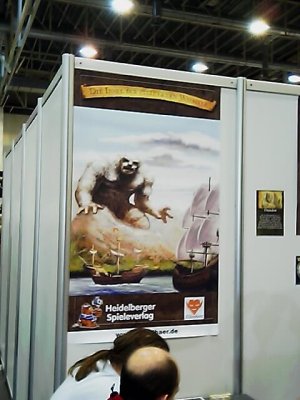 To finish the at the show, am made a visit to Jussi Auto at TUONELA PRODUCTIONS since he had told me that they had brought some nice cardgames with them to the SPIEL. Having arrived at the booth, I chose to go for a round of POLITIX, a quick cardgame originally produced by ONNI GAMES in which every player takes the role of a politician who tries to win the favour of different groups of voters. Although the names of Finnish politicians are used in the game, there is no disadvantage for players who don't know anything about Finnish politics. Thus, each player receives a politician having attributes for debate, charming, intimidation and twisting & turning plus a hand of cards including single cards with these attributes, coffee and buns as jokers and some special action cards. Some voter cards are revealed from a special voter deck, and each of the voter cards lists how susceptible the group will be to the different attributes of a politician. Playing matching cards and adding the politician's attribute, a player who get the needed amount can take a voter card matching the requirements, and if more than one card of this electorate is present every additional voter card of the same kind may be taken for one additional matching symbol card each. Cards on the players hands are refilled with three additional cards when a player decides to use his turn for drawing, and during the course of the game the players aim at getting more or less equal amounts of voter cards from all electorates, since the game will be won by the player with the highest number of cards in his weakest electorate. Fun comes into the game when more than three players are participating, because now players have to play in teams with politicians of the same parties, keeping a common stockpile of the voter cards they could require. Furthermore, some more variation is added due to the special action cards and the general condition cards which can be uncovered in the deck of voter cards, since all of these cards list changes on the political agenda which will make it more or less easy to gain cards from certain electorates. POLITIX takes a humorous look at a politician's desire to be well received by as many different groups as voters as possible, and so some constellations in the game actually are quite funny. An example here is a special action card which allows a player to have an affair, and such kind of publicity gives the player a greater chance to convince a group of voters called "The Blondes" who quite eagerly falls to all kinds of romantic approaches. As indicated, the game should be seen with a kind wink, but it's one of the reason's why I like the SPIEL so much. Games appear here at the show of which nobody has heard a word, and considering the nice graphics and the funny topic, the game really was worth the fun. 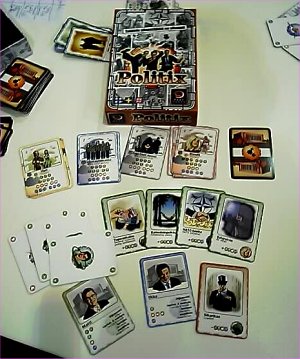 Okay, but now it's 2:07 AM over here. Time to sleep. However, let's not forget about my G@mebox Convention Giveaway, and here comes the second card for my Nobles & Townspeople expansion for Dominion. 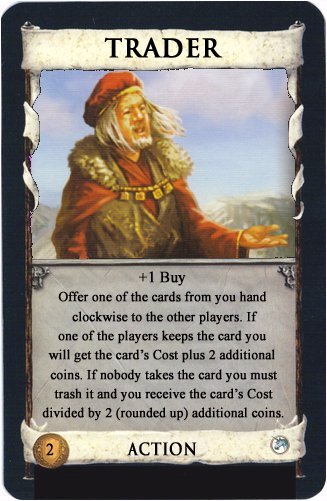 See you tomorrow! Frank Friday, 23rd of OctoberWow, and here we go again! These convention days seem to fly by, playing games over the day, meeting with people and then sitting here at the computer till deep into the night. Every night I am just happy when I get into my bed, but it is amazing how the prospect of an entertaining and happy day can drive you out of sleep at the morning, despite the fact that 5 hours sleep is not much. Anyhow, today was the day where I had the fewest official meetings in my schedule, and so I finally got the chance to take a deeper look at a game which I was longing to playtest. I made my way through the halls shortly before the opening at 10 AM to reach a certain game for playtesting, and passing by the booth of AMIGO I saw a good crowd of game instructors in the final briefing for the day. Funny enough, AMIGO hires exclusively young, good-looking girls to present their games, and I have observed such kinds of morning meetings for several years now. On the one hand it seems at least understandable to some degree, because many youths actually might feel attracted to the booth to playtest something. On the other side, the convention is really well crowded, and all the other publishers around AMIGO barely have a free table as well, so that such a single gender crew of presentators does not seem necessary. 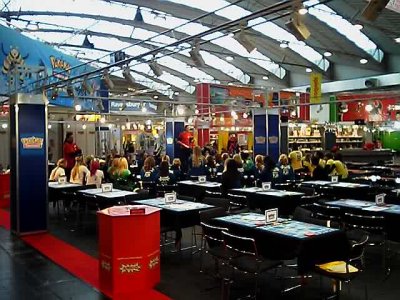 Those of you who have followed my footsteps in previous years will have noticed that I have a strong interest in both the Lord of the Rings and adventure games, and thus you might understand my eagerness that I was looking forwards to get a chance to have a closer look at the new Middle Earth Quest by FANTASY FLIGHT GAMES which now has found a German release through KOSMOS. The announcement that a game uniting both of my tastes would be released made me more and more restless as the days to the SPIEL were ticking down. Surprisingly enough, the German release of the game is not handled by FFGs usual partner HEIDELBERGER, but instead FFG has chosen an alliance with KOSMOS. As it seems, KOSMOS was chosen due to the fact that they had published a series of Lord of the Rings based games over the last few years, and another consideration also might be that KOSMOS also has a good standing as a book publisher which could mean that the FFG game possibly could get access to sales at bookstores. Anyhow, with the possibility to playtest the game at the SPIEL, I simply had to make a visit at the KOSMOS booth in order to get some first hand impressions on the new game. Taking seat at a table and letting my view run freely over the components of the game, I was once again impressed by the multitude of card decks, tokens, miniatures and other playing materials which FFG tends to include with its games, and furthermore I also was quite taken with the nice illustrations which could be found both on the cards and on the huge gameboard. Although FFG failed to hire my favourite Tolkien-artist John Howe, the artist nonetheless has made a good job and many places and creatures have been brought to life with impressive drawings, and so the basic requirements for an atmospheric game were set. 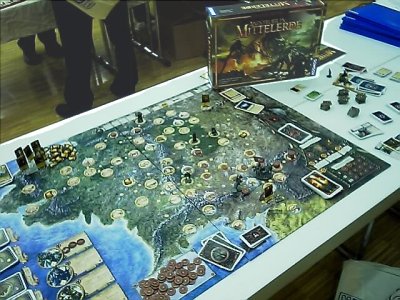 Grabbing the rulebook to take a first look at it before an instructor would arrive to teach the game, another typical side of FFG games also is present in Middle Earth Quest: the rules are over 30 pages long, with lots of examples included but also with quite a bit of nifty and tricky details, and by this first general look I got to the impression that the game definitely is no speedy starter like Talisman where all you need to start is to choose a Hero and roll a dice, but instead the game bears a much stronger resemblance to the starting requirements found in FFG's Arkham Horror where quite a lot of rules need to be explained and where even the game setup requires additional time due to the multitude of included components and card decks. Okay, here at the SPIEL it is much easier to gain access even into complex games, since the publisher's instructors usually are rather helpful, but back at home the game certainly will require some explanatory time to get new players into the rules. I don't know why, but actually I was hoping for Middle Earth Quest to be a cooperative game like Knizia's classic Lord of the Rings boardgame or the already quoted Arkham Horror, but as I could see right from the beginning this hope was not fulfilled here. Instead, the game follows a more classic confrontational approach known from games like Heroquest with one player assuming the position of Sauron and up to three others players taking the roles of Heroes of the Free People, cooperating to bring down Sauron's plots. The game is set in a period of 17 years between Bilbo's disappearance at his famous birthday party and Frodo's leaving of the Shire in order to destroy the One Ring, and during that time span Sauron slowly was spreading his influence to prepare for war and to search for the lost One Ring. The Heroes are so-far unknown characters belonging to the different factions of Middle Earth (a Dwarf, a female Gondorian, a Rider of Rohan, an Elf and a female Ranger), and they take the position as allies of Gandalf who have sworn to thwart Sauron's plans in any way they can. As a result of the different roles and aims of Sauron and the Heroes, both sides apply a different set of available mechanisms and actions in their playing turns. Staring with the Heroes, their roles and playing mechanisms partly will seem familiar to players who have seen other kinds of adventure games. Thus, each Hero possesses a Hero card listing some attributes like Fortitude, Strength or Wisdom, and during the game the Heroes can raise their attributes and collect helpful skills and items. Most precious commodity of all Heroes are Favour tokens, and these can be collected by different events, combats and meetings during the game. The Heroes can use these Favours to hinder Sauron's plans in different ways, and thus they will bee constantly on the outlook to gather new Favours at different places (remember the Clues in Arkham Horror?). However, a quite interesting approach has been found by FFG to the questions of Combat, Movement and measuring a Hero's health, since all of these factors are decided by a deck of Hero cards which are gathered in a so-called Life Pool. Each of the characters possesses his own Life Pool of Hero cards, and during the course of the game the players constantly will draw cards from their shuffled Life Pool and take these cards as their playing hand. In a technical sense the cards on a player's hand still count as cards in the Life Pool, and a Hero is defeated if he comes into the situation that he has neither cards in his Life Pool nor at his hand. A player must discard cards from the Life Pool or from the his hand whenever he loses Lifes (by combat etc), and these cards are placed into a separate Damage Pool. They cards only can be moved back into the player's Life Pool by a healing action which can be chosen at some Haven-places, but as long as the cards are not moved back the stockpile of Hero cards available to the player is slowly dwindling. The effect of this multifunctional approach is strengthened by the fact that the player also will use the cards on his hand either for movement or during combat. Whenever a player wishes to move his Hero from one location to the next, he looks at the path between the two locations in order to find a terrain symbol and a number. The movement can be made if the player discards either a Hero card with a matching terrain symbol or the required number of Hero cards into yet another discard pile - the Rest Pool. Likewise, in each round of a combat both the Hero and Sauron secretly chose one of their combat cards and reveal them simultaneously, with each side dealing damage to the other corresponding to the attack and defence values of the cards. The cards used in combat also are discarded into the Rest Pool, and although Resting does not require a Hero to be in a Haven it still costs precious time to get the cards from the Rest Pool back into the Life Pool. However, although the combat rules are fairly straightforward, let me tell you a bit more about the surrounding conditions. As you might guess, Sauron commands a horde of Monsters which he can bring into play and move on the gameboard in form of face-down monster tokens, and in addition he also commands five Minions (like the Witch King or the Mouth of Sauron) which are his own special characters. Whenever a combat between a Hero and a Monster or a Minion ensues, Sauron checks at the corresponding Monster or Minion card to see which deck of combat cards he is allowed to take (these decks are labelled Zealot, Marauder and Behemoth), and he draws a number of cards from the freshly shuffled deck as a starting hand for the combat. The combat then ensues, usually lasting for several rounds in which both Sauron and the Hero player simultaneously choose and reveal their combat cards. Other than the Hero the health of Sauron's creature is not measured by the size of his card deck, but instead he keeps track of the number of wounds dealt by the Hero. If a certain amount of wounds is reached, the creature is slain and the Hero can continue with his turn, whereas on the other hand a Hero running out of Hero cards is defeated and his playing piece is moved to the closest Haven, once again loosing the side of the Free People precious time in their struggle against Sauron. As a side detail, I should also mention that the combat cards also contain special effects which can be applied either in the same or in the following round of combat, and these effects actually add a small strategic element to the combat since the players need to work out an order in which they want to play their cards. However, a combat does not run forever, but instead each card has an exhaustion value which adds up to a total level of exhaustion, and if a player has reached his maximum exhaustion he can no longer play cards in this combat. And if both players are exhausted before either Hero or creature is defeated, the combat ends with Sauron being able to spread Influence tokens equal to the wisdom rating of his creature. Talking about Influence, we now have reached the point at which we should have a look at the playing mechanisms available to the Sauron player, and here it is important to understand the way how success and time are measured in the game. The gameboard features a Story Track at which one Hero token and three different Sauron tokens slowly advance, and when either one of the tokens reaches the last "Finale" space of the Story Track, or alternatively all three of Sauron's tokens pass a space called "The Shadow Falls" approximately half the way up the Story Track, the game moves to its final stage. Both Sauron and the Heroes struggle to trigger the Finale with their own marker(s), since the advantage of being ahead on the Story Track gives the leading side a chance for an instant victory. However, whereas the Hero's marker generally is moved forwards during each of Sauron's turns for a fixed quota of two steps, Sauron's markers only are moved forwards if Sauron succeeds in playing and keeping Plot cards. These cards are assigned to certain locations on the gameboard and give Sauron different advantages ranging from the movement of his Story markers to detrimental effects for the Heroes, and so the Heroes try to reach these locations in order to force Sauron to discard the Plot in exchange for discarding Favours. Sauron's main instrument in the game is his Influence, and he slowly spreads influence markers over the gameboard in lines coming from Shadow Stronghold locations. The playing of Plot cards and Monsters usually require one or more Influence tokens to be present at a location, and thus Sauron's influence markers slowly crawl into different regions in order to give the Sauron player an opportunity to cause some mischief there. The Heroes on the other hand do not only combat his plots, but they also force Sauron to discard Influence at their current locations, and sometimes they even succeed in isolating a chain of influence from a Shadow Stronghold, causing Sauron a massive loss of Influence. Apart from the placement of influence Sauron also may opt to move Monsters and Minions and to draw and play certain types of Shadow cards, and so the Sauron player does not focus on a single character like the Hero players do but instead is in command of a number of factors which all contribute to a progressively worsening situation on the gameboard. There exists quite a number of side rules concerning Sauron's choice of action and other game factors, but it would blow up the scope of this review to go deeper into details. Something which should be mentioned here is the fact that Event cards which can be played by both sides also add to atmosphere and variety in the game, and the availability of certain decks of cards also is linked to the current stage on the Story track so that different decks come into play as the game proceeds. A nice advantage for Sauron is the fact that the Hero players are not allowed to consult with each other in secrecy or to show each other their hand of cards, but in terms of the story this necessary advantage can be justified by the fact that Sauron has his spies everywhere. On the other hand this simple rule results in an interesting dilemma for the Heroes, since they have to weigh how much they should tell each other because the enemy is listening. Coming to the grand Finale, both the Sauron player and the Heroes side have received a Mission card at the beginning of the game. This mission card lists a condition which the player(s) should long to fulfil, since the card will be checked if a side has triggered the Finale by advancing a marker on the Story Track. If the condition on the card is met that side can claim instant victory, but it is only relevant if the side has triggered the Finale with its story marker. If no instant victory can be claimed, each Hero player receives a full hand of hero cards and the Heroes must chose a Champion who will face a final combat against Sauron's Ringwraith minion, and the side who wins this final combat then has won the game. As indicated, there is much more to Middle Earth Quest than can be told here, and features like quests for the Hero players and skills which can be learned and added to the Hero decks enrich the game even further. However, the playtesting session here at the convention has shown me that my initial thoughts about a longer explanatory phase before the game can be started are necessary. Both Sauron and the Hero players need to understand the game fully in order to participate, and this means that new players face a considerable rules volume when they want to learn the game. The rules were structured well and were a useful reference during gameplay, but this does not lower the initial hurdle. An interesting question which I asked myself after the playtesting session was whether I like Middle Earth Quest so much that my eagerness for the game to be released can be justified, and here I must confess that I left the playing table with somewhat mixed feelings. The rules were good and overall the game offered a quite authentic playing atmosphere, and I especially liked the Hero decks and their different uses since they effectively remove the well known six-sided randomizers which tend to fall to the floor. All elements of a classic adventure game can be found in Middle Earth Quest, but FFG actually succeeded in putting a stronger strategic orientation into the game, thus leaving the players with a higher degree of control and options for planning. I do not think that I have seen such a sophistication in an adventure game before, and this makes Middle Earth Quest to my mind a rather outstanding game. However, there also are some factors which have partly spoiled my enjoyment, and foremost to mention is the fact that one player needs to play the bad guy. I know, it is a rather subjective view that this decreases playing fun because the Sauron player takes a more active stance than a typical gamemaster, but still I prefer to be on the Hero side in these kind of games. As a matter of fact, I have rarely seen a player who is not really eager to play a character, but instead is satisfied with the role of the scheming evil-doer on the manager seat. Furthermore, I consider a final combat of one character against the Ringwraiths to determine the winning side as a somewhat sub-optimal alternative to the instant victory by a completed Mission. While the fine-tuned mechanics of the Story Track and the general playing procedures make it hard to think of an alternative solution, a combat seems to be a rather quick and somewhat luck-dependant possibility to end the game. Okay, this statement needs to be partly counterbalanced, since I have explained earlier that combat is more strategic in Middle Earth Quest than in many other games, and furthermore the final scores on the Story Track and the skills and equipment collected by the Champion all come to bear in this combat as well. However, a final combat still feels quick and merciless, and thus it might be seen a bit unsatisfactory after long hours of plotting and planning. As an additional point of criticism, FFG also failed to come up with a satisfactory solution to the "defeated Hero" problem. While the whole game depends on the fact that Heroes cannot be permanently removed, for me the solution to return a defeated Hero to the next Haven with a fully refreshed Life Pool and to give Sauron a step on the Story Track in compensation seems to be not really ingenious in contrast to the nice procedure with the Hero cards. Some interesting transition to a new Hero or a changed Hero would have been more to my liking. Tolkien's Lord of the Rings still is the most read work of Fantasy which was ever created, and thus, as a final point in this review I would like to comment on the closeness of the game to Tolkien's works. Here I can only compliment FFG because they have created a rather good and rich atmosphere which fills the gap of 17 years in which the game is set. As a great fan of Tolkien's works only FFG's choice of characters really disappointed me because I would have preferred the players to take the roles of characters which later could be found in the events of the Lord of the Rings and not as unknown Heroes who have no role in the real story. Thus, I can well imagine sideline characters like Glorfindel, Eomer, Gloin, Faramir, Halbarad or even Eowyn or Arwen as Gandalf's secret allies in those darkening years, and for me such a choice of characters would have greatly increased the identification with the game. However, I am fully aware that this is purely a matter of taste, and I guess that - if I should purchase the game - I will create some fitting character cards myself in order to tune the game to my personal liking. Even the missing playing pieces of these new characters pose no real problem, since the included miniatures can be replaced easily by resorting to GAMES WORKSHOP's range of Lord of the Rings miniatures. 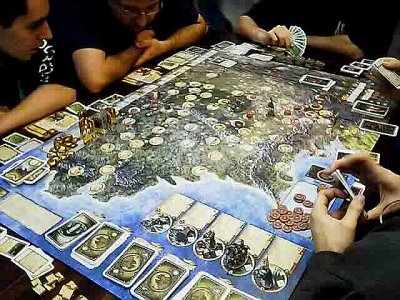 After this playtesting session I wanted to get moving around a bit, but after a few steps I ran into Greg Schloesser who just was approaching the LUDOART booth in order to have a closer look at Darwinci, and so I joined him to get a short introduction to the game by Frank "Czarne" Czarnetzki, the owner of LUDOART. In Darwinci each of the players is in charge of an archeologic dig excarvating skeletons, and the players will bid on tiles with skeleton parts which they can use build full skeletons. These findings actually do not need to take any kind of human form, but instead they can have a multitude of joints, and they may branch into several arm- or leglike structures. However, the players should not aim at going too, because an unfinished skeleton where still tiles could be added will not count for any victory points at the end of the game. Victory points are generated at the end by multiplying the number of tiles used to build a finished skeleton with the actual number of extremities of the skeleton. Thus, size and branches matter, but the question still has not be answered how the players actually acquire the needed tiles. For this the players receive a hand of two tiles at the beginning of the game, but instead of simply using a tile for his own skeleton a player has to chose one tile which he offers for auction in the current round. When all players have chosen a tile, the auction starts with the players bidding with nice auction tokens made of coloured stones. Of each player exists the same number of these tokens, but whereas all tokens of a colour are located in the prospective player's stockpile at the beginning of the game, the situation may be different in following turns due to the fact that a player who wins an auction looses some of his auction tokens to other players. These other player's then will be forced to use the tokens they have gained this way, but this mechanism ensures that a player who has received a benefit by getting one or more desired tiles will face a small detriment in the following round. Thus, this auction meachnism balances the game quite well. In addition, the player's also have the possibility to score victory points once with five different kinds of gemstones which can be found on each skeleton tile, but here a player must decide when he actually should make the scoring. Only one such scoring is allowed per turn, and if a player gets too greedy and wants to add more tiles before going for a scoring the game might end before the player succeeds in collecting all five scorings. The game offers solid entertainment without any really surprising factors, but the idea of the game certainly is quite unique. The topic of the unearthing of skeletons also has been realized with a quite headstrong graphical design which is the trademark of all LUDOART games, and so the whole product seems rather uncommon in comparison to many other abstract games on the market. As a matter of fact, here the chat with Czarne once again confirmed that this is exactly the line which LUDOART is inclined to follow - producing games with outstanding playing components and unusual themes. With this approach Czarne tries to stand against both the mainstream-type games and the increasing dumping prices on the market, and although this mission is somewhat lonely LUDOART established itself on the games market with several outstanding games over the last years, amongst them last year's great economic game Planet Steam. 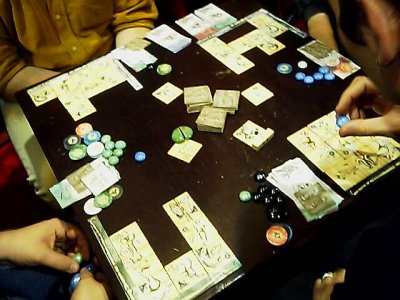 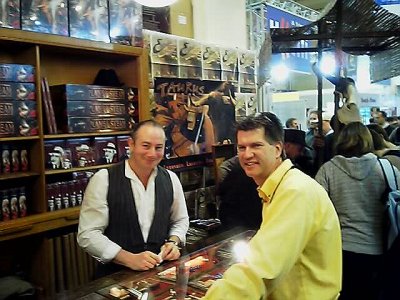 Greg and I then went for lunch in the restaurant of the convention halls, since we had scheduled our annual meeting of the International Gamers Awards committee members present at Essen. Thus, I met Mik Svellov, Ferdinand de Cassan, Andreas Keirat, Andrea Ligabue, Han Heidema, Knut Michael Wolf and Eric Martin, and we discussed some current issues on the IGA agenda.  Also scheduled for today was the awards ceremony of the International Gamers Awards, but since I had some time left before we would meet for the awards ceremony I went to check out a game expansion the release of which had been rumoured for a long time. The initial release by of Richard Borg's fantasy wargame Battlelore by DAYS OF WONDER had been followed quickly by half a dozen expansions, adding new unit types, cards for a customized troop buildup and additional scenarios. However, aAfter this initial firework it has become rather quiet around the game, and the silence grew even more profound when FANTASY FLIGHT GAMES acquired the publishing rights for Battlelore by the end of 2008. However, some of you might remember that two years back I had a meeting with a DAYS OF WONDER representative here at the SPIEL, and at that time I told you that a new kind of expansion for the game was in the pipeline, focusing on individual Heroes and their impact on the battlefield. And now, after a rather long wait FANTASY FLIGHT GAMES finally brings Battlelore back to life, and thus I was delighted to see that all myths were proven to be true: the Battlelore Heroes expansion has arrived, and I got a chance to scan through the rulebook and the box components in a quiet corner of the news show to give you some insights. 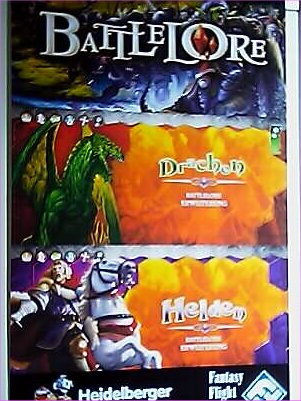 FANTASY FLIGHT GAMES is well known for their richly equipped fantasy games, and here the Heroes-Expansion is no exception. Thus, the small box contains 10 beautiful character miniatures, different skill and artefact cards and a collection of assorted landscape tiles and counters. Scanning through the materials, I could quickly discover that the ten miniatures actually fall into pairs presenting the same character both mounted and on foot, and so the players basically can chose their character from five different classes: the Commander, the Warrior, the Rogue, the Wizard and the Cleric. Once a character is chosen, the player is allowed to chose one skill for the character from a deck of skill cards corresponding to the class of the character. In addition, a hand of three artefact cards is drawn, and the player may chose one of these artefacts as starting equipment for the character. Finally, a character sheet is filled out, entering the information about the chosen skill and artefact and additionally adding infos about the character's combat capabilities (how many dice does he roll) and the number of wounds he can sustain. On the battlefield, a character either may join a friendly unit as its Leader or may move on his own as a Champion. These roles may change several times during the course of the game as a character has a possibility to join and leave units by ordering him with a normal order card to move onto or off a space occupied by a friendly unit. As you might guess, both of these roles are treated slightly differently considering the circumstances, and so a Champion is less restricted concerning his movement but is slightly more vulnerable due to his exposed position, whereas a Leader on the other hand inspires his unit to become bold but may not make an individual attack. Both types of Heroes share the rule that they can be hurt by an attack if the attacker rolls one or more "Sword on Shield" or Lore symbols, and each such symbol rolled forces the Hero to take a casualty check. To perform this check these dice are rolled again, and if at least one "Sword on Shield" symbol is rolled the Hero is wounded an incapacitated, removing him from the battlefield for the rest of the game and counting as a victory points for the opposing player. Overall, the rules for movement and combat have blended in rather well with the existing Battlelore rules, and so Heroes quickly can be handled without referring too much to the rules. However, so far nothing has been said about the different character classes, and here the different sets of skill cards play an important role. A skill which can be chosen by all characters is the "Riding"-skill, allowing the player to exchange his Hero figure for its mounted version and giving the Hero much better movement capabilities, but most of the other skills are unique to each class of Hero. Thus, the Warrior is a fierce fighter with good combat skills, the Commander can be best used for ordering troops and increasing morale, the Wizards and the Cleric have offensive and defensive spells and prayers and the Rogue can perform a number of sneaky activities. At the beginning of his career a Hero possesses just one skill card, but a Hero will collect experience for each battle he participates in. Additional experience can be gained by defeating another Hero or a creature or by completing specific quests set out in the scenario rules. For five experience a Hero may acquire an additional skill, and so a Hero may develop up to a maximum of three different skills, giving him considerable additional powers and his player a strong advantage on the battlefield. Likewise, additional powers may be tapped by acquiring and using artefacts, and apart from the initial artefact which each Hero receives at the beginning of his career additional artefacts may be gained by defeating another Hero, completing a quest or by opening a treasure chest. These treasure chest counters have been placed face down at specific locations as instructed by the scenario, and a Hero who spends a combat action at that location may search for treasure by revealing on of these treasure chest counters. His search may be rewarded by an randomly drawn artefact, but he may also find experience or treasure instead. Experience and treasure are recorded, and in difference to randomly drawn artefact cards a certain amount of treasure may be used by a Hero to acquire an artefact of his choice. A nasty find on the other hand is a trapped chest, and this kind of chest counter causes the Hero to roll a number of dice as a casualty check. Thinking about my old role-playing days, I remembered that characters tended to get stronger and stronger, making them nearly unstoppable for most apart from the toughest monsters. The possibility of Heroes to develop might stir up some fears of Battlelore losing its balance, but here Richard Borg has come up with a nice set of rules to get rid of too powerful Heroes. Thus, on the one hand the Heroes face certain limitations like a maximum of three skills and six artefacts (of which only two may be initially carried into a battle), and on the other hand a Hero will face exhaustion if he is wounded several times. Thus, each time a Hero is wounded he is removed from the battle and one of his wounds is crossed out. The number of wounds for a Hero ranges from three to five depending on his class, and under normal circumstances the wounds cannot be restored. Thus, a Hero who has faced several defeats will lose his last wound, and this results in the end of the Hero's career. However, such an end for a glorious Hero would be somewhat gloomy, and so there also exists a possibility to retire a Hero in a much more honourable way. Thus, a player may decide to retire a Hero who has learned three skills and who has gained three additional experience during his career, and as a reward the player will get an Advisor token matching the Hero's class. Taking the role as an additional advisor, the Hero now will take a place in the empty chair of a player's war council, increasing the Advisor level of the corresponding class advisor by one, but not counting against the number of battle levels listed in the scenario. From now on the player may use the Hero's advisor token to strengthen his battle council until he has been defeated five times. Then the Hero will be asked to step down from his Advisory position, becoming instructor at the player's military academy. And, as a final act, the Hero now will hand his most precious artefact to a new Hero who now may start his career with two artefacts instead of one. As you can see, I could not quite resist from going into details, but I was so taken by the care and details which had been put into this expansion that I simply had to tell you more about it. To my mind, the Heroes expansion is an incredible enrichment for the whole After this delightful break from the crowded halls, I left the news show and entered the main reception hall where people were gathering for the awards ceremony of the International Gamers Awards. Last year we had been up at "Saal Essen" for the first time and now too many people had found their way up here. However, this year a few more people had found the way, and I guess that even visitors might show up in the next years when the word finally spreads. 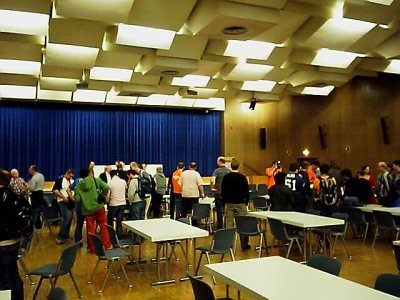 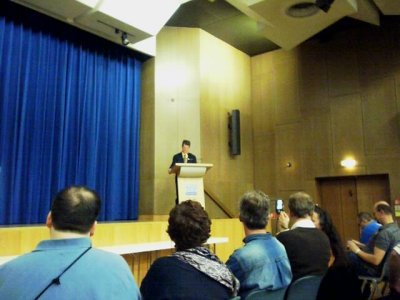 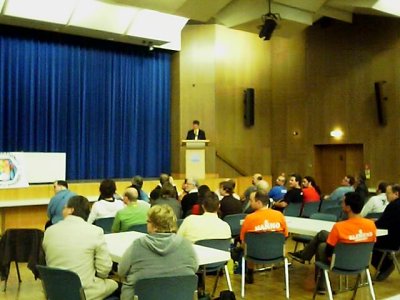 The winner of the International Gamers Awards 2009 in the Multiplayer Category once again was Uwe Rosenberg, and after his success with Agricola last year he now actually won the awards again with his great economic game Le havre. Both Uwe and Hanno Girke were rather happy for their small publishing house LOOKOUT GAMES to receive the awards two times in a row, and I also was rather happy with this year's winner because Le Havre actually offers a great, finetuned playing mechanism with production chains and lots of variation through ships and special buildings. 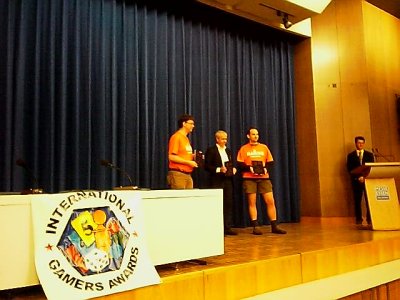 In the two player category another game from a rather small publisher had won, and here the surprise was even bigger because the favourite game of our jury turned out to by Day & Night by the newcomer team around Valentijn Eekels from MYSTICS. The game features a spendidly illustrated duel between the Ladies Day and Night, and the whole setting quickly captivates the players with a thrilling contest.  And, with only one chance to meet that many members of the IGA jury over the year, a photography of our present team also should not be missing. Standing in the background, you see from, left to right Mik Svellov, Han Heidema, Andreas Keirat, Scott Alden, Greg Schloesser and Eric Martin, and in the front there are Ronald Hoekstra, Ferdinand de Cassan, Knut Michael Wolf, me and Andrea Ligabue. A great team! 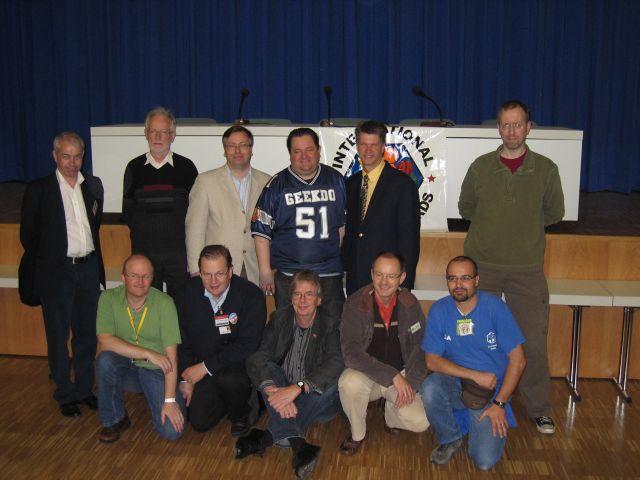 Before I continue my recount of the day, I would now like once again to play the pass along to Ralf whom I also met at the awards ceremony. So, let's see what games he had played at the SPIEL today… "Today my day begun at the booth from KOSMOS. As every year the booth of KOSMOS was very crowded and it was very hard to find a place to test a game. Of course the new game about the Lord of the Rings was the Eyecatcher, and I actually spied Kulk sitting there and listening to a walkthrough of the rules. Although I tried very hard I hardly could listen to the guide from KOSMOS who explained the rules to a lazy gaming round yesterday so that I left this game for Kulk." "Another new game from KOSMOS is the successor of the very succesful The Pillars of the Earth. Of course it is named after the new book Die Tore der Welt (World Without End) by Ken Follett. Wondering if the game could withstand the high expectations and would win me over, I tried to do a short test. I was very lucky when I found a table with only three players who just wanted to begin and I could join the group, supported by the guide who explained that the game would work much better with four players." "Again it were Michael Rieneck and Stefan Stadler who designed the game around the book. As citizens of the town of Kingsbridge we have to care for several matters. So we can edify several buildings or we are anxious about those in need and try to establish an effective medical supply. These actions and some more will give us victory points for the end. We do all this with the help of different cards." "Event cards that represent a special scene of the book are flipped every round and give some special actions that can be used in this round and the individual income of the players in our turn. Then every player plays one of his hand cards and puts another one aside. With these cards we can build, produce more building material, establish houses with an individual income, erect buildings or we spent money for a building, which give us bonuses if the building is finished. After all players have played a card another big round card is flipped over, new individual incomes are determined and then the player play hand cards again." "The game is played in several chapters, with six rounds each. At the end of each of each of the four chapters there is a check if the players have done their duty and have collected enough benefits, grain and money to satisfy the noble men and supply their families. If they can´t they loose victory points, of course. Then a new chapter begins. Beginning with the third chapter, the plague forces us to help other people and gives us new problems we have to master. I found the game very interesting, time moved quickly and we had a lot of fun in our round. In fact I even think it to be comparable with The Pillars of the Earth. Maybe it is less complex but the game works very well and give the players a lot of possibilities in their turns. The round cards that are flipped over give the game new possibilities at every round, so the players must react with their hand cards still left on their hands. All in all I think KOSMOS has created a worthy successor for The Pillars of the Earth." 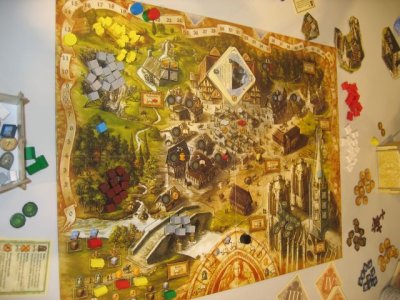 "After my first test this day I met our co-author Marco who had only this day on the fair, so time was precious and we hurried up to the next booth. This one was AMIGO, and here we had a look at the Deluxe edition of Sitting Ducks. In contrast to the original game (that was published in 2005) you get more and new game cards and a new designed game board. Again the ducks are in great danger, because some crazy riflemen try to shoot the lovely animals directly in the head (has something of an Ego-Shooter, too … so who needs Frag?) Again the ducks must be maneuvered down the row without being shot and the last duck alive on the sea wins the game. The deluxe edition brings the player a lot of new fun, because the cards allow new ways to target and shot ducks of the other players." "We then went to the International Gamers Award that was visited better than last year and there we found Kulk who was participating. After the event we shortly discussed our schedules for the afternoon, and we agreed to meet later on because Marco and I first wanted to check out another game which we had seen at the AMIGO booth. Thus, we returned there to play a round of Albion from Klaus-Jürgen Wrede, a strategic game of which you will need some rounds to fully understand the mechanisms. On a card of the British isle in the time of the Roman Empire, the players build settlements, castles and fortifications in different regions of the board. Only one building of each player in one region is allowed, so you have to be very careful where you begin your buildings. To build a player has to move one of his workers from the starting point to the region. Then he has to pay resources, one different one for every development of a building. And finally the Barbarians that are drawn randomly in the region must be defeated with the help of fortresses in other regions and soldiers that can be deployed with the help of castles. Other players who have a stronger building in the same region get some of the resources of the player, so it is always good to be the first player in a region. Resources can be produced in four different regions and here also a player can improve the production, if he walks there with a worker and spent some resources. What seems to be very easy, in reality is a very strategic game. In our testing round we did a lot of mistakes and at the booth they said that there a lot of different strategies to win the game. It is very important that you react on the moves of your opponents. So for me it is now difficult to decide, if the world is worth its money. I suppose that AMIGO is right and the game really improves with the experience of the players. If you only plan to play it by occasion and only seldom in a year, I am not sure, if Albion should be your favourite choice. If however you have a regular group and are looking for a game that wins with every new game, you should have a closer look." 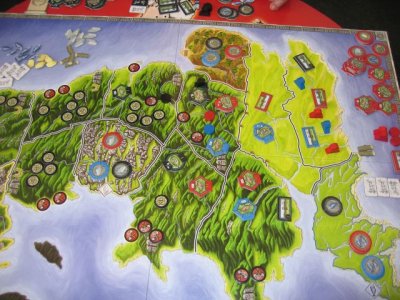 "Thanks to modern communication technology Kulk could find us later in the afternoon, and together all three of us went for the final playtesting of the day. However, I will leave it to Kulk to tell you a bit more about our joint gaming experience." "I will be here tomorrow again, now I am off to get some sleep. See you again, and back to Kulk..." Okay, it's me again, and now I would like to continue my afternoon report with some additional rather interesting games. One of the titles I had on my list of must-see games here for the show was Opera from the THE GAME MASTER, a publisher situated in the Netherlands and distributed in Germany by HUCH & FRIENDS. After a long development phase of three years (!) author Hans van Tol presents a game with a rather unusual topic and takes us back to the prime age of the Opera, with composers like Verdi, Bach or Mozart vying for the grace of their audience and the European monarchs. In this game the players take the role of noble families who want to patronise the further development of operas and composers around Europe, and during a total duration of nine rounds they try to spend their money wisely on generating income and victory points by performing operas in different cities. However, as all beginnings are humble, all a player possesses at the beginning of the game is 20 ducats and a small opera building in Venice with just one hall in which a composition of the player's house composer has been placed for performance. In addition to each player's starting equipment several other preparations need to be made before the game may start, and so opera buildings of different sizes and located in different cities are placed next to the gameboard, and on the gameboard a random ranking score showing portraits of the six composers relevant in the game is prepared. Cards for six different characters also are placed on the board, with the characters representing the six different actions which can be chosen during a round, and finally some random compositions are drawn from a pile containing compositions of all six composers. One composition each is placed on the rounds track after rounds three, six and nine (here an evaluation takes place), and an additional number of compositions depending on the number of players is revealed and placed on top of their corresponding composers. These compositions are available during the first round of play. Most important for the generation of victory points is the composers' ranking score on the gameboard. The position of the composers on the ranking score may change during the course of the game, and during the three evaluation phases the players will receive victory points for each composition they are performing in the main hall of each of their opera houses. The value of a composition is equal to the position of the composer in the ranking score, so that the best ranking composer will generate six victory points for each of his compositions performed in a main hall. In addition, each evaluation phase has been assigned a randomly drawn composition, and this composition marks the most famous composer at an end of an epoch. Compositions of these composers generate bonus points if they are performed in the players' main halls. However, as I have indicated earlier the players start with a humble one-hall opera building at Venice, and before they actually can think about a massive generation of victory points they first will have to generate enough income to invest into new opera buildings and the acquisition of compositions. This is done in the three rounds of each epoch, and at the beginning of each of these rounds the gameboard will be reset by revealing a new set of available compositions and by returning all character cards to their respective positions on the board. Comparable to other resource management games like Puerto Rico, the choice of the character cards determines the available actions, and usually not all six actions will be available during a round of play.
Hans van Tol has found an interesting innovation concerning the payment of the costs for recruiting the help of the characters, and instead of the players handling a plain and simple purse he uses a Budget chart as an intermediate step. At the beginning of a round all players have the possibility to add money to they budget for the upcoming round, and the markers on the Budget chart are adjusted accordingly to represent the investment of each player. A nifty Budget chart mechanism determines the player order during the round, and because of the fact that the use of the characters is paid out of the players' budget the player order may change when a payment is made. Thus, a player is not restricted to chose one character per round, but instead he may chose up to three characters if his budget and his position on the Budget chart allows. However, pumping money into the budget means that a player has less ducats available in his purse, and since all investments like compositions and opera buildings are paid out of a players purse a good balancing between the budget and the purse are mandatory. To my mind the long development phase has led to the creation of a very mature resource management mechanism which perfectly converts the chosen topic into the scope of a boardgame. The only other game which I can remember which puts the player into the role of an impresario is Wolfgang Kramer's Colosseum, but whereas the players in Kramer's game are depending on finding partners for a trade of resources the Opera players feel much more in control of their own fate. The game gets along with a low element of luck, and furthermore the possibility to participate if a player uses some of the characters also leaves some space for strategic planning while at the same time increasing (indirect) player interaction. Playtesting revealed a somewhat slow start because the mechanisms and possibilities for generating income and victory points first must be taken by all players, but since the mechanism is quite straightforward in its application it does not take long for an exciting contest to begin. The only element which first might seem to be a bit out of place is the final step in the use of the Esperto which requires a player to hand over his most valuable composition to the hindmost player. However, this act of balancing seems to be necessary since otherwise the game mechanics would be too unforgiving, and furthermore the Esperto would be too powerful if circumstances were convenient to grant a player his repeated use in several rounds. With this detail explained, Opera presents itself as a great strategy game with a rather innovative theme. 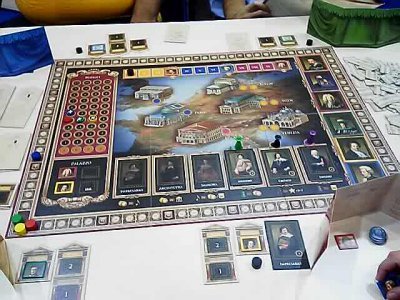 Afterwards I once again went to search some games which were rumoured to be released at Essen in the last few weeks before the show. However, I have met quite a few disappointments on this side, and so I had to find out that Rattus from QUINED WHITE GOBLIN, the Kutschfahrt zur Teufelsburg Expansion by ADLUNG, Governor's Daughter by KUZNIA GIER and Automobile by PHALANX all had not made it to the SPIEL. Talking to the publishers, all of these games will be released in the months to come, but for some titles it may well go into the next year before they will become available. The only game of which I could find a trace was Dakota from TENKIGAMES, but the only game they actually presented was a prototype of which not all parts were in their final form. 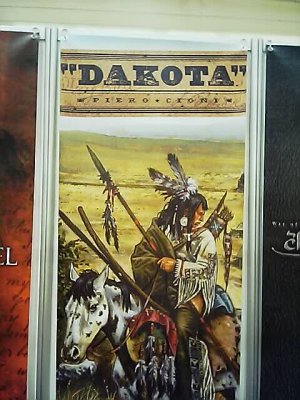 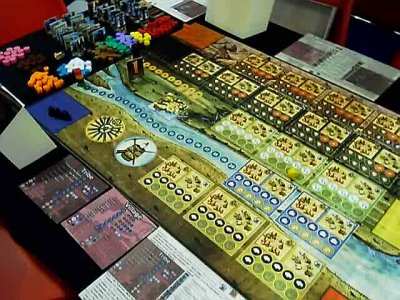 Having seen a beautiful display at the news show, I simply had to have a look at Tobago from ZOCH. This German publisher is well known amongst the ranks of gamers for his beautiful and atmospheric games which often offer unusual playing mechanisms. A splendid example for their high-class games is the SPIEL DES JAHRES awards winner Niagara, and today I would like to present you a game which seems to be going well on the same track, possibly even reaching out to get a chance to win Germany's most popular games award. Tobago is a game about treasure hunters on a lonely island. Coming in the regular square-sized ZOCH box, the players are invited to discover a great batch of nicely designed playing components: three parts of the double sided gameboard, wooden playing pieces of All-Terrain-Vehicles (ATV), palm trees and huts, and - last but not least - three stunningly nice miniature statues which were built long ago by the original inhabitants of the island. The topic of the game actually might suggest some kind of adventure boardgame with the players collecting equipment and surviving perils, but I was quite surprised to see that Tobago by no means works similar than GOLDSIEBER's Goldland, but instead it is a rather entertaining deduction game with a quite unique playing mechanism. Thus, during the course of the game the players constantly will cruise from one end to the island to the other, trying to participate as well as possible in the raising of treasures. However, ever new treasures are appearing, so that the winning of the game is not just based on a simplistic "most treasures wins" strategy. Before I tell you more about the raising of treasures, let us first have a closer look at the topography of the island of Tobago. Made up of a three-part gameboard, the island changes with every game, but regardless of the mounting of the board always a total of six different kinds of landscapes can be found: beaches, palm forests, scrublands, mountains, streams and sweetwater seas. At the beginning of the game the players also add three statues, three palm trees and four huts as additional landmarks at randomly chosen spaces of the island, and so the players will find a new layout of the island with every game. Starting with their ATV on a space of their choice, the players may opt to use their turn to move their ATV for up to three legs, with each leg of their movement consisting either of a change of terrain or by moving as far as they desire on the same kind of terrain. Depending on the island layout and the chosen course, the ATV can be moved pretty far or only for minor steps, but much depends on a player's keen eye to chose a movement path best matching the current opportunities on the gameboard. 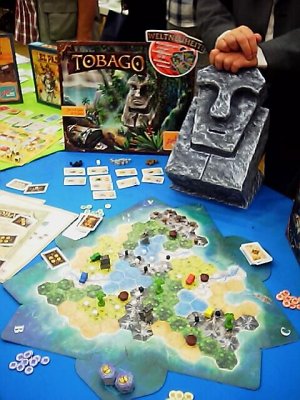 It is the aim of the players to get their ATV to spaces where treasures are buried, and it is the question how to find out where a treasure is buried on which the main playing mechanism of the game is focused. For this reason each of the players possesses a hand of clue cards which form fragments of a treasure map, and these clue cards usually refer to one type of landscape or landmark on the island. Thus, a clue card may tell that a treasure lies buried NOT in the mountains, adjacent to a hut, at the beach, within one or two spaces of a statue etc. All clue cards have in common that no single space containing a treasure can be identified with a card, and so several clue cards need to be combined until one (and only one) space can be identified where a treasure is buried. During his turn a player may refrain from moving his ATV and instead play one of the clue cards from his hand, and he may add his clue card to one of four different treasure maps. As indicated, there will always be four treasures available simultaneously, and so the players jointly can build at several maps in order to narrow down the possibilities where a treasure may be hidden. Whenever a player adds a clue card to a treasure map he may place a compass token of his colour on the clue card to indicate that he has placed the card, but a clue may only be placed under the condition that it will narrow down the number of available treasure sites while at the same time not preventing the raising of a treasure completely. As the possible locations of a treasure become more and more restricted there comes a time when a set of wooden cubes marking possible treasure positions comes into play. Thus, each available treasure map is assigned a number of matchingly coloured wooden cubes, and when the time has come that the position of a treasure has been narrowed down enough all remaining possible treasure sites will be marked with wooden cubes. From now on every player who adds a clue to that specific treasure map has to remove all cubes from spaces where the treasure cannot be hidden anymore, and so the final positioning of a treasure will be visible once only one cube of the treasure's colour is left on the gameboard. Now the players will use their ATV to get to the treasure's position, and the first player to arrive will be allowed to put one of his compass tokens at the bottom of the treasure map and to proclaim the treasure to be raised. This starts the treasure distribution procedure, and now the player who is raising the treasure and those players who contributed cards to the particular treasure map will participate in the distribution of the treasure. However, once again author Bruce Allen has refrained from using a simple distribution procedure, but instead the players will be put to a small speculative challenge. Thus, each player is allowed to draw as many treasure cards from the mixed pile as he has compass tokens at the treasure map, but the players are not allowed to keep these cards but they just get a chance to look at their values. Then all cards are collected, and an additional card is added from the pile treasure cards. These cards are shuffled and the first card is revealed. Following the order of the compass tokens at the treasure map from top to bottom, the players now have a chance either to claim that treasure card or to pass. If a player passes the next player is asked, and if nobody wants the treasure it is discarded. If a player decides to keep the treasure when he is asked, he takes back his compass token and gets the treasure card. The treasure distribution then continues with the remaining players, until either all players have received a treasure for each of their compass tokens or until the treasure cards are used up. As you can see, the players retain a minimum degree of control as to which treasure cards they might get, and their partial knowledge about the whole haul of treasure cards gives them some indication whether a treasure is worth keeping or if it should be passed on. Such a mechanism gains additional thrill if there is a risk involved, and in Tobago there is a risk that the players actually might reveal a cursed treasure. If such a card turn up, all remaining treasure cards for the current distribution are discarded, and furthermore each player who has at least one compass token left on the treasure map must discard his most valuable treasure card. However, the risk of such a malady can be avoided by players possessing an Amulet, and so an Amulet can be discarded instead of the valuable treasure card. Amulets are relics of the former inhabitants of Tobago, and they appear whenever a Treasure is raised. At that instance an Amulet is placed in the line of sight of each of the three statutes, appearing at the last island space before the ocean. After the three Amulets are placed, the statues mysteriously start to turn, changing their orientation by 60 degree and waiting for the next treasure to be raised. In a way, the Amulets are a rather Omni potential cure to different situations in the game, since apart from their curse-avoidance-functions they can also be discarded to play an additional clue card, give the ATV an additional move, exchange the player's hand of clue cards or even to remove a treasure cube. Especially this last option is rather powerful when a treasure's position has been narrowed down enough to gain decisive influence on its final position, and thus the players should not underestimate the usefulness of the Amulets. The game finishes on a more traditional way simply when the deck of treasure cards runs out, and the player with the most valuable treasure cards will have won. However, as you should have seen during this short description, the task of getting the most valuable cards is a matter of timing, generating possibilities and speculating on treasure cards, and thus the idea might come up that it might be much more important just to play as many clue cards as possible than to actively raise a treasure. However, such a strategy does not seem to yield success, since it disregards the fact that the distribution of treasure cards upon the raising of a treasure depends on a "last-served-first" order, thus giving the player who raises a treasure a first pick on the appearing treasure cards. This is a position of considerable power, and thus players who randomly add clue cards in the hope of getting to participate more often than others usually will only receive less valuable treasure cards. I think this observation is rather important since it ensures that the game cannot be highjacked by "strategists" who claim to have seen through the game's basic principles. Quite the opposite, the game gently pushes the players to actively find the best possibilities by playing clue cards and moving their ATV, and coupled with the numerous uses of the Amulets the players are presented a rather entertaining and challenging playing mechanism. Coupled with ZOCH's typical rather attractive graphic design, Tobago is a great family game and for me a hot candidate for the next Spiel des Jahres. 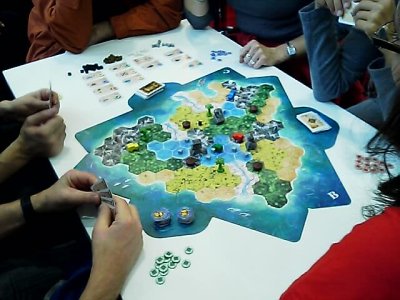 With this long day at the SPIEL drawing close to its end, I made a phonecall to Ralf and Marco, and together we went for a final stroll through the halls to look up some games which we might cover tomorrow. However, we were lucky, and so we actually got seats for a playtesting round of Ants! For Queen & Colony at the one and only playtesting table of TWISTED WINDS. This newcomer company from England only was able to produce 150 copies of their new ANTagonistic game, and so the three of us sat down with ANTicipation to get the game explained to us by the designer Theodore Aitken. Also present at the booth was Colin Wheeler whom I knew as a used games trader here at the SPIEL with his small company 2ND GAMES GALORE having specialised in some hard to find older titles. However, these days are over for Colin, and so he is now helping his friend Theodore with his new game. 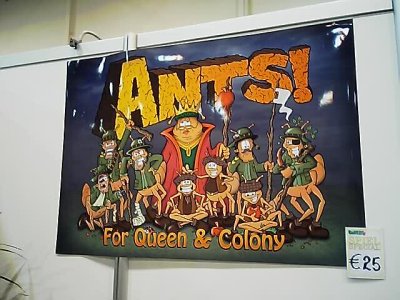 In this game each player takes control of an ant colony, all of which are located at the outer borders of a small park consisting of hex spaces. At the beginning, the Queen is the only playing piece present at each player's anthill, but there is also a decent reserve of food tokens which the Queen can consume to produce new ants. Being a real TyrANT, the Queen needs her trusted subjects for different kinds of operations, and so the small PeasANTs (one food each) are in charge of the food acquisition, whereas the SergeANTs (cost of two food) are responsible for military operations. A maximum of six food can be consumed by the Queen each turn, and in the first few rounds the Queen mainly will focus on producing Peasants which will start to move towards the food reserves available at different spaces on the playing area. The movement rules are designed quite antlike, with a Peasant normally being allowed to move just one space. However, if an ant makes a move through an unbroken supply chain of Peasants, the ant may end its move at any space adjacent to that supply chain, and so great distances may be bridged by moving ant after ant and extending the chain. Food is collected by Peasants standing next to food tokens, and the player is allowed to move the food disks through an unbroken supply chain directly back to his anthill where the Queen is waiting. Once there is a sufficient number of ants on the table, food will get scare and so the first Sergeants will appear. These ants may move for two spaces, but once again they also may use an unbroken supply chain for one step of their movement. If a Sergeant runs into Peasant's or Sergeants of another player, a battle will ensure. The result of the fight is determined by rolling dice, but the Peasants actually only are allowed to roll a dice which offers lower results. However, as numbers also matter, Peasants from neighbouring spaces may be brought in to join the defender, and all their results will be added together. Thus, several Peasants stand a higher chance to beat a Sergeant, although the Pesants usually will be lost in this process since for each individual dice result lower than the roll of the Sergeant a Peasant must be removed. All players aim at getting a Sergeant into other player's anthills, and there a Sergeant will have to face the Queen against which another combat is made with both players using equal dice. If the sergeant wins, the player whose Queen has been beaten drops out of the game, loosing all food reserves to the player of the heroic Sergeant and removing all ants of the perished tribe from the table. Thus, the game cannot avoid players to drop out from a certain stage onwards, and the winner will be the player in control of the last surviving Queen. Action in the playing area is spiced up by the Park Life cards which are revealed at the beginning of every player's turn. Such cards list different events from the dropping of food remains to small bugs or even a human footstep. The hex(es) where the effects of the Park Life card takes effect is determined by the active player looking at his hand of three randomly drawn Park Space cards. Each of these cards list the coordinates of an individual park hex, and the player may use any of his three cards to activate the effects of the Park Life card there. He will receive a replacement Park Space card afterwards, so that he will have a hand of three cards once again at his next turn. As indicated, the Park Life cards offer different happenings, and if there are ants of the chosen space(s) these usually will be removed. New food reserves then can be collected the usual way using the Peasants, whereas bugs and worms first need to be killed by a Sergeant before they can be turned into food. Of real danger are human footsteps or a bird, since these events are activated on a space and all surrounding spaces, and thus they can lead to a rather devastating setback. Although one testing game probably is not enough to judge this for certain, there might be a chance that some Park Life cards actually are too strong if they are revealed at a crucial moment and if a player possesses the right Park Space card to cause some mischief. In addition, the solution of players dropping out of a game always is a bit unsatisfactory, since the last two players in such a game might be on equal terms concerning ants and food, and so a long standoff phase might be feared before the game comes to its end. However, the latter risk is well avoided by the fact that a Sergeant can continue to attack in the same turn as long as he survives, and so I could witness defense lines to be broken quickly if luck sides with the attacker. 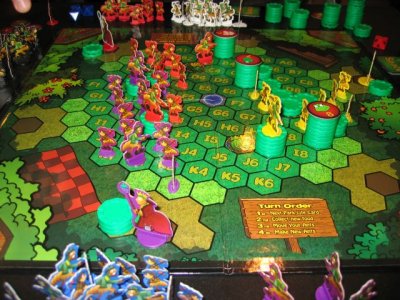 The game offers rather fitting comic artwork, and Marco, Ralf and me really enjoyed our final battle of ANTietam for the day. Most importantly, the game is rather fin to play, and since the rule structure operates rather smoothly ANTS turned out to be a rather interesting variANT of classic conflict games. For me, the exotic topic and the cute graphics really rounded up a nice game, and so one of the 150 copies which where available here at the show went home with me. And now, as a final extra for the day, here is the next Dominion card! 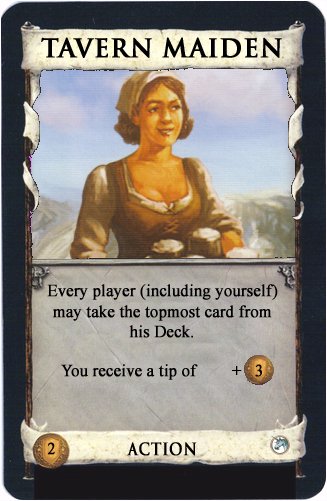 Well, it has been a long way today. Thanks for keeping up with me and see you tomorrow! And also thanks for all the nice commentaries in my guestbook! This is really a great read for me after finishing my typing. It helps to get the motivation to carry the whole thing through!!! Cheers, Frank Saturday, 24th of OctoberIncredible, it's Saturday evening already, and once again time seemed to fly by over the last few days. But no further pre-bantering today - you are here to hear about some games, and I promise that I have played one or two really thrilling titles! A rather uncommon topic to be implemented within the scope of a "normal" boardgame is the siege of a castle. I am used to this theme both from the areas of tabletop wargaming and from Cosim games, but I cannot remember that I have actually seen a siege scenario played as a boardgame with a decent degree of complexity and playing duration. However, as it seems the Polish PORTAL design crew around author Ignacy Trzewiczek has seen both the potential of the theme and the lack of available siege games, and so they have chosen to create Stronghold, a siege game in which a horde of Trolls, Orcs and Goblins is trying to break into a castle defended by a bunch of frightened Humans. Thus, I once again teamed up with Christian Leonhard, and together we went to get and introduction to the game. And we were lucky, since it was the author Ignacy Trzewiczek himself who taught us how to deal with the horde of monsters. The real eyecatcher of the game is the big, colourful gameboard which depicts part of a castle with walls, towers, courtyard and buildings, and a part of the outside area with the foregrounds and ramparts used by the attacking horde. At the beginning of the game no attackers are present on the board, but the castle is bustling with life. Marksmen, soldiers and veterans (coloured cubes) are manning all walls of the castle, and each wall section also has received a grey playing piece to represent the still intact wall. Quite a lot of markers are placed at hand both by the attacker and the defender, but most important to note at this point is the fact that all unit cubes available to the attacker (60 Goblins, 100 Orcs, 40 Trolls) have been placed in a opaque bag. During each turn the attacker will draw 14 cubes from that bag, and he will use these units for strengthening his siege. 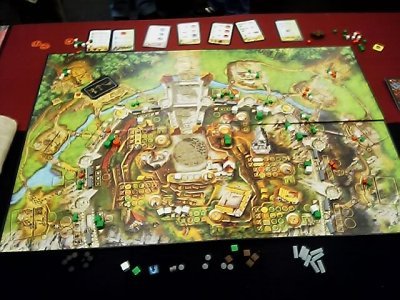 A turn of the game is broken down into 6 organisational phases in which both the attacker and then the defender act, and after the 6th phase an assault takes place in which the combat situation at each wall section will be evaluated. Should the attacker succeed in the assault to break into the castle at one wall section, the outer defences of the castle have fallen and the game will end after the turn is over. If the assault was not successful, the game will proceeded to the next turn, continuing until the end of the 10th turn after which the defender will have won by default. As indicated, the attacker receives 14 units from his bag at the first phase of each turn, and then he may decide what he wants to do with the units during the phases of this turn. As might be guessed, the units may be used for sending them towards the castle, and indeed the 6th phase allows the attacker some troop movements. Thus, for one dispatch order a fixed amount of troops may move one step from camp to a foreground, from a foreground to a rampart and from a rampart to a wall section. These movements are cumulative so that units from any of these locations may move forwards one step, but the accentuation here lies on the word "forward". Thus, a unit normally may not move backwards or sideways, and due to the roots-like structure which links one camp, two foregrounds, seven ramparts and nine wall sections a unit becomes more and more fixed to a certain wall section where it will fight. This already illustrates the fact that the attacker is in a demanding position of strategic planning, since he needs to plan his movements and attacks in advance because short-time reactions are nearly impossible if it usually takes three turns for a unit to move from camp to a wall section. However, the movement of units only is the sixth phase of a turn, and before this all other phases need to be played through. All six phases share the common fact that any action taken by the attacker takes a specific amount of time, and so the attacker has to hand the defender a certain amount of hourglass tokens for any action he takes. After the attacker has finished his actions in a phase, the defender is allowed to spend the hourglasses for actions of his own, organising the castle's troops and using the castle buildings to produce defensive machines. However, whereas the defender has the same choice of available actions in each turn in every game, the attacker only has a limited amount of actions available for each phase. The rules actually list a broader choice of actions, but not every action will be available in every game because a specific set of phase cards was shuffled before the game, and the attacker was dealt a card for each phase, listing him his available options for a phase. Still, time is not the only commodity which the attacker must pay to perform an action, and so each action also takes a specific amount of resources and labor to be performed. Labor must be paid for by discarding units, and depending on their fighting strength (Goblin = 1, Orc = 2, Troll = 3) the attacker must discard some of the units which he has drawn in the first phase. Thus, the pool of available troops to move onto the gameboard is declining with any action the attacker performs, and so he needs to balance his need to arm against the need for units acting as fighting troops. Resources on the other hand are gained for free in the first phase, but here the attacker also faces a limitation, and although the allowance may be increased by discarding an unit, the attacker must use his resources wisely. In the phases two to four the attacker may spend time and units to build war machines, to produce equipment and to train his units. The rules list a variety of available options for each kind of action, and so the game knows war machines like the catapult, the ballista or the siege tower, equipment like ladders, banners or shields, and trained specialists like a fire master, a quartermaster or a drover. Tokens for all of these may be placed at different places on the gameboard, and so war machines usually are placed at the foregrounds or the ramparts, whereas training tokens must be placed at the ramparts and equipment at a wall section. As a result, training and equipment tokens are not associated with a specific unit, but instead they provide certain benefits to any applicable unit at that place, e.g. a fire master gives goblins at his rampart a possibility to conduct ranged combat or a drover allows the (otherwise prohibited) movement of units to an adjacent rampart, whereas a banner increases the total fighting strength of the attacker at a specific wall section by one or a ladder allows the attacker to place one additional units at that wall section. War machines which may be used for ranged combat are treated as a speciality, and so the attacker constructs a deck of two hit cards and five miss cards which he shuffles and places next to a newly constructed war machine. Whenever the machine fires, a card from the deck is revealed to determine whether the machine has hit its target, and whereas any miss cards are discarded after the turn, all hit cards are shuffled back into the deck, thus symbolizing the growing experience of the machine crew with its machine. In contrast to the already mentioned phases the fifth phase may be used by the attacker to have his Shaman conduct temporary rituals. Thus, the attacker may decide to sacrifice a bunch of unfortunate Goblins (on an altar constructed in phase two), and for this sacrifice the attacker gains a specific action which will hinder the defender for the ongoing turn. The effects of the rituals range with their goblinoid prices, and so they may hinder the movement of the defender's units, make the usage of the castle buildings more expensive (in terms of time consumption) or even may lead to a backfiring accident in case the defender has installed cauldrons at a wall section with unit cubes. As indicated, the sixth phase of a turn may be used by the attacker to move the units remaining in his stockpile (camp) onto the gameboard, and those units already on the board may be moved a step towards the walls. The amount of troops which can be moved off each space depends on the dispatch order chosen by the attacker, and once again the size of the dispatch order determines the amount of hourglasses which the defender may take and spend during that phase. In addition, the attacker also may spend an hourglass to issue some additional orders, and these orders may be placed face down next to one or more wall section, and they result in suicide missions for certain units or the arrival of an additional Troll from the ramparts. But what can the defender do against the seemingly overwhelming might of the attacker? The sheer numbers alone seem very discouraging, and whereas the attacker has a total of 200 units in his bag the defender only has a meagre garrison of 41 units of which nearly all marksmen and soldiers are manning the walls at the beginning of the game. However, even though the odds seem to be clear, it must be kept in mind that the attacker needs to spend units in order to arm his troops with war machines, equipment and training measures, thus reducing the amount of troops available for fighting. Due to the time limit of 10 turns the attacker has to hurry both to arm up and to send troops towards the castle, and although he has some options to speed up the movement of his troops these options create hourglasses for the defender, and a good stockpile of hourglasses means that the defender can spend time on the creation of nasty surprises for the attacker. The defender's most common use of hourglasses is the reorganisation of his troops by sending them to the different wall sections, but more interesting actually are the options provided to the defender by the different castle buildings. Thus, the forge can create cannons which will be installed on the castle towers or cauldrons against the different classes of attacking units which will be mounted on wall sections. The workshop of the other hand can reinforce the walls or the castle gates with wooden structures, and it may also be used for erecting platforms next to a wall section in order to make more space for defending units. A nuisance for the attacker are the scout headquarters and the cathedral because both of them offer the defender options to annoy the attacker, and so siege machines may be damaged by adding additional miss cards, traps may be laid for attackers units, sharpshooters can take out a specific unit and even a wall may gain an unearthly glare which deters the attackers for a turn. Regarding the strength of his troops, the defender's units have the same strength ranges as the attacker's (marksman = 1, soldier = 2, veteran = 3), and troops may be sent to the barracks to train them to go up a level. On the other hand all units wounded in a turn are placed at the hospital, and at the end of the turn two of these troops return to active duty on the courtyard whereas all other units still remaining in the hospital must be discarded. Leaving the hospital aside, the actions in all other castle buildings must be paid by the defender in form of hourglasses, and here the restriction applies that the defender immediately must spend all hourglasses which he has gained after each of the attacker's phases. Thus, quite often the situation occurs that the defender has not enough hourglasses to finish a certain type of action, but since he is not required to finish the action within one phase hourglasses may be collected at any of the castle buildings. Such a collection of hourglasses actually represents the stepwise creation of a defensive measure or machine, and this rule may be used to the defender's benefit since he can prepare some measures in a way that they only need one more hourglass to finish. This gives the defender some possibilities to react quickly if he sees the attacker take a certain strategy. Worth mentioning on side of the defender also are his two heroes - the warrior and the officer. Both of these characters may be moved between the different wall sections, increasing the total strength of the defender at that section. However, both of them also have a special ability which can be triggered by the use of hourglasses, and whereas the officer can hold a speech which increases the defensive strength at that wall section by up to four points, the warrior can make an excursion to kill one of the attacker's units at his wall section. Each turn comes to its climax when the six organisational phases are over, and in the following assault the players first will use their ranged weapons before melee takes place at each of the castle's wall sections. Ranged combat is conducted by war machines and castle marksmen which are not occupied in melee, and usually these weapons inflict unit losses on the other side. However, the attacker's war machines also may result in the removal of castle walls, and on the long run the breaking of the castle's structures will weaken the defender's position. When all ranged combat was conducted, the strength ratios of the attacker and defender will be determined at each wall section, and here several factors are taken into consideration. Apart from the strengths of the units fighting at a wall section, the attacker adds up additional points for a banner (equipment), Goblins' rage (an order) and for a Shaman's ritual. The defender on the other hand adds to his unit strengths one additional point for each stone wall or wooden wall reinforcement plus additional points for a Hero present at that wall section. Both totals then are compared, and the player with the higher total wins the melee at that wall section, forcing the looser to discard units with a value corresponding to the difference between both strength values. This process is repeated for each wall section, and if any wall section is left without defense (units and walls) while the attacker still have one or more points of the strength difference left, a breach occurs which means that the game will end after the turn. In this case all other wall sections still will be evaluated, and then the final victory will be determined. Success in Stronghold is measured by the use of Glory points, and here the author has thought of a quite interesting system of how Glory points are awarded or lost. Several factors work together, and most of them will be recorded in form of cube-shaped markers on a Glory-board which depicts some colourful illustrations of different game situations.
Some other elements also add to the game's atmosphere and playing depth, and most prominent among these are the rules for the battering ram which the attacker may construct to break the castle gates or the card decks which are assigned to each war machine. It is a nice twist that these machines home in on their target by discarding miss cards, while at the same time scouts of the defender can sabotage the machines by adding additional miss cards. Another nice possibility is the attacker's option to turn one or more of his phase cards permanently onto their backsides, thus loosing the normal actions associated with a phase but giving the player some bonuses for the final assault on the castle. This contributes to a feeling that the game is progressing towards its climax and fits in with the touch of following a background story which is created by the Glory board. A bit of a strange feeling at first is created by the observation that war machines, equipment and training purchase by the attacker cannot be removed by the defender during the course of the game. However, this rule actually is needed to prevent a constant stalemate with the attacker purchasing something and the defender promptly removing it, so that the rules now require each of the players to develop his own strategy how to react to the opponent's measures. Due to the unique set of options available both to the attacker and the defender the positions of both are rather different considering the skills demanded of the players. While it is rather nice to imagine the scenario of a brutish Orc-Lord sending his merciless horde against the castle of the steadfast King, the actual roles of the players make Stronghold a battle of skills between a dispatcher and a firefighter. Especially in the first few games the defender should be in a more comfortable position, since the game's time limit is ticking down in his favour and he is in the comfortable position to adjust his reactions to the actions chosen by the attacker. The attacker on the other hand faces the greater challenge in terms of strategic planning, since he must use his available options to arm his troops while at the same time organising the assault on the walls. A good timing is absolutely crucial, so that all elements of the attack can work together like a clockwork in order to beat the pitiless time limit. If a major assault fails in the second half of the game the attacker will be hard pushed if he wants to recover, and since he also has to keep an eye at the stream of Glory markers going over to the defender's side of the Glory board the attacker's general position is much more demanding. The gameboard and the playing components provided by Portal are flawless, and after being introduced to the rules by a highly enthusiastic Ignacy Trzewiczek the playing of the game posed no real threat despite the somewhat long rulebook. It's great to meet an author who actually lives his creation with so much spirit, but even if Ignacy is not available the rules seem manageable so that the initial hurdle can be taken, and once you have done so you will be rewarded with a rather interesting strategic challenge. 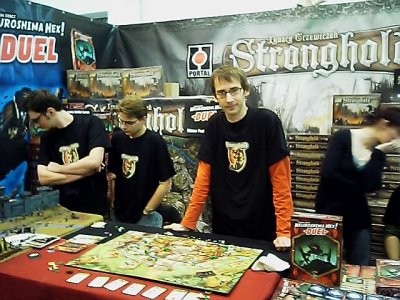 Later on I received a phonecall from a friend who had successfully organised me a box of Z-MAN's new version of Tales of the Arabian Nights, and after collecting the game I couldn't resist to sit in a quiet corner for a bit of time to scan through the gamebox. The original game of Tales of the Arabian Nights dates back more than 20 years, and this adventure game always has taken a special place in many collections due to its rather unusual playing mechanism, and so I was happy finally to get hold of an enhanced new version of the game. On first sight the gameboard looks like a typical adventure game, with Arabia at its center and towns an places of the European, Asian and African continents settled around it. The players take the roles of adventurers named after different characters originating from the "Tales of 1001 Night", and they travel around the gameboard to solve different kinds of adventures and collect a mixture of Story points and Destiny points which both are needed to win the game. However, whereas fantasy classics like Talisman are rooted in a simple card drawing mechanism to find out which kind of adventure the player meets after his movement, the adventure section in Tales of the Arabian Nights is much deeper and enriched with story elements. As you might guess such a playing depth cannot be reached by simple playing cards, and so the author has found a way to cleverly integrate a paragraph-based adventure game book within the scope of this boardgame. So, a player actually draws a card after he has finished his movement, but this card lists an event and several different paragraph numbers which now could be applied. This correct paragraph to read is determined by the terrain occupied by the player and the phase of the game, and then the gamebook is handed to another player who will read the paragraph to the active player. Such detailed texts offer much more atmosphere and detail than anything which could be found on a mere playing card, but at the same time you might get some suspicions as to how far the replay value of such a game might go. Here the author went at least two steps farther then the authors of the old adventure gamebooks, since the finding of the matching paragraph is a more complex matter than just the drawing of a playing card might suggest. Thus, the first paragraph indicated by the card usually lists 11 different personalities and events which a player might meet, and the correct personality or event is found by adding up a diceroll and several other scores like the player's current score of Destiny points and his position on the gameboard. This leads the player to a reaction matrix, listing out several kinds of actions how the player might wish to react to the event or personality, and once the player has decided for an action it is cross-referenced with the event or personality to gain another paragraph number. And now, as a final step, a Destiny dice is rolled in order to see whether the final paragraph to be read either is the exact number or the following higher or lower paragraph. Sounds complex - doesn't it? And it is exactly this complex method of paragraph finding which is needed to guarantee a high replay value due to fewer repetitions of paragraphs. On the other hand, the method takes a bit of time, and this slows the game down considerably especially if it is played with four to six players. In comparison to the last German edition of the game a bit of streamlining has been done in this new English version because the adventure cards are simply drawn and not played by other players, but otherwise it seems that the main adventure mechanism with cards, reaction matrix and adventure book has remained virtually unchanged. Considering the possibilities of the Yvio boardgame console you might actually wish for an electronic device which shortens this process of decision making and paragraph finding, but if you abstain from using any technical gadgets the mechanism which is presented here gives access to a very intricate gridwork of story elements. Even the paragraphs themselves are not streamlined, but instead the different skills collected by each player in the course of the game are taken into consideration, and so the paragraphs usually list different endings (and rewards!) depending on the question which skill comes to bear. However, the new edition of Tales of the Arabian Nights has made a great leap forwards in terms of design and rules presentation, since the fitting, colourful artwork and the rather well presented rules are optimal starting conditions for embarking on this entertaining fantastic voyage. Talking about the rules, I just checked the website of Z-MAN GAMES and it offers a download of solo-rules, Merchant-rules and a Storytelling-variant which all were available with former editions of the game, and so the general likeness of the older edition is retained. Overall, I can recommend this game for players who would like to play a somewhat unusual adventure game and who are willing to invest a bit of time, but you should be aware that here more than in other games the real entertainment lies in the mere participation and not in winning. 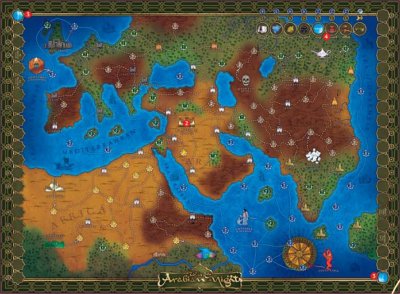 In the following time I went for some meetings with press representatives, but before I will tell you something about a rather interesting interview let's have a look at what Ralf was doing today! "Hello again. Today it was my third day and I am feeling tired by and by. But no excuse, the show must go on. To my surprise the fair was not as crowded as the last days, so probably a lot of the younger player took their chance to visit the convention during the week, because of the school holidays. Today I went to the convention with my wife, so we focused more on the light-weighted games and on games for children though my son is still a little bit too young for most of the games. Nevertheless I did some tests of the other games, too and I will give you a short impression of what I saw:" "Our first stop was at the booth of GOLDSIEBER where we tried the game Pizza Palletti. The game comes in a pizza box that looks were nice. The aim of the game is quite easy. Three different orders of a pizza are placed beside the board at every time. Each player has its own delivery boys, one on a bicycle and one with a car. All players can deliver the pizzas to the houses, but not before they have collected the right ingredients. So for example, for an order of a pizza funghi, we need the dough and for the toppings mushrooms and cheese. The ingredients can be collected in the town. The players roll three dices in a turn. The bicycle can use one dice and the car two dices. To get the ingredients you have to drive to special warehouses in the town. Reaching the right warehouse (there is only one ingredient per warehouse) you can buy one to three ingredients. One ingredient cost one euro, two three and three ingredients cost six euros. When you have collected all ingredients for one pizza you can deliver the pizza and there you get the prize given on the card. If you have rolled 13 or more you may put a barrier somewhere in the streets and you can block the delivery boys of your opponents. After all pizzas of the game are delivered the player with the most money and the most delivered pizzas wins the game. Pizza Palletti is a nice family game. We played several rounds and understood the game mechanism right from the beginning. Blocking an opponent with the barrier is a very useful method to get an advantage and to get a chance to deliver a pizza, although your opponents seem to be closer to the orderer of the pizza. The lovely design contributes to the good atmosphere of the game." 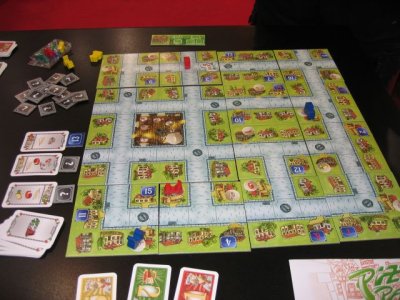 "After that we went over to the booth of HANS IM GLÜCK to try Car(d)cassonne. The game adopts the theme and also a lot of the mechanisms of the famous namesake. The biggest difference can be deduced from the title. In this variant the cities, monasteries, streets and meadows arise with the help of cards. Cards have to be placed in the corresponding rows with the same colour on the gameboard. The number of cards in a row determine the worth of the row, the longer the more valuable it becomes. But not before a player chooses one of these series of cards, victory points are given to the players. So you always have to decide whether it is wiser to wait a round to make the row longer and thus more valuable or to try to get the victory points directly by placing a Paladin at the end of the row instead of playing a card. But in the first case it may happen that your opponents think that the row is valuable enough and end the row with their Paladin. Scoring takes place when all players have played their cards from their hand and have placed their Paladin. Then the safe cards in the rows of the Paladins are given to the corresponding players. Each type of a card contributes to the scoring differently and so it is not too easy to survey which row will give the most victory points in the end. This is even more complicated, because the type of the building cards is scored not before the end of the game. Then you should have as much different coloured buildings as possible. The game flow is quite fast, even faster than in the original game. Even if I were already a little bit fed up with more and more variants of the game, I have to admit that Car(d)cassonne got me back to the table again. This is due to the fact that - although the game is related with Carcassonne - it has its own charm that cannot be compared with the original. But it is not for sure that you will like Car(d)cassonne only because you love the original. So I advise you to have a test before you buy the game." 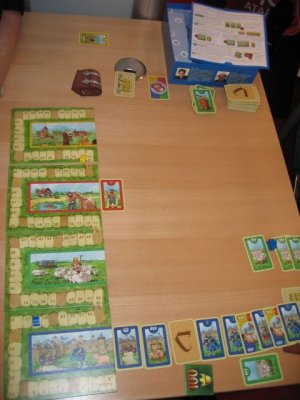 "My wife and I went different ways after this, and so I had a chance to go the small publishers once again. At Z-MAN GAMES I did a short test of SkyLine 3000. The game mainly is about erecting buildings in the space in different areas on a game board. In a turn the players, by playing cards out of the hands, can first build new flats on their own board, then they can put a roof on their buildings, which finishes it, and finally they can place their finished buildings from their board to the general board in one of the different coloured areas. Of course all this is only possible if you have the right cards. So with a red placing card, you are only allowed to play a building in a red area. This phase goes on until every player has passed. Then there is an auction for two Greenfields that guarantee victory points if they are placed in an area where you have the majority of flats. Another auction is for a spaceboard or megamall that can be placed in the areas too and gives the leader two more cards in the next phase or it the latter additionally can double the victory points for an area. You have also the possibility to place a billboard in one area, enticing customers and preventing other players to set a building on this field. This can frequently save you the victory points for an area. The auction is also done with the hand cards with a specific value indicated on each card. Only the winner of an auction must give his cards away, so one should be careful, because otherwise he has only very few cards left for the next phase. Finally in a round the players get victory points. Only the first and the second one (the one with the most and the second most floors) in an area get the victory points. The game pleased me. It is not a high strategic game, but more a family game despite of the design and the futuristic name. The game-flow is straightforward again like in so many other games I tried this year. It should get a chance to get in the one or other hand." 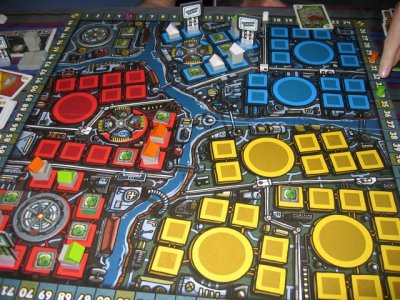 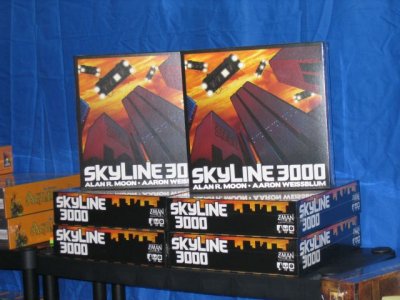 "So that is it for me for today, see you tomorrow again to the final day. And now back to Kulk and his unconventional convention adventures!" As promised, I wanted to tell you a bit about an interview opportunity I had today, and thus I actually had a chance to have a nice chat with Donald X. Vaccarino, author of Dominion and winner of both DEUTSCHER SPIELE PREIS and SPIEL DES JAHRES. As it seemed, Mr. Vaccarino had warmed up for the show and had overcome the initial shock of finding these halls full of gamers. To get warmed up, I asked him whether he actually liked the fair, but here his answer was that he hardly had a chance to see the show through a visitor's eye. He did have quite a few press meetings, and he was a bit angered because people kept telling him that they were surprised he really existed. As it seemed, many people had taken his name as something articficially and not associated with a real person, and he was becoming quite annoyed by different interview partners telling him about their surprise to find him being a real person. Being a professional computer programmer, Mr. Vaccarino has deep gaming roots as a vived player of Magic - The Gathering. Quite unknown to many people, he actually was involved in the revisioning of the Magic-rules for the 6th edition of the game, and so he is actually credited in the game for giving his advice as an experienced player. He also played an occasional Euro-style game like Settlers of Catan, and since 1994 he had created quite a few boardgames for which he wanted to look for a publisher. However, when he actually had his first real game finished in 1997, he offered it to WIZARDS OF THE COAST, and that was just the time when WOTC stopped producing boardgames and shifted exclusively to the production of Magic. With his hopes spoiled, Mr. Vaccarino did not release any game in the following years, but he kept creating rules for different types of games. Thus, despite the fact that it is rumored that the creation of Dominion has been inspired by Magic, Mr. Vaccarino actually had developed the deck creation mechanism while trying to solve a combat problem which occurred in the creation process of a fantasy adventure boardgame. Developing this mechanism, at some point he decided to focus on it while dropping the other part of the adventure game, and the resulting archtype of Dominion satisfied him that much that he increased his efforts and presented the game to his friends. Over the following time, both his regular and his Magic playing groups increasingly demanded Dominion to be played instead of any other game, and so the assessment grew in Mr. Vaccarino that the game could have a good degree of popularity amongst gaming hobbyists, and so a first contact to RIO GRANDE GAMES was established. Not knowing anything about the German games awards at that time, he was just happy to get his first major release, but over the last months he was getting quite thrilled because of Dominion winning such high awards and recommendations. Talking about the game, Mr. Vaccarino added that he had finished another couple of expansions and that he would continue his creative efforts on the game as long as people would like to play it. However, the upcoming expansions would not be released in the same short frequency as the three Dominion-boxes which had yet been released. In terms of rules, he was quite closed concerning the themes of any of the upcoming expansions, but he actually revealed that he wanted to give each expansion a specific focal point by one or two minor rules additions. Thus, the new Seaside expansion includes new "Duration"-cards which will have a lasting effect in a player's following turn, and even though this type of cards probably will not come up in another expansion it is Mr. Vaccarino's intention to create similar expansions centered on specific mechanisms. With Dominion winning the SPIEL DES JAHRES, Mr. Vaccarino also had decided that his days as a computer programmer were over. He now wants to take up some of his older playing concepts and to work on some newer projects, and so he will try to establish himself as a game designer on the long run. 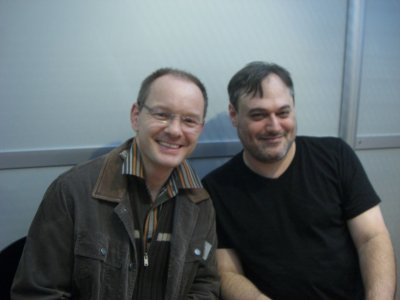 The nice experience I had with Stronghold in the morning also made me hungry for a bit more of medieval warfare, but I wanted to play something a bit lighter, and so I headed back to hall 5 where I had seen the new Medievalia Action expansion being available on the booth of GIOCHIX. However, I made a small detour past the booth of BOARDGAMEGEEK, and while the photo below actually might suggest a somewhat quiet atmosphere at this booth I can assure you that this was only a momentary snapshot. People where crowding there on all three days and voting on their favourites, and the leading in the list at that moment was Carson City by QUINED WHITE GOBLIN which was also high at the Fairplay rankings. 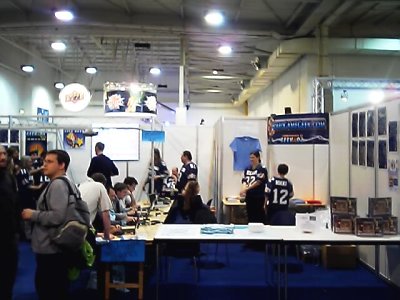 However, the people crowding at the booth did not mean that there was no fun out there, and so Scott Alden and Eric Martin were enjoying themselves with a pair of inflatable clubs which they had taken from the interactive fun-game Arg!tekt. 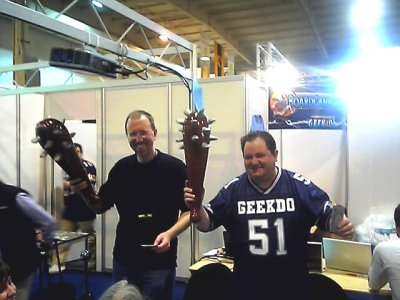 Leaving the guys to their "cavemania", I continued on my way to GIOCHIX. The Italian publisher had introduced its resource management cardgame Medievalia at the SPIEL 2007, and because of some ambiguity and unsolved questions in the rulebook the online version of the rules has seen quite an evolution over the last two years. GIOCHIX was eager to improve on the clarity and quality of the rules as much as possible, and here it proved to be a blessing that the playing cards in the game do not contain any text, but instead all possible uses of a card are shown by symbols. Thus, the rules have seen several new versions and clarifications, and in Summer 2009 GIOCHIX even moved on to a new second edition rulebook, making some considerable changes especially to the mechanics around the playing decks while at the same time retaining the identical set of playing cards. It is great to see that a publisher still invests so much time after a game was released in order to improve it as much as possible, but here at the convention it showed that these improvements were not just made to straighten things up, but also to allow the release of a new expansion - the Medievalia Action set.  As might be guessed by the title of this expansion, the included 80 cards are used to enhance player interaction in the game. In a way, this was a necessary step because the rules of basic game basically intended interaction to appear through military conflicts between the players, but quite often the players restrained from using their military forces because of the fear of a quick defeat and thus concentrated on securing victory by a build-and-defend strategy. Thus, "turteling" was and is a valid option in the basic game, leaving interaction as a voluntary option to those who are more war-minded. Remembering the ancient first version of the Warcraft computer game, the two networked players in this game also followed a military buildup strategy for the first half of the game. However, playing fun and interactivity considerably increased during the second half, since the game only could be won through an ultimate military defeat of the other player. Thus, players had to invest in offensive and defensive capabilities alike, and although Medivalia as a cardgame hardly can be compared to a computer game, I would have wished nonetheless for more incentives and powers which push Medievalia players into the same general direction. As it seems, my silent wishes have been heard, and now I had my first chance to test the new Medievalia Action. It has been a long wait after the initial proclamation of an upcoming expansion had been made at the SPIEL last year, but as it seems the waiting time was worthwhile. In effect, the expansion adds 3 new buildings and 3 new characters to the game, but its backbone are a total of 18 different action cards which are meant to increase interactivity. Here the revisioning of the first edition rules proved to be invaluable, since the use of this new type of cards required a re-structuring of the card-drawing mechanism in order to prevent the game to become too much luck dependent. Thus, apart from the already known separate building decks the players now also can chose to draw cards from a Civil Character deck, a Military deck or an Action deck. This separation of the main deck into several decks was absolutely necessary to retain some degree of control on the balancing of a player's hand of cards, but at the same time it also allows the players some general strategic orientation since they now have the option to draw from specific piles instead of totally relying on their luck. The different available actions range from straightforward options like a temporary boosting of a character's attack or defense capabilities, the stealing of a card or the forced discarding of cards to slightly more complex changes of conditions like the doubling of maintenance costs for a full round, the recruitment of mercenaries for gold or a temporary peace declared by the Church. Due to the number of available actions the game gets somewhat less predictable and players may be faced more often with unexpected situations, but at the same time this comparatively small reduction of stability really increases interaction and playing fun. It now becomes possible to catch other players unaware with small surprises, a factor which was missed quite strongly once the basic game had been played several times in a row without any player going for an attack. And if action cards are played in a proper sequence, the surprise may even get bigger! As indicated, the GIOCHIX team has tried to counterbalance the increase of luck by separating the available cards for drawing into several different decks, and first playtesting revealed that this comparatively easy change of the game's setup really adds some stability at that point of the playing mechanism. However, there also are some subtle incentives which gently push the players into more confrontational play, and here for example the new Innkeeper character can be mentioned, since players with this character gain a free action card when the Innkeeper is activated. Likewise, an action card can be acquired by discarding only two hand cards, and thus it is cheaper in comparison to cards from the other decks. Overall, I will gladly make the step forwards to use Medievalia with the new edition rules and the expansion set. As I had drawn the comparison with ancient Warcraft the entertainment value of the game has been increased considerably, although the chances to win or loose now are a bit less calculable. But here the individual preference of other players is a matter of taste! 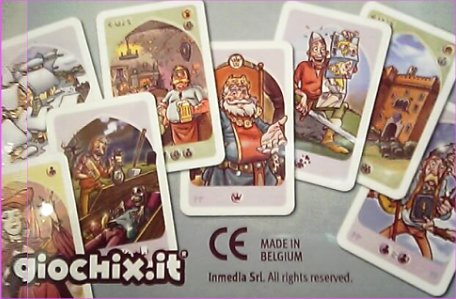 Christian Leonhard also has told me that he rather enjoyed the new strategy game Peloponnes, and having visited the Greek islands in Cyclades on thursday I wanted to enjoy the Greek sun for some time more. Thus, I made my next visit to the booth of the new German publisher IRONGAMES. Author and publisher Bernd Eisenstein has brought his new optimization game Peloponnes with him to the show, and instead on the Greek islands this game focuses on the expansion of city states on the Greek mainland. On first sight Peloponnes presents itself as a more or less typical optimization game, with the players trying to acquire buildings and landscapes (expansion tiles) in order to generate income and population. At the beginning of a round, a total of five expansion tiles is revealed, and following the always changing player order each player now has the chance to place a bid on of the tiles. However, unlike other auction mechanisms, each player only can place one bid which cannot be increased, and if a later player displaces an earlier bid with a higher bid the earlier player either may immediately shift his bid to another available expansion tile or he may take it back, receiving one additional coin but no expansion tile in this round. When all bids have been placed, the result of the auction is resolved with the players simultaneously taking the tiles they have acquired. If a player has taken a building he now either has to pay the buildings costs in form of resources (grain, wood, stone), or he has to place a coin on the new building to indicate that the resources still need to be paid. The building then is placed left of the player's own civilization tile, whereas all landscape tiles are placed right of the players' civilization tiles. Landscape tiles do not require any building costs to be paid, but here the placement of a new tile is only possible if the new tile produces at least one resource of a kind which also is produced on the last landscape tile which the player had acquired. Provided a valid placement of a new tile can be made, the players now have to resolve the immediate one-time effects caused by the new tile. In most cases the effects are an increase of a player's population and/or some additional coins or resources, but sometimes a new building (like a Fortress or Barracks) also can cause a decrease of a player's population. A round ends with the phases for income and disasters, and now the players first get the income which is generated every round by their buildings and landscapes before two random Disaster-chips are revealed. Five different disasters exist in the game, and the chips are placed on the corresponding disaster. The placement of a third chip triggers the disaster, and now all players will have to face the consequences. As might be guessed, an outbreak of Black Death diminishes the players' population, a Drought decreases the stockpiles of grain, Earthquake and Thunderstorm destroy buildings and landscapes if no resources can be spent for repairs, and a Decline of culture causes the loss of Luxury Goods. However, certain types of buildings provide a protection against these kinds of mishaps, and so the players will strive to possibly acquire fitting buildings if they can see that a certain disaster is imminent. However, such a protection cannot be planned because fife random expansion tiles will be revealed each round, and so the players mainly will resort to the stockpiling of an emergency reserve of resources. Apart from preventing the negative effects of a disaster the stocking of resources also is necessary for the Provisioning phase which is triggered upon the revealing of certain expansion tiles at the beginning of a round. Such a discovery temporarily stops the further proceedings and requires the players to pay one grain for each of a player's population, and in addition the player's now have to pay the resources for buildings which they could not pay when they acquired them. If the matching resources cannot be paid, population and/or building(s) are lost. However, stockpiling resources also may lead to overproduction, and when a scale on a player's overview sheet cannot take any more of a specific type of resources any production exceeding this scale leads to the production of Luxury Goods which now will be recorded. These Luxury Goods can be traded back into any type of resources on a two-for-one base, and they even can be used to gain coins if the player runs out of money. However, other than you might expect, Luxury Goods only have a minor impact in the final evaluation, since they only are used as a third rank tiebreak if two other scores both are equal. The game ends when the third and final pile of expansion tiles is exhausted, and now each of the players calculates two scores. One score is the cumulative value of the player's expansion tiles plus one for every three coins in his possession, whereas the other score is the player's population multiplied by three. The players then compare their lower scores, and here the player with the highest score wins. Recording stockpiles of resources on a playing sheet with scales and splitting the game into three phases by resorting to different piles of expansion tiles might bring up some first hand resemblance to Through the Ages. However, the similarities do not carry on with the main playing mechanism, as Peloponnes turns out to be of a much lower complexity. Although the players depend on the availability of expansion tiles which are randomly determined each round, there are some strategic options because the acquisition of a new tile must match a player's general orientation and his available resources. Furthermore, some of the buildings offer minor special powers, and here the players can try to get a leading edge by using these powers wisely. However, Peloponnes is no exception to many other building games when it comes to player interaction, since the only point where the players get into contact is during the auction of expansion tiles when a player possibly may be ousted by another. Constructed on a solid but limited resource management mechanism, Peloponnes offers no other form of interaction like military manoeuvres or other types of action cards, and while this gives the game some increased attractiveness for solitaire play (interesting rules with a level system included), competition in group play only can be felt in a quite rudimentary way. Still, this is quite similar in other building-type games, and in such a comparison Peloponnes can score with its rather fast gameplay. The game unusually quick for a building game, but I did not have the feeling that the ending was premature or rushed. 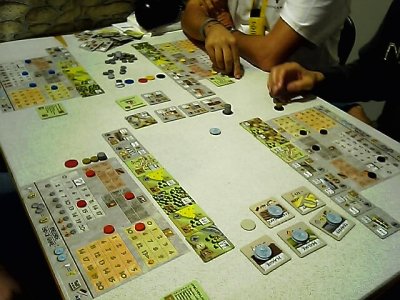 However, as you know from my coverage in previous years, the SPIEL is always good for a curious find, and I guess that if there was an award for the most weird game I guess it would go to Hard Furry Pets (HFP) from the Italian publisher PSEUDO this year. Taking an absolutely "politically incorrect" approach, the game is about little anthropomorphic animals who try to charm sweet girls of wavering morality. However, the players actually can chose between two different roles, and thus they may chose a character as an HFP or as a Moralizer. The former will try to drive the object of their desire down the road of damnation and dissoluteness, while the latter will pursue the route of light and purity (or something like that)… The game doesn't take itself seriously, and so it actually qualifies as a party game with a somewhat strange topic. Each player is assigned an "obsession" card at the beginning of the game, showing a girl he tries to conquer. In order to win, the player must meet the girl's standards in terms of Heart, Morality and Will, but the combination depends on the kind of girl which was drawn and on the role of the player as an HFP or a Moralizer. Basically, it's a game of collecting points in each of these three categories, but here the restriction must be observed that one category must be finished before the next may be begun. However, due to restrictions applying to the size of each players' hand of cards, a player usually cannot keep all cards needed to fulfil a category at his hand. Being forced to put cards out, the player gets more vulnerable to event cards played by others, and this in turn regularly causes detours and setbacks. Event cards, one time effects, randomized bonuses through obligatory location cards, combinations and a special ability of each player character all add up to a quite various gameplay, and in terms of atmosphere an exchange of blows begins which is quite similar to The Red Dragon Inn from SLUGFAST GAMES. However, despite the fact that much depends on the cards available on a player's hand, the game actually feels slightly more controllable, since cards like locations usually will remain on the table until a category is finished by the player. Furthermore, the first few rounds of the game also allow room for speculation and bargaining, since a player either may reveal his girl early and start fulfilling the first category, or he may try to keep his secret a bit longer, hoping to find a valuable key card which will identify a girl's desire and thus brings a bonus for the rest of the game. With some bawdy jokes and a big winking of the eye the game hilariously makes fun of male chauvinism and awkward situations which may arise if somebody simply wants to gain too much all at once. The game primarily is a fun game which can be played with a group of good friends, and it should not be taken seriously. A rather strange find indeed. 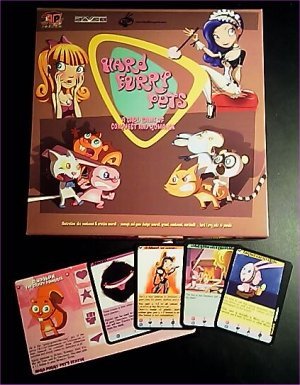 However, leaving this somewhat exotic find behind, I would like to finish my report for today with a really great game which I nearly overlooked on my round through the halls. As a matter of fact, I had seen at least half a dozen games all focused on the theme of Werwolves here at the show, and so the new game Full Moon by GEN X GAMES at first slipped my attention. However, during one of my trips to the news show yesterday I discovered the game standing on a table near the end of the hall, and upon examining the playing materials a bit closer the actual setting of the game awakened my curiosity. Thus, the "Survival Guide" named rulebook of Full Moon introduces the players to the story of a group of youths who has acquired a map of an ancient forest. Looking for adventure and some days in the unknown wilds, the youths have decided to go on a hiking trip, but the whole adventure has turned into a nightmare. Thus, one day the youths wake up, and they find two of their group members have been kidnapped in the night. Their tent has been wrecked, and as if one mishap wasn't enough the kidnappers also had taken the map with them. 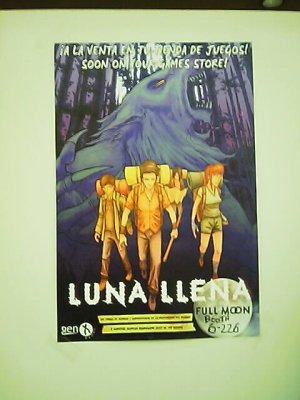 Thus, the scene is set, and all but one player find themselves in control of one or more hikers who have just awoken to this nightmare in the middle of the forest. The only thing they can see from their current position at the central camp hex are six elevated landmark hexes at a distance of two hexes around their campsite, whereas the rest of the forest and even the true nature of all elevations only will be revealed in the course of the game. Each character sheet lists four attributes of a character - Life, Strength, Dexterity and Calm. As might be guessed, a character is killed if he looses all lifepoints, and Strength will be used in combat. Calm is reduced when a character enters frightening places, and if a player looses all calm he gets scared and is apt to fall into panic, resulting in the character fleeing to a randomly detrmined adjacent space and reducing his maximum limit for determination points to three. One determination point is received by each character at the beginning of each turn, and under normal circumstances, up to 10 determination points may be stored by a character so that the points can be used for all kinds of beneficial actions like the restoring of lifepoints, the drawing of additional action cards or the cancelling of a negative combat or werewolf pack card. Opposite the players in control of the hikers stand the werewolf player, and it will be his task to turn one of the humans into a werewolf and to prevent all other humans from leaving the forest. The turning into a werewolf can by accomplished through an infection by biting a hiker after a successful combat. Thus, at the beginning of the game a number of infection markers corresponding to the number of hikers is shuffled, and whereas one of the markers actually shows the infection with lycanthrope all other markers show that the infection was not successful. All markers are mixed and remain facedown, and two of the markers were assigned to the two kidnapped hikers at the beginning of the game to symbolize that they have been bitten during the kidnapping. All other infection markers are placed at hand, and when the werewolf player succeeds in winning the first combat against a character that character is not just wounded but also receives one of the remaining infection markers. Each full turn of the game represents one hour of playing time, and when nightfall comes all infection markers will be revealed apart those of the hostages. If all free hikers do not have the infection, the werewolf player knows that one of his two hostages is infected (provided he has bitten every character at least once in order to assign him/her an infection token). The werewolf then can close in on the hikers, trying to kill them all before they can leave the forest. However, if one of the free hikers has the infection, he will turn into a werewolf and must be handed over to the werewolf player who now has one more werwolf when he starts to hunt the other characters down. 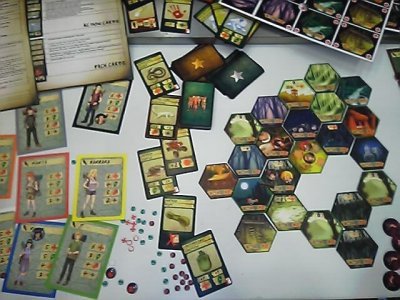 The hikers have a hard task in front of them, since those two of their friends who actually know the way out of the forest plus the map have vanished. Thus, the human players need to look for the werewolf lair, and all they know at the beginning that the lair tile is ten steps away from the initial camp hex. During game preparations the werewolf player had to mark the position of the lair on a small map, and he also had to draw a winding path through the forest, starting at the camp hex and going through ten spaces before ending at the lair. The humans must find the path, follow it, enter the lair and find at least the map or one of their companions. If they succeed in doing so, two road hexes will be placed at the outskirts of the forest, and if any one hiker succeeds in reaching any of these hexes the hikers will have won. At the beginning of their turn the hiker players will receive some action cards which they can add to their hands, and every hiker character is assigned a card which depicts his action for the turn. The movement of a character is free and requires no action, but all other kinds of actions like an exploration in which direction the path leaves the hex, a searching of the hex for a useful object, or going alert or into hiding all require the playing of an action card. As indicated, under normal conditions the hikers will try to follow the path for all ten spaces in order to get to the werewolf lair, but on each space they enter they actually have to explore the outer borders in which direction the path continues. A character who explores the path rolls one dice for every point of dexterity he possesses, and for each "5" rolled one of the sides may be explored whether the path continues outwards there. The werewolf player must answer truthfully after consulting his map, and the players then may mark the announced the result on a map of their own to keep track of the hex-sides they have explored. The rolling of a "6" is even better, since for each six a hex side may be chosen, but the werewolf player must not just announce whether the path goes out through that side, but he also would have to announce that the path is nearby if it goes out through one of the adjacent borders. He just doesn't have to say at which side the path is nearby, but sometimes the clever use of exploration actions allows the players to make a deduction in which direction the path will continue. Each hex space entered by the hikers features different kinds of symbols and sometimes an additional speciality. Thus, some of the tiles show a cabin, a shed or a wrecked card where the hikers may search for a helpful item. On the other hand, the misty forest or the cemetery cost the players Calm-points to enter, and foggy areas will make it more difficult to explore such a hex. Quite interesting are the six elevations which can be found at specific places, since they allow a player to reveal all hexes surrounding such an elevation. However, the werewolf lair may not be found accidentally or by looking from an elevation - the forest is so dense that it can only be found by following the path right up to the end. Some hexes actually are beneficial for the hikers, so that a resting place beside a peaceful lake or some special fungi found in an ancient part of the forest can restore lifepoints and Calm. However, on the other side most spaces feature one or more Wolf icons, and it is the Wolf icons which the werewolf player needs to "sniff" for the hikers. Thus, after all hikers have moved, the werewolf player checks the hexes occupied by the hiker characters for Wolf icons, and if one or more Wolf icons are present the werewolf player can spend some of his planning points to roll a corresponding number of dice. A "5" or "6" is needed to find all characters in that hex (provided they are not hiding, in which case a second success is needed to find a hidden character). The werewolf player then may chose to attack the hikers by spending some more planning points, and he choses one character to be attacked by each werewolf character. These werewolf characters have human form during daytime, but in the night they will turn into wolves and get much stronger, so that the hiker players will be pressed hard once the night has broken. Combat is resolved through the use of a special combat deck, but first the human character determines his combat Strength by adding his own initial Strength plus Strength bonuses provided by found items. A werewolf character always his initial strength, and then a card from the combat deck is revealed for both the hiker and the werewolf. Most of these combat cards show strength increases, and following a blackjack-like mechanism the combatants alternate either in asking for an additional combat card or to abstain from drawing more cards. The reason why a player might stop to draw more cards is that there are some cards in the combat deck which might cause the player to trip (loosing the combat for him) or to get some Strength points subtracted. However, once a player has decided to pass, the other player may be lucky and get a higher strength due to additional card draws, and in that case the combat will be lost for the player with the lower total. If the werewolf loses, he will be hurt and the werewolf player must pay two planning points to get him back into action. The hurting of a hiker results in the loss of lifepoints, and additionally a character who has lost a combat will receive an infection marker if he does not already possess one. A hiker who looses all lifepoints is killed and out of the game, but the werewolves on the other hand are very hard to kill. Only the possession of an axe or the use of a silver bullet can enable a player to kill a werewolf he has defeated, but both of these items first need to be found. As indicated, night falls at a certain point during the game, and apart from the fact that the werewolf characters now turn into their wolf-like form, allowing the werewolf player to place figures for his wolves on the table. Whereas all daytime "sniffing" actions did not result in the permanent activation of the werewolf characters in human form, the transformed werewolves will actually roam the forest for the rest of the night, trying to hunt and kill the hikers. This rule partly seems counterbalance the fact the wolves now are stronger, but due to the fact that a group of wolves can be moved up to three spaces for just one planning point they can each their prey pretty fast. Once arrived, another "sniffing" action is needed, but due to their heightened senses the wolves are better when "sniffing" in the night. To my great surprise I find the role of the werewolf player to be much more involved in Full Moon than it has been in Middle Earth Quest which I played yesterday. Despite the fact that Sauron had a somewhat broader choice of actions, it seemed to be more interesting to spend points for "sniffing" and attacking, and furthermore the werewolf player may opt to go for special frenzy attacks or to call upon Father Tree and Mother Moon in order to place a Tree Barrier or to change the nature of some forest hexes. In addition, the game offers some additional rules which greatly enhance the playing atmosphere like a special deck of rewards and traps the players must use upon entering the werewolf lair or the rules for turning a character into a werewolf or for returning the hostage characters to the game. Talking about atmosphere, it was absolutely astonishing how deep the players are drawn into the game. The somewhat dark and frightening artwork is very fitting, and many graphic details like abandoned ranger towers, wrecked cars or even the digital "wristwatch" times on the time track all add to a general feeling of the hiker players being up to their neck in a really threatening situation. In one way or another the story described in Full Moon can be found in some movies, but I cannot remember that I have seen such a plot turned into a rather thrilling boardgame. Servando Carballar and his team at GEN X GAMES have created the best adventure game I have seen for quite some time, and keeping the rules at hand while typing those lines I discovered the game to be easier to learn than the very complex Mecanisburgo in 2008. Servando had told me at the SPIEL that they had improved much on the way of writing rules, and since I found this assertion to be true the access barrier to the game really is much lower. Beware of the she-wolf in the forest… And so we reach the end of today's coverage, but you still get another Dominion card! 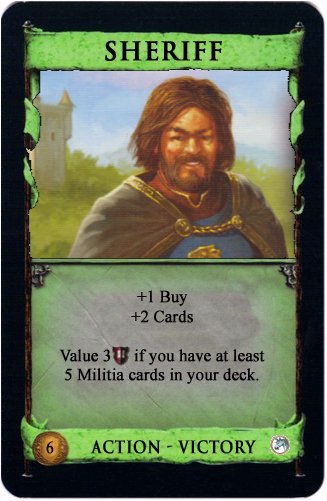 We actually will be turning hour clocks backwards an hour tonight due to daylight saving, and so I get to sleep an hour longer! That's exctaly what I need by now… See you tomorrow for the final day! Frank Sunday, 25th of OctoberHello everybody and welcome back for my final report from the SPIEL 09 convention at Essen! For me, a convention week always passes incredibly fast, and I cannot imagine that the SPIEL 09 is history by now. The last few days have provided a thrilling and entertaining break from every-day life, and it's always somewhat sad to leave the halls for the final time on Sunday. However, before the daily routine once again catches up on us, let's first go for another great day filled up to the bring with interesting new boardgames, and you will also receive my fifth and final Dominion card! 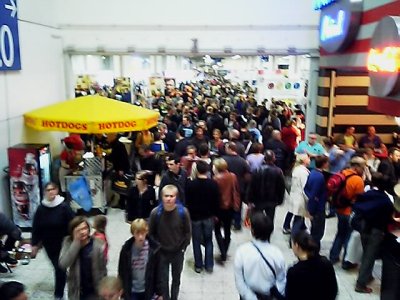 With Uwe Rosenberg winning both the International Gamers awards 2008 and 2009, I thought that the time had come to check out his new game Vor den Toren von Loyang. Edited by the newly established publisher HALL GAMES, the game has been expected for quite some time, and as it seems, games focusing on the harvest and conversion of goods seem to be Uwe Rosenberg's special subject. As Agricola and Le Havre have shown in 2007 and 2008, his conversion of agricultural or industrial processes into the scope of a boardgame has found a great fan community. This year he has returned to the time before Agricola, presenting the gamers with a game which he has created in Spring 2005. However, although the new game Vor den Toren von Loyang is published on the new publishing label HALL GAMES, the game nonetheless stands in good tradition with the last two games, since once again the main focus of the game lies on the growth and sale of arable crops. As the title of the game might suggest, the action takes place in medieval China with the players taking the roles of smallhold farmers. They are taking their crops to the market taking place before the city of Loyang, and here they try to use the different available marketeers to their best profits. Much of the market action is driven by an action card deck which contains regular customers, one-time customers, assistants, market booths and new fields, but before we have a closer look at the marketing of crops let us first have a look at the cultivation of the land and the starting setup of the players. Each player receives his own T-shaped overview table, featuring a track were the players can record their wealth level and their own shop quarter were they can sell and acquire crops. Six different kinds of crops exist in the game (wheat, pumpkins, turnips, cabbage beans and leek), and one to three units of each of these crops are available at the corresponding shop spaces at the beginning of the game. During the course of the game a player always is free to buy and sell from his own shops, but he is restricted to the spaces available at the shop quarter. So, a unit of crops may only be sold if a corresponding space in the shop quarter is free. To start his smallhold farm each player receives a home field card showing nine parcels under crop, and he may use a bit of his starting capital to buy a unit of wheat, pumpkin or turnips from his shops for the first sowing. He then places the chosen crop onto one of the parcels of his home field and fills up the remaining parcels of the field with crops of the same kind from the common stockpile. The game will run over a total of nine rounds, and as the players are allowed to harvest one unit of crops from each of their fields at the beginning of each turn, the initial placement on the home field will be sufficient for the whole duration of the game. In addition to the home field each of the players receives a partly mixed deck of 8 fields, featuring field cards with three to six parcels. At the beginning of each round every player receives a new card from his own deck of fields to represent his efforts for the cultivation of the surrounding lands, and from that time on the player also may use these new fields for sowing and harvesting. However, whereas the process of growing and harvesting crops is rather straightforward, much more detail lies in the acquisition of action cards and the possible courses of actions which are available to the players in the action phase of each round. For the time being it is sufficient to mention that each player gets two action cards in a card distribution phase between the initial harvest and the final action phase of each round. These two action cards are placed in the players' displays next to their overview table, and they now may be used in the following action phase. The action phase is the core mechanism of the game, and whereas the first one or two rounds usually should see a rather fast progressing of this phase, the complexity of the player's actions will increase with the course of the game. Most of the actions available can be chosen for several times so that players who use the actions in a good order can create interesting windfall gains, but it is of great importance for the players to remember the the fact that they only possess limited storage possibilities at the end of a round. Thus, they should be eager to use the action phase in order to turn their harvested crops into profits and not to throw them away by the end of the round. The first three possibilities what players can do with crops already have been mentioned, and so a player can buy and sell crops at his shop quarter under the mentioned restrictions, and he also can sow out a crop unit from his stockpile at one of his unused field, filling up all remaining parcels of the same field with the identical kind of crop in order to harvest these crops in the following turns. However, the rest of the actions deals with the action cards available at a player's display, and here let us first have a look at the regular and one-time customers which are the backbone of the players' income. A one-time customer has a shopping list with three crops, and if a player has these three crops in his stockpile he may return the crops to the common stock and receives the value of the one-time customer in exchange. Regular customers on the other hand are more tricky to deal with, since they demand a combination of two crops which must be delivered to them four times in consecutive rounds. In each round in which the player can meet the demand of a regular customer he receives an income from the sale, but if he cannot meet the demand the regular customer will get unhappy. At the first instance the failure of the player will be ignored, but if the player fails to deliver the demanded crops for more than one round he has to pay a contractual penalty in every round where he cannot meet the demand of his customer. Thus, one-time customers are easier to deal with, but regular customers on the other hand allow for strategic planning and a higher total income. Furthermore, there is a correlation between both kinds of customers in a player's display, so that a player who has more one-time customers will receive less for selling his crops to the one-time customers because he has chosen the easier way. On the contrary, a player who has a majority of regular customers will receive a bonus if he succeeds in meeting the demands of a one-time customer, since it is more difficult to serve the additional demands when a lot of regular customers are present in a display. In addition, both kinds of customers share the common fate that they are discarded once their needs have been satisfied. However, a player also may make use of small market booths which can be found in the deck of action cards, and if a market booth is acquired three predefined units of crops will be placed from the common stockpile onto the market booth. To prevent a misunderstanding I should make it clear at this point that a market booth is not part of the player's farming operations, but it is placed in a player's display to represent another farmer who wants to trade crops. Thus, a player may return some of his own crops to the common stockpile in exchange for crops from a market booth, and when all three crops from a market booth have been traded in the player will be forced to discard the now empty market booth card. Thus, apart from the shop quarter a player also may use the market booths to acquire new kinds of crops for trading and sowing, and very often the trade with a market booth will turn out to be more profitable because the shop quarter demands high prices for the most valuable crops. The real spice in the game are the 20 different assistant cards, since they create interaction and pose changing strategic challenges alike. Each assistant offers his own special power which the player can use once before discarding the assistant, and these special powers cover a variety of different aspects of the game. Some of the assistants like the Farm Labourer or the Errand Boy allow the harvesting or selling of additional crops, whereas the Accountant or the Haggler can influence the availability and prices of crops at a player's shop quarter. However, whereas the aforementioned assistants all deal with a player's own display, others like the Trader, the Canvasser, the Delivery Man or the Conman all have a special power which provides access to the action cards present in another player's display. Thus, assistants can be lured away, market booths or one-time customers exchanged or even a delivery can be made to another player's regular customer, and so the players will face quite a few kinds of special actions which they have to take into consideration. However, there is a danger of instability in games where special actions can be triggered by the play of interactive action cards, but in case of Vor den Toren von Loyang this danger was cleverly reduced by use of a specific card distribution phase. Thus, the action cards are not simply drawn by the players and added to their displays, but instead each player receives a hand of four action cards at the beginning of a card distribution phase. In turn, the players now have to place one of their hand cards into a common "yard" onto the table, and this continues until the player's decide to keep one of their hand cards plus one of the cards available at the common yard. A player who decides to keep immediately places these two cards into his display, but the remaining rest of his hand is placed into the yard for the other players to chose from. And when all players have chosen their two cards, the remaining cards from the yard are discarded and the round proceeds to the action phase. This neat and easy card distribution mechanism gives a player some control over the cards he is going to receive, while at the same time a nice dilemma in regard to a player's remaining hand cards is created. Thus, a player's hopes for getting a good card through a round in the yard in order to take it himself are quite often spoiled, and in other situations a good card in the court cannot be taken because the player would have to add a good hand of cards to the yard at an early point. In addition, there is a possibility to acquire up to two action cards in the action phase, but whereas these two cards are randomly drawn it is now the way in which the cards are played which gives the players a further strategic angle. Thus, the two acquired cards are placed as a double with one card atop the other. The lower card only comes into play when the top card has been removed, and thus a player has a possibility to time the moment one a card comes into place while at the same time protecting the card from interactive action cards of the others. Finally, another unusual factor appears solely in the four player game, and here it seems that Uwe Rosenberg has recognised the fact that strategy games sometimes have long phases in which one player is thinking and acting whereas the others are waiting for him finish. To deal with this observation the players in a four player game are divided into two teams of two players each round, and the first and second players of both teams play through the action phase simultaneously! To prevent unwanted side effects the players only are allowed to use interactive action cards against their "partners", but at the same time this rather unusual mechanism greatly speeds up the action phase by leaving the players with a third of the usual waiting time. As I pointed out earlier, the action phase gets longer with each round, and thus this rather ingenious rule greatly helps to keep the game fluent and attractive. The winner is determined by the players' wealth level which is recorded on the playing sheet of each player. Here money can be invested for stepping forwards, but whereas the first step each round is available for a minimum price consecutive steps are getting increasingly expensive the higher the player gets on the wealth track. Thus, even the recording of wealth leaves the player to make some decisions, since it may possibly pay off to keep the needed money at the beginning of the game in order to catch up later by investing a bit more. The biggest problem with Vor den Toren von Loyang is the fact that the challenge for the players is not over by the end of the game, but instead the question which of the three Rosenberg games to play next time is an insoluble riddle. Agricola is the game which feels most familiar and tested, but its attractiveness does not wear out but instead is increased by the small expansions and cute playing materials which became available after the initial release of the game. Le Havre on the other hand is a bit more difficult to explain, but it allows a deeper manipulation of production chains and thus gives the players an even greater degree of strategic control while at the same time keeping diversity through the changing constellations of special buildings available in each game. Vor den Toren von Loyang finally seems to be the game which is most easy to access, but this does not mean that the strategic challenge is less interesting than the possibilities offered by the two aforementioned games. Quite the opposite, Vor den Toren von Loyang offers a rather nice action phase, and coupled with the interactive cardplay and the team-play rules the game has a good degree of attractiveness on its own right. 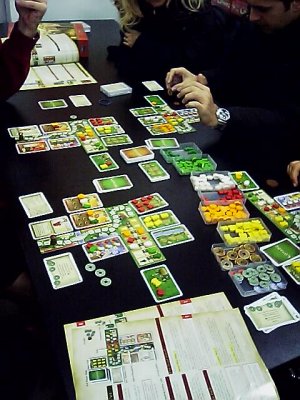 One of the trends which has grown stronger with every year has been the release of expansions. While it is true that expansions for some boardgames were released many years ago (the old classic Dune from AVALON HILL actually was followed by two expansions - Spice Harvest and The Duel) it has never been that many expansions to actually call the development a "trend". However, here in Germany the situation gradually changed when expansions were first released for The Settlers of Catan, and if you look through the halls of the SPIEL today you will find dozens of expansions for well-known games: Cuba, Chicago Express, Ghost Stories, Dominion, Kingsburg are just a few of the expanded games, and I will not even try to list the countless expansions which became available for some games from FANTASY FLIGHT GAMES just this year. While it is nice if your favourite game is improved and gets more "flavour", the whole development also can be seen from a different perspective, since many gamers whom I have talked to actually have fallen into some sort of collecting fever. It is "in" to get the expansions, especially if they are limited and hard to find, and so the publishers quite successfully have created an actual "need" for which they give us gamers a temporary cure with each new expansion. Yes, I know - people who live in glass houses shouldn't throw stones. I like many of those expansions myself and would not want to miss them in my games. However, things change dramatically when expansions either get too expensive in consideration to their contents, and it gets even worse when such a comparatively small expansion actually means a considerable improvement to the game. Here the question well may be asked why such an expansion was not included in the basic game right from the start. With these introductory words said, I would like to shed some light on some expansions available here at the show, and whereas I have seen a few very nice additions to popular games there also are expansions which fall into the category I have just described. Two years ago the Italian publisher STRATELIBRI had introduced his brand-new strategic dice game Kingsburg here at Essen, and although I considered the introductory price of 40 to 50 Euro to be rather steep I nonetheless considered Kingsburg to be one of the best games released at the SPIEL 07. The game offers a well-implemented unification of dice-rolling and building with some clever ways to keep luck at bay in order to give strategic elements their chance, and after two years and dozens of rounds all that Kingsburg players would wish for is just a bit of variety in gameplay because the game looses a bit of its impetus once the different building possibilities and the year's end enemies have been explored. Bearing in mind the medieval-fantasy topic in which the game is set, the authors now have come back to Essen with the long-awaited expansion Kingsburg - Die Erweiterung des Königreiches, and this flat box gives the players five different mini-expansions which can be used in any combination to enrich the main game. Starting with the buildings available to the players, the authors had discovered that the five available classes of buildings still offered much room for new ideas, and so each player may receive a new building sheet which contains two additional building rows. The two new rows lure the players to invest more broadly into all seven building classes, but in order to stand a chance to win the game it becomes even more important to focus on specialization. Only the higher ranking buildings of each class grant a good quota of victory points, and thus a broad investment scheme by dispersing resources to invest all classes is deemed to fail. 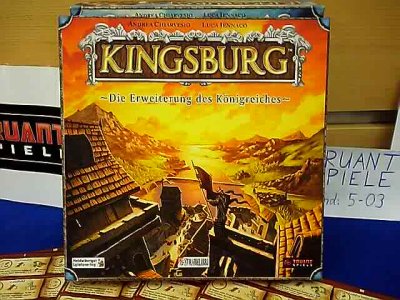 Even more variety concerning the buildings is introduced by the additional building stripes, since for each of the seven building classes now exists a cardboard strips showing alternative buildings. Determined either on a random basis or by player's choice two of these building stripes are distributed to each player before the game starts, and the players place the strips on their building sheets to cover the existing rows of buildings. Thus, each player now has his own unique choice of available buildings, leading to different strategies and a renewed challenge every time the game is played. However, another building-related factor which could be found in the basic game was the fact that the choice of a building strategy often was made on a matter of taste and determination right at the beginning of the game. In a way, the basic game made the players first pick their targets and then see how far they could come, and once again this led to a continuing rise of repetition the more often the game was played. Here the expansion puts things right as well, introducing a set of nicely illustrated character cards of which each player receives one at the beginning of the game. Each of these characters possesses a small special attribute which will last him for the duration of the game, and these attributed range from free resources, to higher military values or special ways to collect victory points or to invest dice results. These characters do not change the fact that a player needs to decide in advance in which classes of buildings he should invest, but the characters now give the players an additional strategic challenge because their special abilities should be used to augment a player's general strategy. Talking about strategy, a small but effective variant has been introduced concerning the year's end battle. Normally the players rolled a dice to see how many reinforcements the king did send, but now each player possesses a set of shields with values from "0" to "4". A player may use one of his shields at the end of each year to determine the strength of his reinforcements, and once used each shield may not be re-used. Thus, the outcome of the battle is more deterministic, and at the same time the players have to speculate at what time it would be better to use the more valuable shields. Finally, a good fantasy game also needs some story elements, and here the included deck of random event cards comes in quite handy. These event cards are shuffled, and one card is revealed at the beginning of each year, setting certain conditions which will apply to all players for the duration of the year. The effects of these events range from detrimental to beneficial, and once again the players need to take these changing conditions into consideration in order to ensure a maximum yield of victory points. Overall, these five small but rather effective expansions give Kingsburg a great boost, and to my taste the playing fun considerably increases especially if several of the expansions are used together. Forememost, the characters and the random events offer a quite interesting new challenge, since the players now are forced to adapt their well-tested strategies before the game starts, and the events bring a bit of uncertainty which sets some impulse to react during the course of a year. However, my overall enjoyment of this expansion was spoiled to a good degree by the fact the expansion is rather overpriced considering the contents of the box. The box contains a stack of cards, thin cardboard sheets and strips and one punchboard, and with this relatively small assortment of components it is difficult to justify an average price of 25 Euro for which the expansion is sold. Okay, for me the expansion was a must-buy due to the fact that I simply like to introduction of the characters since they give the players some more personality, but nonetheless these cards certainly could have been included in the basic game. 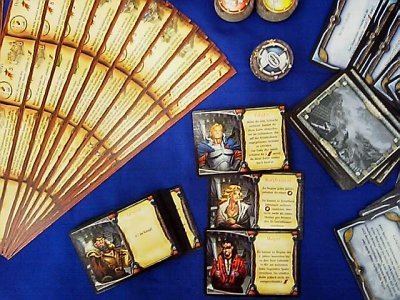 However, there also are much better examples of expansions available for the same price or less, and so the cost-performance ratio is much better with the new White Moon expansion for the cooperative game Ghost Stories. As it seems, Thomas Provoost and Cedrick Caumont from REPOS PRODUCTIONS are working on an alternating schedule, putting out a game every second year and an expansion for the game in the years between. As I have told you I had received the box of the new expansion a few days ago, and I certainly went through the contents of the box when I returned home that same evening. However, I just got able to playtest the expansion tonight, and I must confess that I really liked the new twists for the fates of the valiant Taoist Monks defending a peaceful village against the horrible sorcerer Wu-Feng. Whereas the basic game demands of the Taoists to protect the village locations from closing down, their task now becomes much more complicated since a random stack of three villagers now has been assigned to each of the village locations at the start of the game. The topmost villager of each stack is visible for the players, and a villager's tile shows the name of his family, the number of family members available in the game and the awards or setbacks which are applied to the players when the villager either is saved or dies. With the village being threatened by Wu-Feng's abominable creatures, the Taoists will try to save the villagers by moving them through a magic portal which has been placed at the central village location. If a Taoist is at that location and at least one villager is standing there, the Taoist may decide to use his action to push the villager through the portal instead of using the village location. All villagers saved by this method are collected on a special board, and here it is important to separate the villagers into their different families. If the player's succeed in saving all members of one family, the family will be so happy that it rewards the Taoists with a family heirloom or some other benefit. A heirloom is some kind of artefact, and it be a weapon, an armour or some other helpful object. Each of these heirlooms will prove to be an invaluable help for the Taoist who receives it. In general, the more members a family possesses the more powerful the benefit will be, and so the biggest families with three members actually may give the players a Divine Sword (turning one dice to white before the start of every combat) or the players may receive three freely distributable Qi-markers (Lifepoints). However, as you might guess, there is a good chance that villagers might get killed, and this mainly happens when a ghost figure is standing on a space on one of the player gameboards. Whenever the ghost figure moves a step forwards, the topmost villager from the closest location will move one step away from the ghost. This does not sound like being a serious danger, but the problem is that a location only offers space for a maximum of three villager tiles. Any villager who is prevented from entering a location by this limit is instantly killed, forcing the players to discard the villagers and to face the detrimental effect listed on the villager tile. Thus, especially at the beginning of the game the players should aim to move some villagers through the portal in order to make room for the movement of other villagers. However, whereas a villager actually can be moved together with a Taoist without an extra cost, a clever use of ghosts present on the gameboard actually may assist the players in directing some villagers automatically towards the portal. This may save player movements since a Taoist just must be standing at the portal to push the villager through, and so the whole affair of the saving of the villagers really adds a new, challenging dimension to the game. Despite the fact that the saving of villagers might turn up useful rewards, the players actually stand on a difficult position because they will lose the game if 12 villagers are killed, and so they have to watch one additional condition which might lead to an ultimate victory for Wu-feng. However, the Taoists are not alone anymore, and so the ghost of a young villager called Su-Ling has joined the players in their task of saving the village. Su-Ling is activated whenever a villager dies, a location is closed down or the curse-dice is rolled, and her figure is placed on a "haunting ghost" space of one track on one of the four Taoist gameboards. With her mystical powers she now will block the powers of a ghost card on this track, and so a ghost facing Su-Ling does not move and does not apply it's ability which otherwise would apply every round. 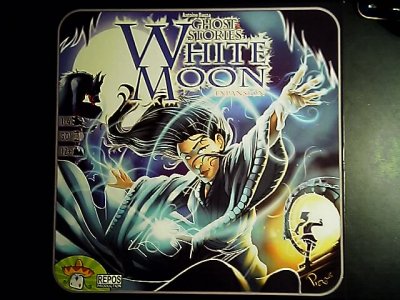 Furthermore, Su-Ling has knowledge of the use of mystical Moon Crystals, and and the beginning of the game an altar for a Moon Crystal has been placed at any corner of the gameboard. A Moon Crystal is placed on an altar when Su-Ling is on a track adjacent to the altar, and another possibility is that a player who has earned a Moon Crystal as a reward can place it on an altar if he is in the adjacent village location. When all four altars have received a Moon Crystal, an ancient Mystic Barrier will spring into life, created by the villagers' ancestors who had been fighting Wu-Feng some centuries back. The Barrier will grant the players a temporary relief, and they now must use each of the Moon Crystals either to move one Villager through the Portal or to roll four dice to attack all ghosts on one Taoist board. This choice must be made for every of the four Crystals. Playtesting showed that the Barrier is a great help for the players because they can speed up the saving of villagers or remove several ghosts at one single stroke. However, at the same time the different elements included in this expansion actually make a good cooperation between the players even more vital, since gameplay gets more diverse by the simultaneous use of Su-Ling, the Barrier and the villagers. Only a high degree of cooperation can ensure a maximum of effectiveness when using the different new elements, and the players will need all the help they can get to stand against Wu-Feng and his hordes. Talking about the devil himself, he receives help from a horde of Werwolf-ghosts with a new attribute which allows them to kill villagers, and due to the fact that the players loose the game when a 12th villager is killed the whole new setting is not just beneficial but also dangerous. The White Moon expansion presents itself as a very capacious addition to the main game, and it shows the love for details and well-fitting rules which Antoine Bauza has put into the creation of his Chinese mystery game. Already the first testing round revealed a high degree of finetuning which must have been necessary to make the expansion run smoothly without unbalancing the game, but to my liking the author succeeded to a very high degree. Additional extras like a Kung-Fu school location and new Wu-feng incarnations all are helpful to in balancing the game while at the same time creating a whole new playing experience, and so expansion varies and widens the known gameplay of Ghost Stories considerably. Even seasoned Taoists who are not afraid of the Hell-level should face a really new kind of threat! The expansions for Kingsburg and Ghost Stories certainly are on an even level considering the average price of 25 Euros here at the show. However, here the similarities end, since a player who has purchased the box with the mysterious smile of Su-Ling on the cover will face a much better bargain than people who have decided to go for the Kingsburg expansion. As I have told you earlier, the Kingsburg expansion is rather useful and for me adds considerable playing fun, but it is simply a fact that the box is overpriced considering its contents. Here the White Moon expansion simply plays in another league! 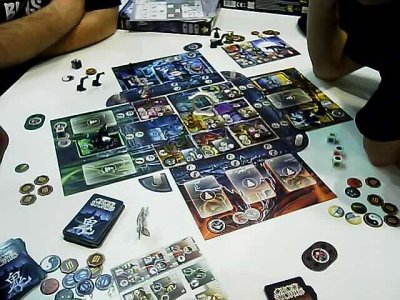 This summarizes my playtesting activities during the morning, and I had to leave the show at that point for an hour before returning for the final afternoon. However, before I will tell you about my final wanderings today, let's first have a look what Ralf has been doing all day long. "The last day of the fair and I am feeling tired and exhausted. Today I still saw so many booths with interesting games that I finally had to give up playtesting or exploring the rules but I only had a quick look at the design and asked other players about their opinion. Still I managed to do some testing in the morning and I want to let you participate in my experiences." "First of all I had some time to do a few turns at the booth of QUEEN GAMES. Here Dirk Henn once again has created a huge strategic game with historical backgrounds. Colonia let the player take on the roles of the mighty patrician families in the time of the Hansa Teutonica. The aim is to get some of the most valuable relics to contribute to the honour of Colonia in the Middle Ages when it was the largest town of the Holy Roman Empire. As everybody will know from various books, at that time relics were a secret ware, but with enough gold you could get whatever you liked. And so it is our task to get enough money to buy the relics. Of course, we as members of the Hansa Teutonica, solve these problems with the trade of other goods. In the game you have to care not only for producing and selling the products, but you also have to influence politics. This is all done with the help of a lot of cards, multiple resources and money in four different currencies. The flow of the game is very straightforward. To help the players doing the right steps at the right time, the board is divided into seven sections, each for a single day with special actions. This is a very clever design and the game concept would be attractive for a lot of other games, too. The game itself impresses with a huge gameboard, fresh design and rich game material. When you are in the middle of the game and spend some time at the sight on the table, you think wow, what a game. It is one of the best equipped games that QUEEN GAMES has published yet. In my few turns I had a little bit the impression that the game is not as strategically as it seems to be and as QUEEN GAMES let you know on their homepage. The influence of your moves on your opponents and your later actions seem to be limited. Surely, you always have to consider how much money you need for a special relic or whether you should sell your goods to the one or other country. But that are more tactical elements, a long distance strategic I could not detect. Nevertheless it was a great experience to playtest Colonia, a game you will find in a lot of houses soon, I am quite sure about this." 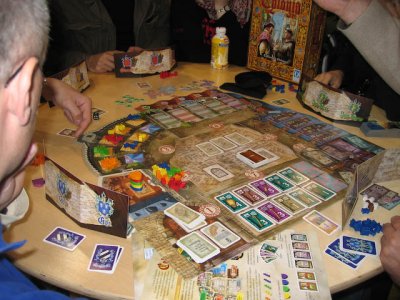 "I went over to the next booth and had a chance to watch some rounds of Atlantis. This is a high advertised game from AMIGO that once again adopts the theme of the mystique town somewhere down in the ocean. We take over the role of citizens of the old town just in the moment when the water begin to set the town under water. Of course everybody takes flight and in this chaos it should not attract anyone´s attraction if the one or other jewel or other treasure would find the way in our pocket. The most important object of the game is to reach the safe continent with all of our three game pieces. That should not become too difficult, you might guess. But wrong. There is only a small path, represented by solid ground tiles between the ancient town and the continent. With every move of a player, the safe ground tiles behind the game pieces vanishes and gives way to the water. For this purpose the player takes the solid ground tile behind his piece and replaces it with a water tile. All game pieces behind can only get over these water tile with the help of bridges, by the payment of victory points or with special cards in our hands. The game ends in the round when the first player has rescued all of his game pieces. In the round I watched I got a positive picture of Atlantis. It seems to be a solid family game and was played at many, many tables on the fair. The strategical and tactical elements are limited, so that the game can be played at a good pace. The game elements work fine and it seems to make much pleasure in replacing the solid ground tiles by water tiles right before the opponent´s game pieces." 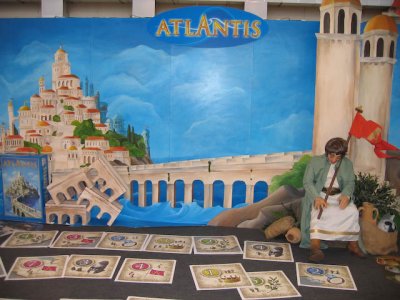 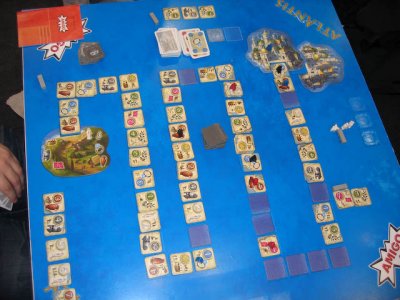 "After this two games from the big publishers I changed the halls and went to some smaller booths again. A game I had already seen the days before I finally could playtest today. Beer & Pretzels from BEZIER GAMES is definitely a party game. Every player gets a sets of coasters. Most of these show pretzels that are worth 1-4 dollars. One special coaster shows a beer and doubles the income of the player if it counts at the end of a round. And finally you have a coaster with no income or other function, it is only there to harm your opponents. First of all a boundary line is placed in the middle of the table. Because this is a string you can shape it in any size you want. Then the starting player begins to toss any of his coasters towards the inside of the boundary. The other players do so as well and this goes on until all coasters are lying on the table. No the scoring takes place. Only pretzels and beers that are not obscured in any way, not even on a very small edge, count for the players. So as you already will guess it is advisable to toss the coasters to areas where you can obscure coasters of your opponents. But you should be careful, you could hide your own coasters, too, and your opponents will have similar thoughts as you have. Normally you will do several rounds and the player with most money wins the game. A really easy game, but effective and relaxing at the end of a long-lasting strategic game. I bought it at once and will try it after some beers with my friends in the next weeks..." 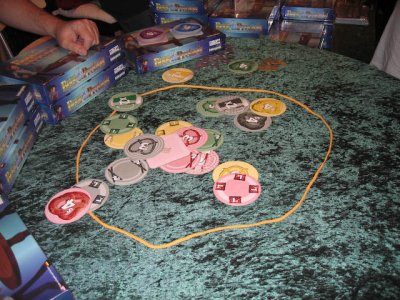 "Today I also had the chance to see the spectacle around the Abwrackprämie at KRIMSU. Corresponding to the big "cash for clunkers" campaign in our country, in which you could get 2000 euros from the state for exchanging your car by a new one, at KRIMSU booth they collected old games from the people and threw it in the mass at lunchtime. KRIMSU himself did the job and you could hear from his voice that he did it the one or other day, too. I shot some pictures to let you participate in this big show." 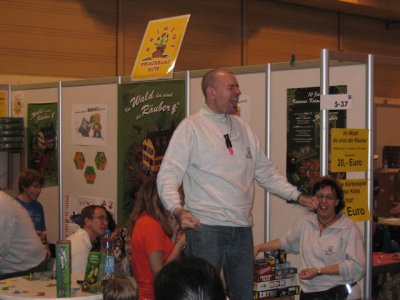 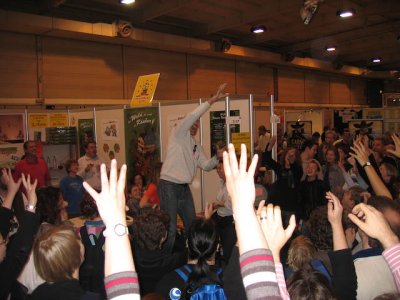 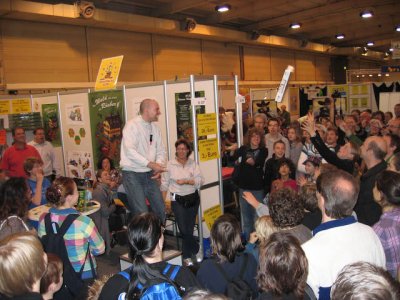 "My final discovery for today was in the hall of Life-Action Roleplaying. Even there you could find the one or other small publisher with interesting games. The Haunting House from TWILIGHTCREATIONS INC. is already an older game (first published in 2004), but I never have stopped at the booth until now. It is a fast paced labyrinth game where players enter a house through the front door and try to reach the exit. That should be easy if not the rooms of the house would turn and move constantly. Only half the time the players choose their own path. The hand cards of the players always are played twice in a round. In the first half the cards are drawn randomly and the starting player of this round has to do all what is said on the cards. All other players may do it. Only in the second half of the round the players choose the cards they want to play at that moment. Cards can have the effect that a player moves, that the player can walk through a wall, that two rooms are exchanged, one room is turned around and that a player is transported to the next room with a trap door. The game is nearly a no brainer, nevertheless it makes fun, if you play it fast enough. If the one or other player begins to think too much, the game can become lengthy and boring for other players. But with the right players you will enjoy it." 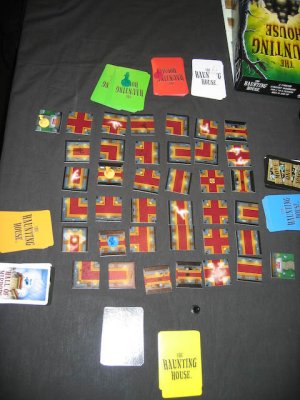 "So that concludes my final report from this convention. I thank you very much that you stay tuned. Thanks also to your many nice comments on the guestbook, this kept us staying awake. But now I have done my duty and will get some sleep until I begin to write the first reviews about the new games in the next weeks. So goodbye and see you next year again." However, with today being the final day, I have one more G@mebox co-author taking over for a review, and since the new ALDERAC ENTERTAINMENT GROUP game The Adventurers has arrived in Australia a few days ago, I would now like to hand the micro over to Doug Adams in Melbourne who wants to let you know his thoughts on the game. Doug, do you copy? ![[IMAGE]](advent1.jpg) "The Adventurers: The Temple of Chac is an exploration themed game that has just arrived here in Australia. I didn't know anything about the game until I saw my local game store posting that it was in stock. By the end of the day I had read the rulebook online and had played the game." "The theme of the game is a blend of Indiana Jones meets Lara Croft. A group of adventurers is entering an ancient temple, dedicated to the Mayan god Chac. The players are trying to lift as much treasure as they can from the temple, while avoiding the traps and pitfalls found inside. Escaping alive is nice too!" "The game makes a nice first impression. The game is packaged in a sturdy box, and is stuffed full of components. The box is a tiny bit larger, and deeper, than the standard Kosmos square boardgame box." "Inside the box, you get twelve very nice plastic miniatures, with a matching character card. The character art is done in a cartoon style, but I like the appearance. The characters are all generic, but each does have a single special ability. The miniatures are around an inch tall, and are unpainted. I have seen a photograph of a boxed set of painted miniatures for The Adventurers, and they do look nice."
![[IMAGE]](advent3.jpg) "There is a colourful game board depicting the temple. The eyes are immediately drawn to the three rooms in the temple. The Wall Room, the Lava Room, and the Underground River. Large squares regulate movement. A passageway winds it way through the temple, connecting up the various rooms. You get some solid plastic as well - a rickety bridge that comes with removable planks, two long stone wall pieces, and a large round boulder. You look at the boulder and Raiders Of The Lost Ark immediately springs to mind!"
![[IMAGE]](advent4.jpg) "There is also a sheet of counters to punch out - one side of the counters depicts a number represented in Mayan script, while the other side of the counter has a Mayan glyph. The glyphs are best described as some sort of complex doodle, and they have been drawn so that they are very similar to other glyphs. There are two sets of these number/glyph counters - one featuring golden numbers, one featuring black numbers." "Finally, the game comes with around 80 cards, broken into various decks. One deck is called the Wall Deck, while the rest of the decks are treasure decks for the different locations in the temple." "Setting up the game is straightforward. Golden treasure counters are laid glyph side up in the Lava Room and covered with a large masking tile so you can't see the layout. The black treasure counters are mixed up - four go into the Wall Room, while the rest go near the Lava Room. These black counters are number side up - i.e. opposite to the Lava Room counters. Why? Read on..." "The various card decks are shuffled up and place near their respective rooms. The plastic bridge, walls and boulder are placed on their starting positions in the dungeon, and the game is ready to begin." "Before the game commences, the players have to select their character, or rather, characters. Two character cards are dealt out to each of the players. Why two? Well, the rules cheerfully explain that your character has about six ways to meet a grisly end in the temple, and if that happens then you enter your second character. Great....! We'll break out Dungeonquest after this and have a really fun time!" "Characters each turn get a number of actions. Actions are awarded via a neat little mechanic called the load level, which is based on how much treasure the character is already carrying. Your character has a base load level of 2, but if you are carrying four treasures then your load level rises to 3. If you carry seven treasures, you load level is four, and so on. Each turn, one player will roll five D6 dice, and each player is given one action for each die result equal or higher than their own load level. For example, if I am carrying eight treasures I'll have a load level of 4. If the dice come up 1,3,3,6,6 then I get two actions, while somebody with a load level of 3 will get four actions. The bottom line is - if you carry more stuff, you'll get slower and slower. Slow isn't good..." "Players then take turns spending their actions granted for the turn. Some characters may have more actions than others. Actions are used for movement, or for special actions depending on what room the characters are currently in. Movement is simply moving to an orthoganally adjacent space, across a dashed line." "The Walls Room is the first room the party enters. The room is only four spaces long, however there is a pair of solid looking stone walls that are gradually closing together. Players have to get through here before the walls come together. This will take at most six turns, but it could happen sooner than that!" "Players can use their actions in the Walls Room for moving through the room, or searching for clues and treasure. There is tons of easy to be had treasure in the Walls Room - so players can linger and loot through the decks of treasure cards. For an action they simply take a card off the appropriate deck and add it to their stash. But... this has to be carried through the rest of the dungeon, and your load level may well be climbing." "Players can also search the Wall Room for clues. They may pick up one of the four black Mayan number counters and examine the glyph side of it for five seconds, trying to commit it to memory. These four counters in the Walls Room indicate which four floor tiles in the Lava Room are trapped. Memorizing the glyph in the Walls Room will give a player vital information about which tiles to avoid in the Lava Room." "Players will have to spend some time in the Corridor in order to get through the temple. But ... what's that rumbling noise behind you? Sure enough, a large round boulder has been activated and is beginning to trundle down the corridor. This boulder will gradually pick up speed as it moves through the corridor, and it means a sticky end for anyone caught in its path. Players have to keep a careful eye on the boulder, avoiding it when it's near them, and be out of the temple before it reaches the end of the path. This is because the boulder is also the game timer. When it reaches the end of the corridor, it wedges in the exit that the player's need to get out, sealing them inside forever." "Players may move across the Lava Room at their peril. The first player to move next to the Lava Room lifts the masking tile, revealing the 14 floor tiles and the confusing Mayan glyphs. Now... four of these tiles are trapped, and if a character moves onto a trapped tile, the tile crumbles underneath them and it's a quick bar-be-que by lava. We have the precioussss ... oops!" "When a Lava Room tile is entered, it's flipped over to reveal the Mayan number side. The number will either be present in the ten counters set near the board at the start of the game - safe; or it will be one of the four counters set up in the Walls Room - a trap. A trapped tile spells the end for that character, but a safe tile can be searched with an action - you take a Lava Room treasure card, and replace the yellow glyph tile with the corresponding black tile to show it's been looted." "You may be frowning and thinking it will be possible to memorise the Mayan numbers and match them up with the Mayan glyphs. Frankly, I think you will need to play this game a lot to be able to do this. The designers have used very similar glyphs, and the Mayan dot/dash number system to make it very difficult for casual players to break this aspect of the game. The glyphs have even been paired into almost identical patterns to make it even harder. The numbers used aren't sequential - we don't have 1, 2, 3 in Mayan, we have 12, 34, etc. Furthermore, the tiles can be set up in one of four orientations in the Lava Room, making it even more difficult. I'm not saying it's impossible to break the game, but it's close to impossible!" "Players who ignored the clues in the Walls Room may want to skip the Lava Room, or let someone else go first and lay out a safe path! The alternative to the Lava Room is to stick to the corridor, keeping a wary eye on the boulder. There is some nice treasure to be had in the corridor - five alcoves stuffed with valuable 4 and 6 treasures. To get at these treasures, players have to spend an action to roll a Yahtzee-like straight - this is called picking the lock. If they fail, they can use available actions to try and roll their missing numbers. These alcove treasures are sought after - they are some of the more valuable treasures in the game, and you know exactly where they are! The down side is you are taking the long way through the temple and the time pressure of the boulder may be a factor in deciding to go for them." "Once past the Lava Room, the exit is in sight. Adventurers have three options open to them - they can jump in the Underground River and swim for it, they can take the Ancient Bridge, or they can stick to the corridor and take the long way out." "Adventurers who want a bit more treasure may want to leap into the Underground River and swim around a bit. The river is eight spaces long, and seven of these spaces can be searched for treasure. Because of the current, each space can only be searched once before you're swept on downstream. At the end of the river is a deadly waterfall - players have to be strong enough to haul themselves out, or take the big plunge out of the game. The more treasure you're carrying, the harder it is to get out of the river." "Another option to get out is going over the Ancient Bridge. This is a rickety affair and you can almost smell the woodrot! Any player who tries to cross the bridge has to roll a die for each plank remaining in the bridge - if the roll is under the load limit, the plank gives way. If more than one player is on the bridge, you total the load levels - nice! Last plank goes, and so does the adventurer! Yes, the more treasure you've lugging out, the higher the chances are of the bridge giving way. The rules even allow for players to jump up and down on the bridge to try and smash some planks, making it more risky for following players!" "At the end of every turn, the walls and boulder may move on the board, and may trap some Adventurers. The walls move by flipping up cards from a deck - they'll show either blanks or one or both walls moving. The walls will have closed by the end of the sixth turn, but it may happen sooner." "The boulder trundles on throughout the game. Players begin rolling a die at the end of the first turn, then 2 dice on the second turn, and so on until it picks up speed to its maximum of 5 dice. For every roll higher than a 2, the boulder moves a space. Given the game ends when the boulder plugs the exit space, average dice will see a game last around 12 or 13 turns. Adventurers obviously have to avoid being run down by the boulder, but ideally they'd like to stay ahead of it too!" "The adventurers escape via the only exit on the board, before the boulder plugs the gap. If a player had an adventurer perish in the temple due to walls, boulder, lava, waterfall, bridge, etc!, then they may enter their second character on one of two spaces next to the Lava Room. The only proviso is the boulder has had to have passed, immediately putting that character under time pressure. The player who escaped their adventurer with the most treasure wins the game. To provide a thrilling finish, some players may exit with casket treasures, and have to roll a die to see what value it contains."
![[IMAGE]](advent9.jpg) "The Adventurers is a simple game - don't let the 16 page rulebook put you off. The rules are very simple to understand, and I can see this game being enjoyed by older children and families. It's not a resource heavy gamer's game. It is much more pitched as a light hearted adventure game, and based on that it succeeds very well." "This is not to say it's too simple - there are some strategies to explore. Each adventurer has one of six skills. Swimming makes the river safer; lockpicking grants easier access to the alcoves; leap and sprint give movement bonuses; stamina means you can carry more treasure; linguistics means you can speak ancient Mayan and see where the traps are in the Lava Room. You can steer your character through the temple based on your skills." "I've already seen some different games - three players went off to loot the alcoves, using speed to get there first, or lockpicking to ensure they got some treasure. One of my characters, that wonderful swimmer Puccio Cortese, hung around the Wall Room and made sure I memorised the Lava Room clues. I had to look at a couple of them twice to be sure. The others had bolted down the corridor to the alcoves, so I whipped into the Lava Room just ahead of the boulder and had fun there. Late in the game I jumped in the river while the others took the long (and safe!) way around the corridor. There are different things to try here, if the time pressure of the boulder and walls allow it." "I like The Adventurers. It's fast, taking about an hour to play. It is easy to teach, has great crossover appeal, and tells a good story. There will be laughs and groans at the table as it's played out. I'm not quite sure how much replayability there is to the game - it's not a game I'd be aching to play a lot of, but certainly fun to break out once a month or so. " "A fun adventure game for friends and family, or for game groups wanting something lighter. Very good." Returning from Australia to a final time into the halls of the SPIEL 09, I wanted to start the afternoon with something light, and remembering that Jussi Autio from TUONELA had brought several interesting looking cardgames with him to the SPIEL I decided to begin my afternoon playtesting there. Arriving at the booth, I saw that TUONELA had done quite well during the show, since their cardgame Inquisitio actually was sold out. The game I wanted to have a look at was Soul Hunters, and I was quickly drawn in the mystical business of acquiring poor human souls. At the beginning of the game a deck of soul cards is shuffled, with their number depending on the number of participating players. Five of these soul cards are revealed, and since a soul is a human's most valuable possession the player who will control most souls by the end of the game will be declared to be the ruler of all. The revealed soul cards are arranged in ascending order, and each of the players will try to use soul hunter cards of different alignments to take possession of the souls. 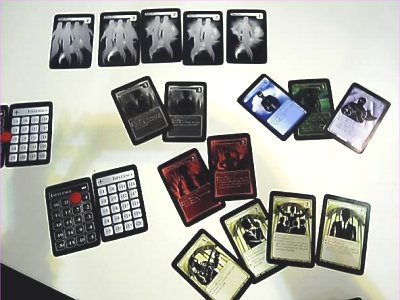 All a player possesses at the beginning of the game is a track on which positive or negative influence is recorded, but for playing reasons it is not important whether influence is positive or negative since during an evaluation it will be the player with the highest numeric value who will receive a soul. Thus, the plus or minus is left aside, since it just represents whether a player will use the forces of darkness or light to lure a soul into his possession. As indicated, the soul hunters belong to six different alignments, and whereas Heaven, Government and Monarchy all stand for the forces of light, Hell, the Cult and Aliens stand for the darker side in the game. During his turn, a player is allowed to draw one card from the soul hunter deck, and afterwards he may play one card from his hand and use one of the cards which he had placed in front of him on the table. Most commonly found in this deck of cards are the soul hunters, and once they are placed on the table it is their foremost function to generate either positive or negative influence points for the player. The nature of the influence points (positive or negative) just represents whether a soul hunter belongs to the light or darkness faction, and the player will note the influence he has generated on his track. A player actually is not required to stick to soul hunter cards of just one alignment in his display, but it is generally helpful to stick to cards of one alignment if the hand of cards available to the player allows it, since this allows the player to generate bonus points of influence. However, in the generation of influence or the using of a soul hunter's special power takes up one of a soul hunter's limited number of uses, and to represent that the card has been used it is turned 90 degrees clockwise. If it has even more uses, it is turned again whenever it has been used, and the soul hunter finally will be discarded if he has no uses left. To keep track of time progressing in the game, one soul card is turned for 90 degrees after all players had taken a turn. When all soul cards on the table has been turned, an evaluation takes place and the lowest available soul will be collected by the player with the highest numeric influence value. The player must reset his influence to zero, giving other participants a headstart when competing for the next soul, but he gets to keep the soul card as victory points. The mechanism of turning souls to measure when the next evaluation takes place results in the fact that the number of turns between the evaluations is reduced by one after each evaluation since the soul cards are not instantly replaced but only when the whole display of soul cards has been played through. However, with three or less souls available the number of turns between the evaluations remains at three in order to give players a chance to catch up again. So far the game would have been pretty dependent on the drawing luck of each player, but an interesting playing depth comes into the game both though event cards included in the soul hunter deck and soul hunter special abilities. Such cards or abilities may be used to generate negative effects for other players, or they might help in getting new cards or offer other kind of advantageous action. If played in good succession, a player can generate nice effects through clever card combinations, and this in turn will generate a good harvest of souls. The use of these events and abilities also guarantees quite a bit of player interaction in the game, but this also serves to keep the competitive spirit of all players high. To my mind especially the decreasing number of rounds between the evaluations and the fact that all souls have been arranged in an ascending order have been clever ideas to create a rising level of tension, since player will try to position themselves in a way as to have many influence available when the higher souls are available. This means that the players sometimes will refrain from taking an earlier soul, but here the risks must be assessed since soul hunter cards on the table can be lost, whereas soul hunters kept on a player's hand first must be placed on the table before they are of any use. Overall, Soul Hunters is quick and fun to play, and it offers a refreshingly new topic which is implemented quite well. After seeing Modern Times shortly ahead of the SPIEL 09, this new cardgame now is another nice add to their growing choice of interesting cardgames. 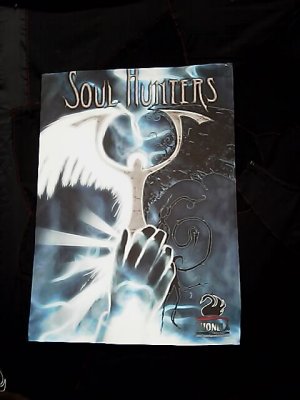 I wanted to present you two more games for today, but before I actually arrived at my next destination I took a short detour through hall 6 where the mystical world of the Life-Action Roleplayers is located. My roleplaying days are long behind me, but nonetheless it is quite fascinating to look at the costumed people and all the different kinds of fantasy good available here. These items range from armour and padded swords to medieval fashioned beverages, and everything is purchased by people running around in their roleplaying outfits. Thus, I met sinister Inquisitors, punk-like Shadowrunners and a lovely Startrooper-Lady in a leather jumpsuit carrying a huge gun, and I marvelled at the care and detail which some of these people put into their costumes. 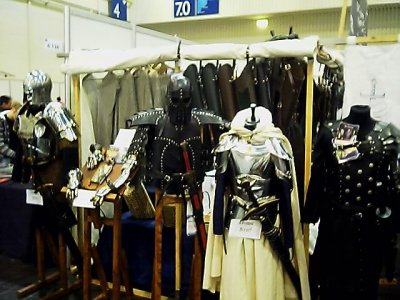 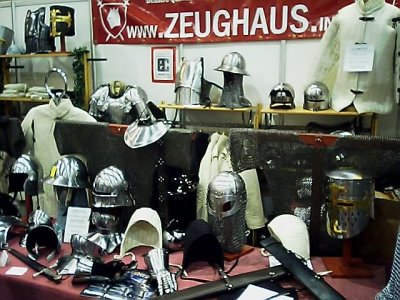 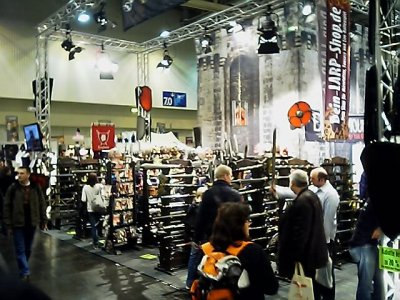 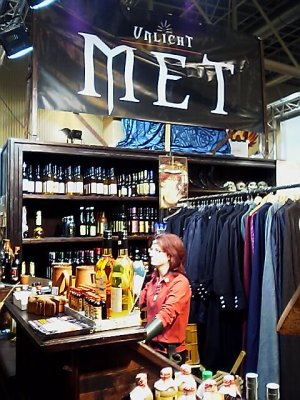 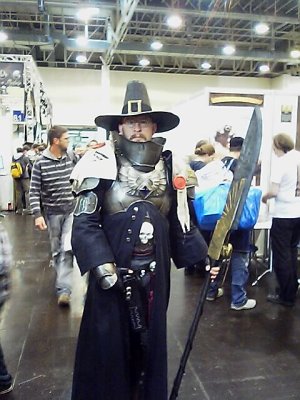 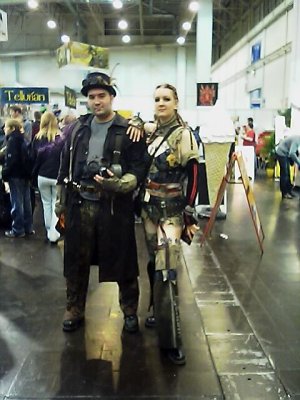 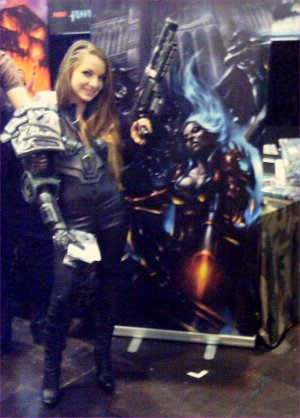 Leaving the hall with this rather extravagant hobby behind, I returned back to the solid world of boardgaming, and here comes the report on one game which I was really looking forwards to get a chance to play… In recent years meeples in placement games had a quite exciting life, and so they could build a cathedral at Kingsbridge, a castle at Caylus or even a Stone-age village. This year they have decided to cross the great Altlantic Ocean, and now they have arrived as cowboys in the Wild West, helping the players to construct the town of Carson City. With the still lasting boom of worker placement games as an ideal background, author Xavier Georges has convinced QUINED WHITE GOBLIN not only to publish his new game, but actually QWG has added a special edition of the game to their limited book-case series, making it the fifth game in the circle. 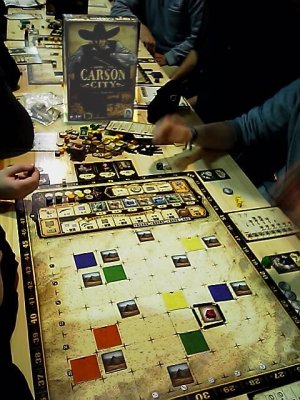 Turning towards the gameboard, the players find themselves in command of a group of cowboys who have just arrived at a peaceful patch of land where somebody has erected a house and gave this shack the spectacular name "Carson City". Seeing the potential of the surrounding area with green rangelands and some mountains full of precious metals, the players have decided to stay in order to play a part in the development of the city. Thus, the main part of the gameboard shows a grid of 8 times 8 parcels, with a few of them containing mountains and one of them containing a house-tile which has been surrounded on all four sides with roads. The whole initial setup was decided by the roll of dice so that the players will find a different setup with every game, and the gameboard even offers a backside featuring a river which can be used by advanced players. Among some coloured property tiles which are used for marking parcels acquired by the players, the players themselves receive three cowboys, one road and $15 as basic equipment. As final preparation, a line of seven character cards is placed next to the gameboard, and some building tiles and a "3 Guns" markers are placed on the snakelike action track on the gameboard. The game runs for a total duration of four rounds, and in every round the players will determine their actions by placing their cowboy figures either at a parcel on the gameboard or at a space on the action track. The functioning of the action track is somewhat similar to the progression of a turn in Caylus, with every space of the action track being associated with a certain kind of action or benefit for the player who successfully placed a cowboy there. However, the Wild West always has been dangerous, and so Carson City actually allows more than one player to place a cowboy at the same space. When the actions will be performed, all spaces containing two or more cowboys will see a duel, with each player determining his firepower by adding up his gun markers and the unused cowboys still in his personal stockpile. In addition, a dice is rolled and added to each player's firepower. The player with the highest result wins the duel and is allowed to use the action associated with the particular space, whereas the looser(s) take his cowboy back into his personal stockpile, loosing the action but having a slight bonus in additional duels in the same round due to the returned cowboy. As you can see, Carson City is much more confrontative than other worker placement games due to the possibility to compete for the use of a desired action or parcel. The duels certainly introduce a luck factor which is somewhat unusual to this kind of games, but on the other hand they are an attractive solution to offer some uncertainty and instability which offers the players ample room for speculation and for waging risks. Turning to the action track, the first four spaces of the track create some additional income to the players in form of money and roads, and one of the spaces allows the gaining of the "3 Guns" marker which will increase the firepower of the player who wins this action for the rest of the round. The map on the gameboard becomes involved with the parcel purchase space. No cowboys have been placed there, but instead the players will look at the parcels containing cowboy figures. After duels have been determined, the players with a cowboy left at a yet owner-free parcel is allowed to purchase it and to place one of his property tiles there. The parcel price is increased for every neighbouring parcel containing a building or a mountain since these features have an influence on the income which can be generated on the acquired parcel. To generate income, the players must own appropriate buildings, and so the following spaces on the action track offer an assortment of randomly drawn building markers for purchase. If a player successfully purchases a building, he may either keep it in his personal stockpile or - usually the better option - he may instantly place it onto one of his parcels on the map. Here the precondition must be met that the parcel on which the building is constructed must be adjacent to a road, and so a player first is allowed to place one or more of the roads in his personal stockpile to extend the ring-road which was placed around the first house tile on the gameboard. Most of the buildings will draw additional inhabitants to the town, and so the players are required to place an additional free house tile anywhere on the gameboard (provided the parcel can be reached by a road and does not contain a building, a house or a mountain). The action phase then continues with some spaces generating a basic income for each parcel and for each point of firepower a player possesses, plus an additional gambling option which creates a variable income. However, in terms of income the space for estate income is most important, since once again no cowboys were allowed on that space, but instead all buildings on the gameboard are evaluated and create income for their respective owners. Now the features on the eight spaces surrounding a building are of real importance, since the income of a building gets higher with every matching feature in the area. Thus, a Ranch profits from empty rangelands, a Mine from mountains or a Saloon from houses, but the players also need to observe some special rules which are associated with some of the buildings. Thus, the Mine, the Ranch and the Prison generate additional firepower for their owner, or the Hotel counts for two houses when evaluating adjacent buildings. Jealous players actually may try to participate in another player profits by sending one of their cowboys into a building to steal half of its income, but here an adjacent church protects a player's buildings from such an attack. The Drugstore and the Bank finish the choice of available buildings, and both of these profit both from houses and Ranches / Mines on adjacent spaces. The final spaces on the action track are associated with the generation of victory points, and here victory points may be gained for parcels, buildings or firepower and they even can be purchased for money. However, once again it must be kept in mind that such an action only will be performed by the player who successfully has placed a cowboy there, and so there is no automatic generation of victory points in the course of the game, and even though some final points are distributed for the player's possessions at the end of the game everybody will need to keep an eye on the fact that they need to generate enough victory points during the four rounds of play. At the end of a round buildings which were not purchased will get cheaper and the players get some of their cowboys back. However, I have not yet explained the use of the seven character cards which were placed next to the gameboard, and their distribution each round depends on the players' order, which in turn depends on the placement of the cowboys. Thus, a player gets a better rank in the players' order the sooner he finishes placing his cowboys, and apart from retaining more cowboys in a personal stockpile to generate firepower this also means an early choice of a character card at the beginning of the next turn. Each of the seven characters gives the players as special action for the ongoing round, and so the Sheriff means an additional cowboy-figure which cannot be challenged to a duel, the Settler allows the taking of an owner-free parcel, the Captain recruits additional cowboys and the Mercenary increases a player's firepower. Some money is received if a player choses the Banker, roads and a rebate on building purchases is provided by the Chinese Coolie and the Grocer doubles the income of one of the player's building types. To my mind Xavier Georges succeeded rather well in finetuning the different options available to the players in Carson City, and on first playtesting I could see no single winning strategy but the players can try different ways to win. Much depends on the individual layout of the gameboard and the choice of available buildings each round so that the players will be faced with a new constellation in every game, and to add even more variety not only the river-variant on the backside of the gameboard was provided, but in addition several other optional rules have been included. Thus, each character has a second side listing a different attribute, and the game also includes duel tiles which can be used instead of a dice to make duels more deterministic. The also included "Kit Carson" variant is very demanding, since in this variant the players are allowed to act simultaneously in the cowboy placement phase. Each player is allowed to move his cowboys freely on the gameboard until he declares that his placement is over and takes his place on the players' order. Although this might sound quite chaotic, the challenge is even higher because players now have a chance to react to other player's placements, possibly avoiding duels by chosing other less popular spaces. However, the pressure in this variant is immense due to the reward of a good positioning on the players' order if a player finishes early, and so hectic situations are alternating with phases in which everybody waits and sees. With all these special turns and twists the game outclasses similar looking games like Oregon which was released by HANS IM GLÜCK in 2007. Most remarkable for me is the fact that Carson City not only successfully integrates an element of luck and risk taking which I am missing in some other worker placement games, but instead the author actually includes enough variant materials to suit the taste of different gaming groups. Thus, the duel tiles make the game more strategic by removing the dice, and the "Kit Carson" variant actually adds some direct interaction on the player level. Overall, Carson City for me is one of the highlights of the SPIEL 09, and I keep my fingers crossed that perhaps some kind of expansion like a Railroad or additional characters will be sent into the West! 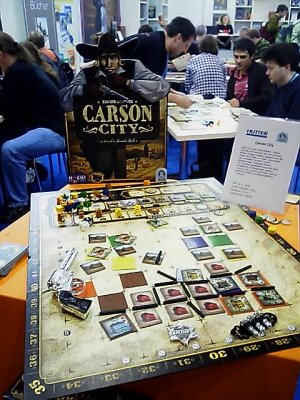 Talking about meeples also brings me to my final game review from the SPIEL 09, since the origin of the name of these wooden game pieces always has left me figuring where this word actually first appeared. As far as I remember, I heard it first in reference to the small figures used as playing pieces in Carcassonne, and indeed the website wiktionary.com lists Alison Hansel as the person who has first used "meeple" as a fusion of "my" and "people" in a game of Carcassonne. However, this year the Lamont Brothers of FRAGOR GAMES actually have developed the word even further, and so their new ostrich-racing game Savannah Tails actually uses the world's first "Meep-meep-meeples". Roadrunner would be proud of this! I couldn't keep a smile from my face after I stumbled over this pun while scanning through the rules after the day at the SPIEL, and I guess that Fraser and Gordon Lamont just intended this to happen. As a matter of fact, Savannah Tails is a game which should be played with a wink and in good humor, since the game is rather fast paced and allows players a rather speedy performance of their turns. Thus, although the game's title bears some semblance to last year's Snow Tails, the strategic impact of Savannah Tails is lower in order to increase playing speed even more. The game is prepared by setting out a winding path of Savannah boards which show four different coloured lanes of ostrich tracks. The lanes are continued from board to board, and each of the players will use his own set of ostrich cards to move his cute wooden ostrich along the path. The movement of the ostriches is fairly easy, with each player possessing a hand of four movement cards of which one card is played to move the ostrich each turn. The movement cards show both a colour and a number, and while the number represents the number of spaces which the ostrich must move forwards, and the colour represents the lane of tracks on which the ostrich must end his movement. Some details are given regarding the facts that an ostrich may not move through an occupied space and that lane changes only may be made towards the lane on which the movement must end, but otherwise movement is as easy as it sounds. Following the current ranking in the race, each player plays one of his cards, moves his ostrich and draws a new card to end his turn. But hey, this would not be a FRAGOR game if the rules would stop here, and so the path actually brings up some difficult boards which the unsuspecting ostriches have to face. Thus, a rope bridge narrows the path's width down to one lane, with this bottleneck causing some crushes, whereas the dune may either throw an ostrich backwards or give additional momentum, depending on the fact whether an ostrich succeeds in getting over the top. Quicksand spaces will slow an ostrich down, and different kinds of animals may cause all kinds of troubles. Thus, a space with a porcupine means a painful instant ending for an ostrich's movement, a warthog causes chaos forcing the player to draw a new hand of movement cards, and a cheetah actually steals one of the ostrich's bonus cards. 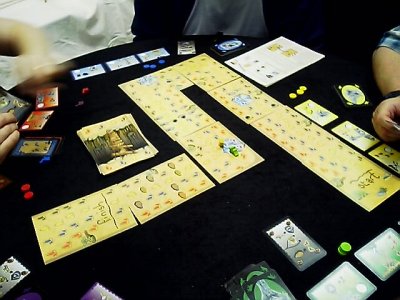 Talking about bonus cards, six different kinds of bonus attributes exist of which three must be chosen for a game. Each player receives an identical set of three bonus cards listing the chosen attributes, and whenever a player's ostrich passes through a waterhole on its way through the hot Savannah the player may place a token on one of the attributes to represent the boost provided by the refreshing water. An attribute which has been activated this way may be used once before it must be activated again, and the available attributes range from a "Neck Stretch" which offers two extra spaces for movement to a "Leapfrog" used for jumping other ostriches or even a "Bird Brain" which permanently increases the players hand of movement cards to five. These attributes may be used for enhancing an ostrich's position in the race, but more often the players will be tempted to keep attributes like "Neck Strech" right till the end in order to gain a possible advantage while going for the finish. To prevent an ostrich's race to go awry from bad luck while drawing cards, further rules have been introduced concerning the value "2" racing cards so that an ostrich who makes such a slow, sneaky movement may pass any dangers and difficulties unharmed. Likewise, any card may be discarded for a one-step movement into any direction to help a player stay in the race and to get rid of an unwanted card. On first glance Savannah Tails seems to be a simple racing game which may not appeal to seasoned gamers, but when you give the game a try you will discover that there is more to the game than expected. While it is true that the hilarious ostrich race first and foremost is a fun game, Gordon and Fraser actually succeeded in creating a light-footed race atmosphere while at the same time introducing some challenges through different kinds of hazards. It may be countered here that the idea for hazards in a racing game is not new, and some first hand similarities with Snow Tails actually might suggest that Savannah Tails possibly is built on rules which were discussed in the development of the former game. However, I have rarely seen a racing game which gears up as fast as Savannah Tails, and so the real merit of the game lies in keeping its entertainment value without drifting fully into the area of Beer'n Prezels games. Only one thing is necessary to enjoy the game at its best, and this is a full cast of five ostriches in the competition. The lanes get much more crowded with an increasing number of participants, and this in turn creates difficulties and blocking possibilities from which the game draws much of its player interaction. GO MATHILDA !!! (there isn't a braver ostrich racer to be found) 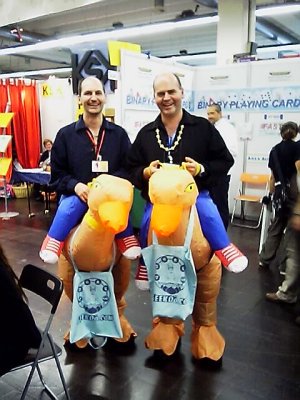 Well, and here we are, right at the end of the SPIEL 09. It has been some great days for me, meeting lots of friends and playing a rather interesting and varying choice of new games. At this point I would also like to say "THANK YOU!" for all those great commentaries you have left in my guestbook - this really makes the whole thing worthwhile! I know that there are still some other rather interesting new games which I had not covered, and amongst these certainly is Dungeon Lords from CZECH GAMES EDITION. However, this is because I could not study the rules ahead of the show, and so I will publish a full review soon. However, one - no, THREE - things are actually missing. The first is the fifth and last card for my Nobles & Townspeople expansion for Dominion. I am going to put all these cards into a complete pdf-file in a couple of days. 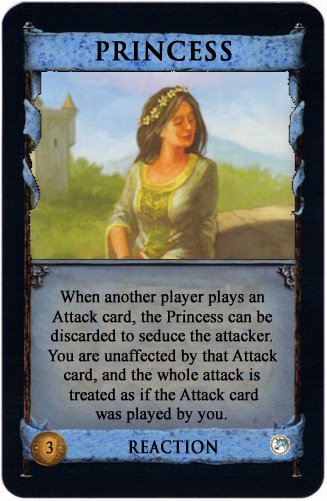 Concerning the Prize Draw, all winners will be published here soon. However, you can still participate by signing my SPIEL Guestbook ! Please note that I am going to keep the Prize Draw open until Friday the 30th of October, and the winners will be displayed here at the following weekend! But let me add one thought: I guess that a winner of one of the Essen-goodies bundles possibly will not have all of the games for which the goodies are included, and so I would like to ask the winners not to put these items up on Ebay but to trade them in for something game related. Boardgamegeek.com is a great resource to find trading partners, and to my mind this would actually honour the spirit in which these items were sponsored. Kulkmann's Convention Hit 2009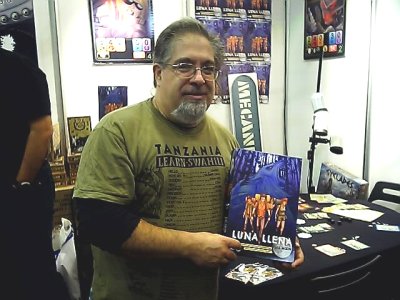 Finally, I would like to let you know about my favourite game of the show, and this was Full Moon of Servando Carballar. Certainly my liking of adventure games has influenced this decision, but I really liked the way the game developed and the tension which was gradually rising. A game with such an authentic playing atmosphere and well-constructed rules is hard to find, and I would like to honour this work by my special recommendation. Close after Full Moon comes Cyclades, but if you examine the image above you will find that it is actually present there as well. And now, we finally reach the real end of the SPIEL 09 and my coverage. Thanks for staying with me for such a long time. This report has gotten longer than ever with the help of my co-authors Ralf and Doug, but I hope you found this virtual walkthrough of the SPIEL 09 useful and entertaining. I hope to see you all back for the SPIEL in 2010, but for the moment I better go and get some sleep! Frank Schulte Kulkmann from Essen, Germany 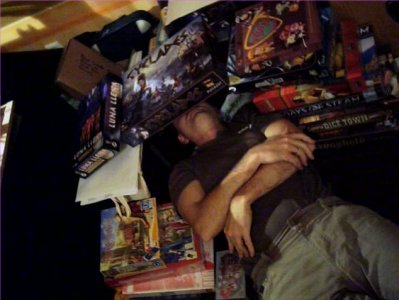 Opening timesFrom thursday to saturday the convention is opened from 10 AM until 7 PM, on sunday from 10 AM to 6 PM. Travelling to the Messe EssenIf you arrive at Düsseldorf International Airport, it takes about 20 minutes to get to the Messe Essen by Cab. If you hire a car at Düsseldorf Airport, you go onto Autobahn A44 (blue signs), and at the next motorway crossing you go over to A52, direction Essen. Take Exit "Essen Rüttenscheid". You can also go by train to Essen Central Station. If arriving there, go to the basement and take the Subway U11 directly to the Messe Essen. If you want to arrange lodging at Essen, you best contact the Essen-tourism-center by phone 0049/(0)201/19433 or 0049/(0)201/88720-46 or -48. Perhaps they know where some Hotel-rooms are left... If you travel to Essen by car, please notice that Germany restricts access to many cities (including Essen) for older cars. While the convention area does not fall under these environmental restrictions if you follow a specific route, you might want to check out the route details at the official Messe Essen website. An even better alternative (especially for those of you having a hotel in Essen) would be the acquiring of an Envirnomental Badge which can be ordered at the offical website of the German Technical Inspection Authority. If you want to have a look at my coverage of previous conventions, follow these links. But you should bring along some time, especially of you want to read the younger reports...
|
|
| |

Looking for the new games? Visit Funagain Games! |
|
|
| |
|
Kulkmann@aol.com
Copyright © 2009 Frank Schulte-Kulkmann, Essen, Germany | |